How I used ChatGPT-o3 to plan an entire marketing campaign during one plane ride
In an hour, ChatGPT-o3 can make you dozens of high-level marketing graphics — the kinds of campaigns that would take some teams weeks to complete. And the graphics aren’t just a first draft starting point. They’re final assets ready to run. I tested this out […]
MarketingThis behavioral science principle can make your billboard go viral, here’s how
Is billboard advertising still relevant today? Yes, all because of costly signaling. This behavioral science principle states that expensive signals indicate higher quality or status. Although a broader concept about human behavior, costly signaling absolutely applies to advertising. What, after all, is the value of […]
Marketing30 creative lead generation ideas to try (& why marketers recommend them)
Coming up with strong lead generation ideas isn’t always easy. I’ve found myself putting it off more than once — not because it’s not important, but because it often feels like a hit-or-miss. And I’m not alone. In the last year, 45% of businesses reported […]
Marketing



20 best B2B lead generation tools
There’s no way around it — every business needs to drive leads to grow. However, B2B lead generation is far from a simple task. You are competing with other businesses, navigating misinformation, and playing trial and error with various tools. Not to mention, you also […]
MarketingThere’s no way around it — every business needs to drive leads to grow.
However, B2B lead generation is far from a simple task.
You are competing with other businesses, navigating misinformation, and playing trial and error with various tools. Not to mention, you also might be selling a product that’s more expensive or requires a hire subscription fee than many B2C offerings.
Though a complex task, having the right B2B lead generation tools can simplify and speed up the process of lead generation.
Table of Contents
- What is B2B lead generation?
- Why You Need B2B Lead Generation Tools
- Best B2B Lead Generation Tools
- How to Choose Winning B2B Lead Generation Tools
While a B2B lead is made when anyone shares name and contact information that enables you to identify and follow up with them, a quality lead is one that signals intent about product interest by providing other useful information and engaging further with your business. Qualified lead information varies and is harder to get. But, it generally includes name, occupation, and email address.
Ultimately, the goal of B2B lead generation is to create a consistent pipeline of qualified leads who are likely to convert into customers.
Why You Need B2B Lead Generation Tools
Trying to generate B2B leads without tools is like showing up to a sword fight without a sword — you will not be equipped with the tools you need to achieve your goal.
Because it is distinct from B2C lead generation, B2B lead generation requires a different set of strategies. B2B lead generation software is critical for any business wanting to get high quality leads from the right places. These tools can automate processes which saves time, provide critical data to help you make better decisions, and integrate with other tools like CRMs.
Best B2B Lead Generation Tools
1. HubSpot Marketing Hub

HubSpot Marketing Hub is a suite of tools that aim to help marketers funnel leads through the attract, engage, and delight stages of the marketing flywheel.
For example, you can use Marketing Hub to create compelling content to attract your target audience, capture leads via site, email, or social media; and nurture tools like automated workflows that can continue to engage contacts via email and other types of messaging.
What I like best about using HubSpot is how simple it is to create everything from landing pages to forms to email nurture campaigns. From templates to built-in guidance, HubSpot makes it easy to create lead generation campaigns from scratch.
I don’t consider myself design-savvy, but I can easily put together a professional-looking landing page that’s designed to convert.
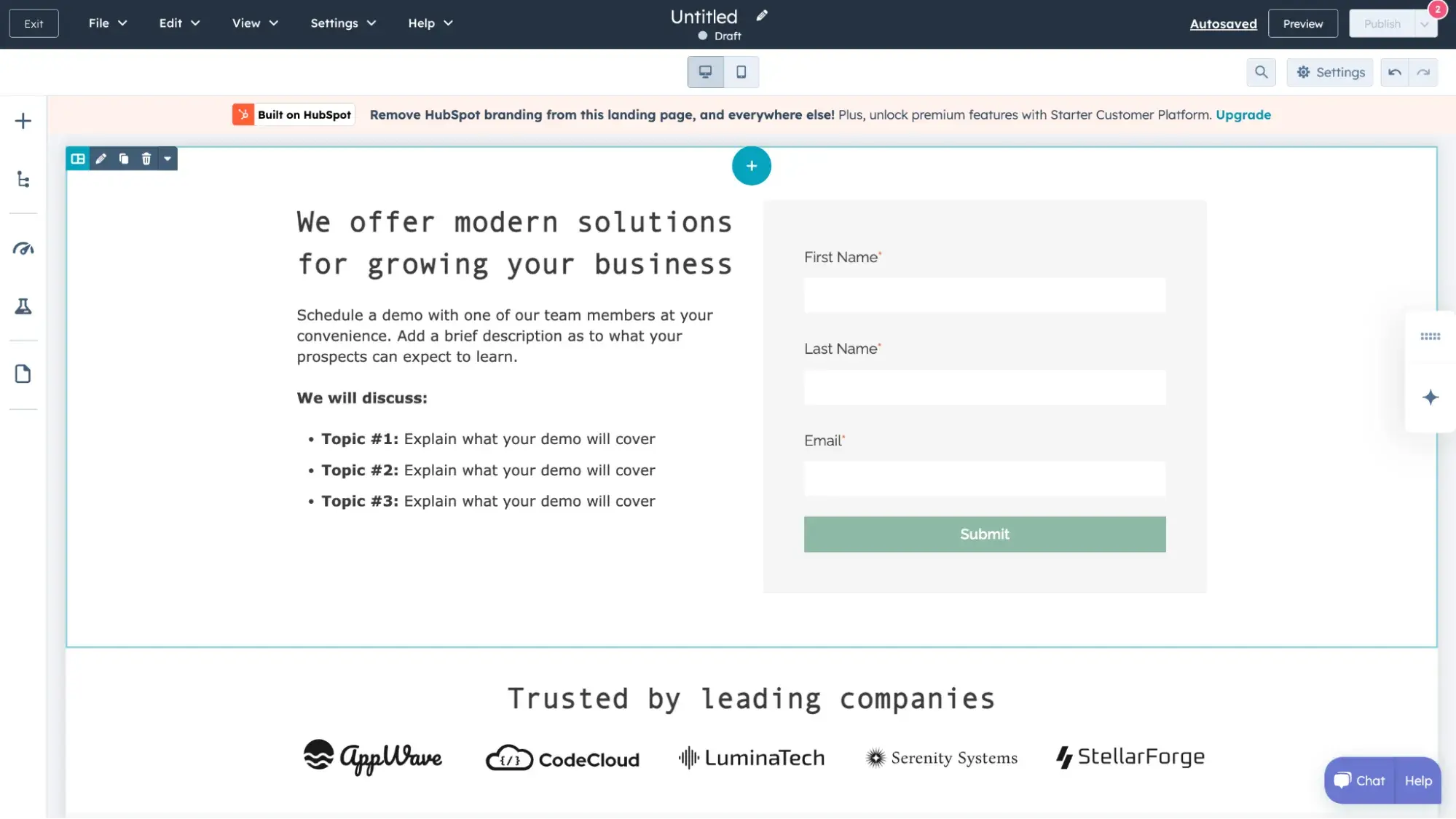
Features: HubSpot Marketing Hub has multiple features designed for lead generation, including a lead capture tool. It is also equipped with forms, pop-up forms, live chat, and chatbot.
What I like: HubSpot Marketing Hub integrates with HubSpot CRM, making it easy to connect all of your lead generation tools in one place.
Pricing: Paid tiers run from $15 to $3,600 per month depending on company size.
2. LeadPages
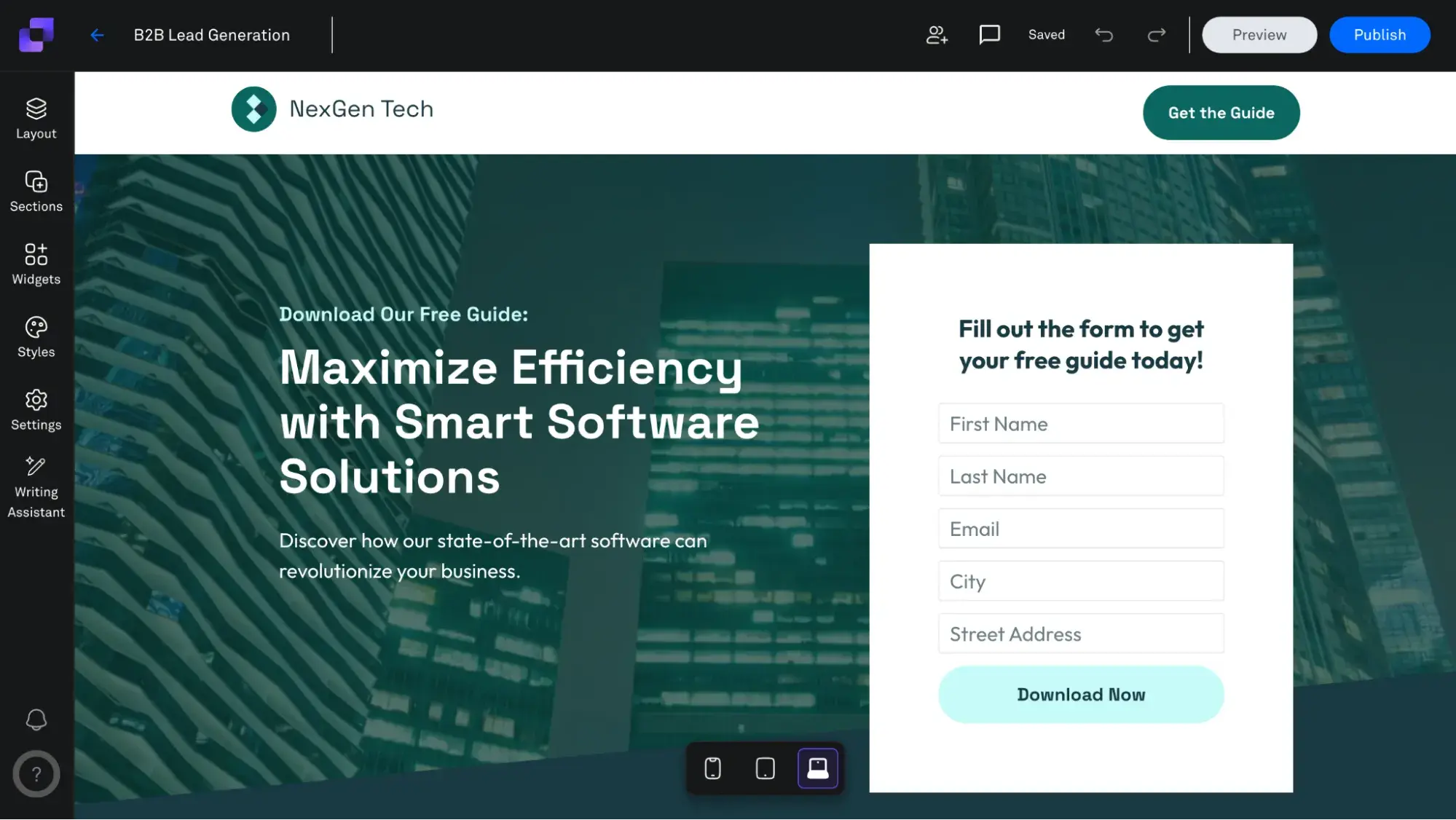
LeadPages is a landing page tool that enables you to create custom landing pages for different, specific audiences. Each page is highly optimized for conversions whether your goal is to capture leads, run a giveaway, or offer a free download.
Using a landing page builder is an effective way to start generating leads without setting up a new website or a full-fledged lead generation system. You don’t even need your own domain which is helpful for startup businesses that are using a landing page to generate leads before launching.
LeadPages also integrates with other software, funneling leads into your CRM.
Features: Build websites, landing pages, pop-ups, alert bars, and more.
What I like: There are over 250 landing page templates categorized by industry, page type, and style. The high level of customization and range of template designs makes it easy to find what you’re looking for right away.
Pricing: LeadPages offers a 14-day free trial. Paid plans start at $37/month and go up to $697/month depending on how many landing pages you plan to build.
3. Leadfeeder
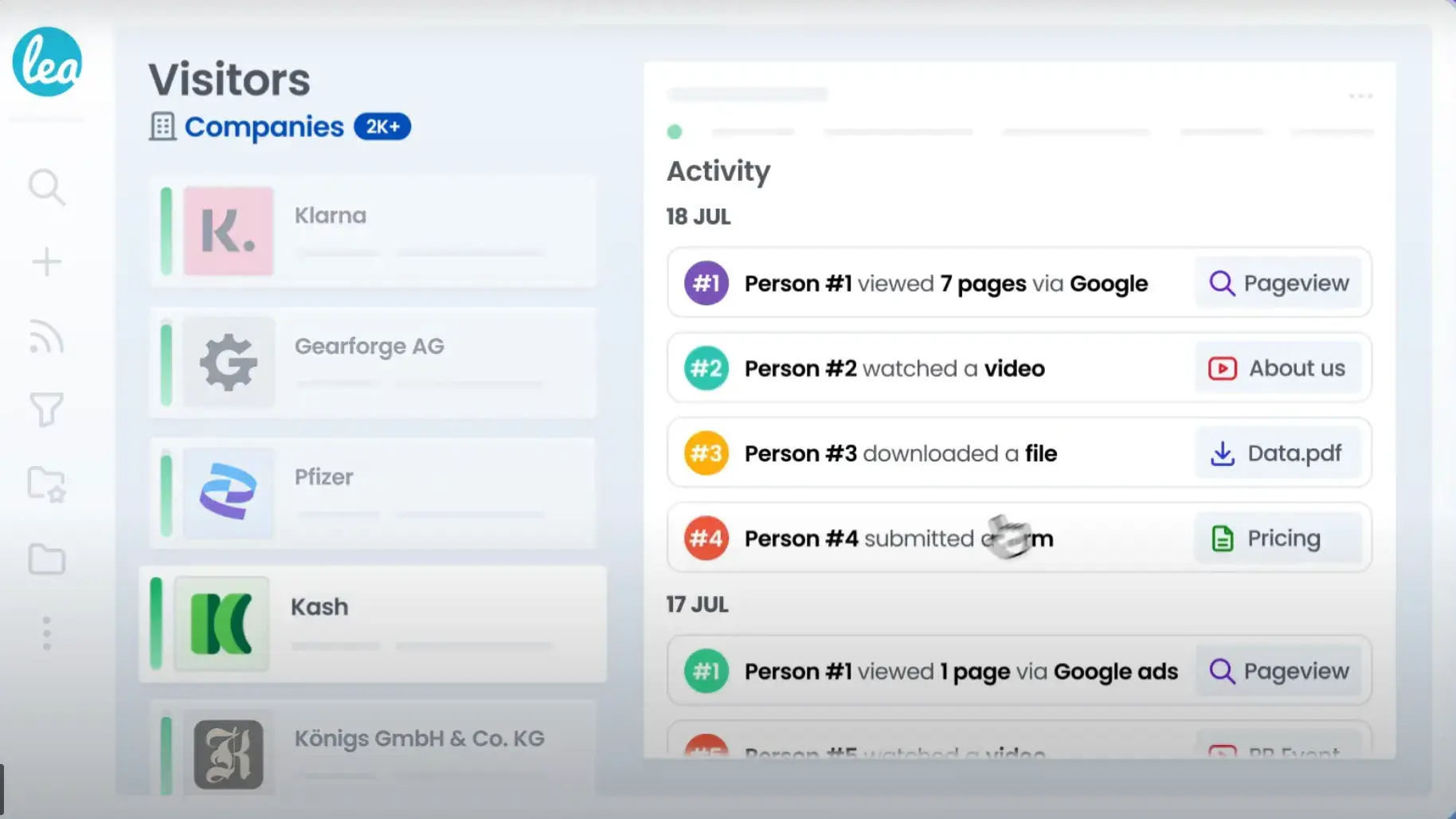
You may get qualified leads visiting your website, but if they don’t fill out a form then you won’t be able to capture the lead. Enter: Leadfeeder. The sales and marketing tool captures data from website visitors, even if the site visitors don’t fill out a form or contact you, turning anonymous traffic into potential leads.
Leadfeeder uses its machine learning algorithm combined with proprietary data, millions of external signals, and public IP registration databases to accurately curate a list of leads. Not only does it gather contact information, but it also lets you know which pages users visited and how long they spent on your site.
Features: Features include automatic lead scoring, automatic list scrubbing (to filter bots), instant lead generation with their tracker, personal email alerts, and CRM automation.
What I like: Leadfeeder has custom segmentation features to help you identify high quality leads. I also like that it integrates with other sales and marketing tools like HubSpot.
Pricing: The Free Plan includes unlimited users, but you can only receive data from the last seven days. Paid plans start at $99 per month.
4. OptinMonster

OptinMonster is a great tool for building opt-in forms on your website. Whether you want to set up a retargeting campaign or promotional campaign, OptinMonster makes it easy to create all types of forms and popups on your website.
One of the features I like best is the lead sharing. After you’ve captured qualified leads from the popups you’ve set up, the lead sharing tool automatically distributes those leads in real-time. In my experience, this is a great way for marketing and sales to sync their efforts.
Features: Premade opt-in forms like lightbox pop-ups, fullscreen takeovers, floating bars, and slide-ins.
What I like: There are over 700 templates to choose from categorized by goal, campaign type, industry, and features.
Pricing: Prices start at $7/month for Basic (one website). $19/month for the Plus Plan (two sites), $29/month for three sites, or $49/month for up to five sites.
5. LinkedIn Sales Navigator
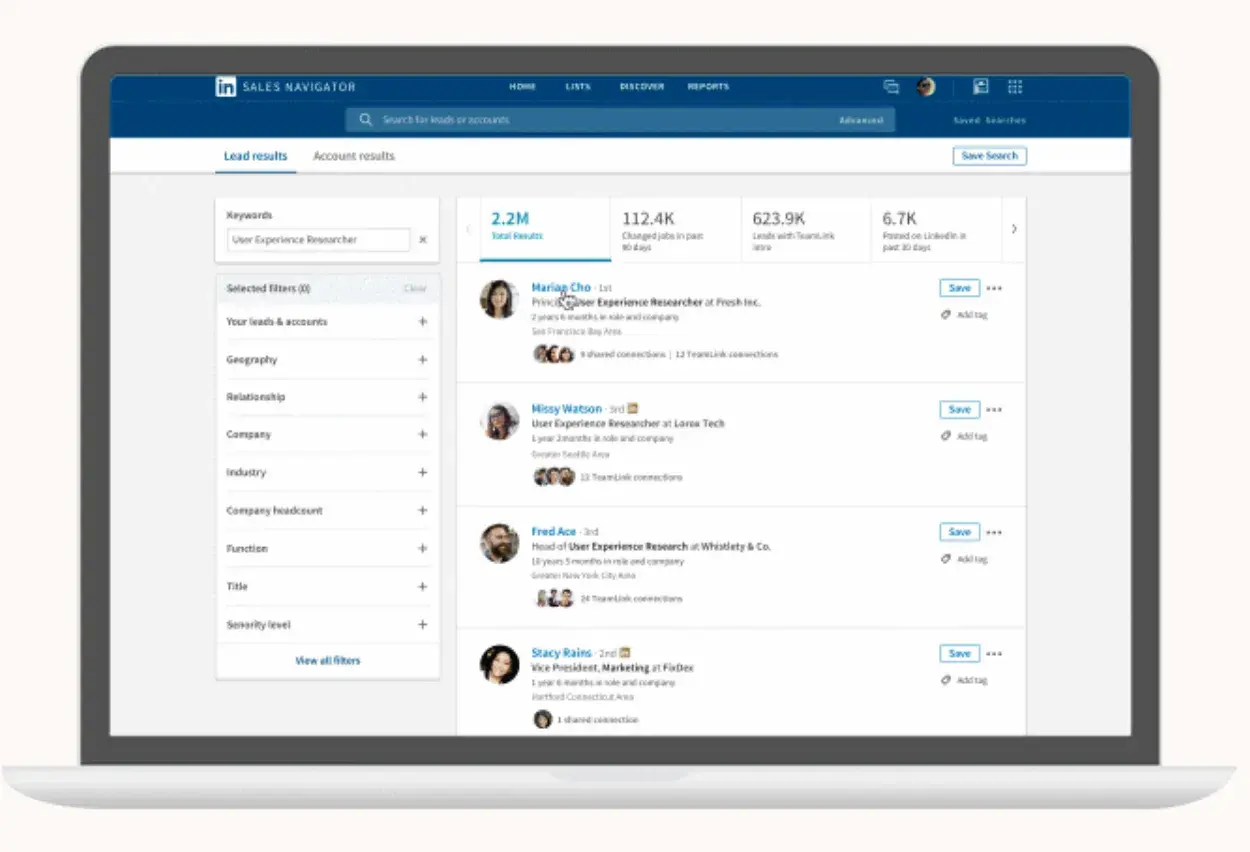
LinkedIn is known as a platform to connect with B2B audiences. Its Sales Navigator tool can help sales teams identify decision makers and target specific prospects with advanced search capabilities. It can also help track leads and engage with potential buyers with InMail Messages and TeamLink.
Features: Lead and company search tools, automated lead recommendations, and CRM integration.
What I like: With the Advanced Plus plan, you get access to AI features that summarize company and buyer profiles to expedite your account planning and research process.
Pricing: Starts at $65/month with a one-month free trial and annual commitment. There are two options: Sales Navigator Professional and Sales Navigator Team.
6. Qualaroo
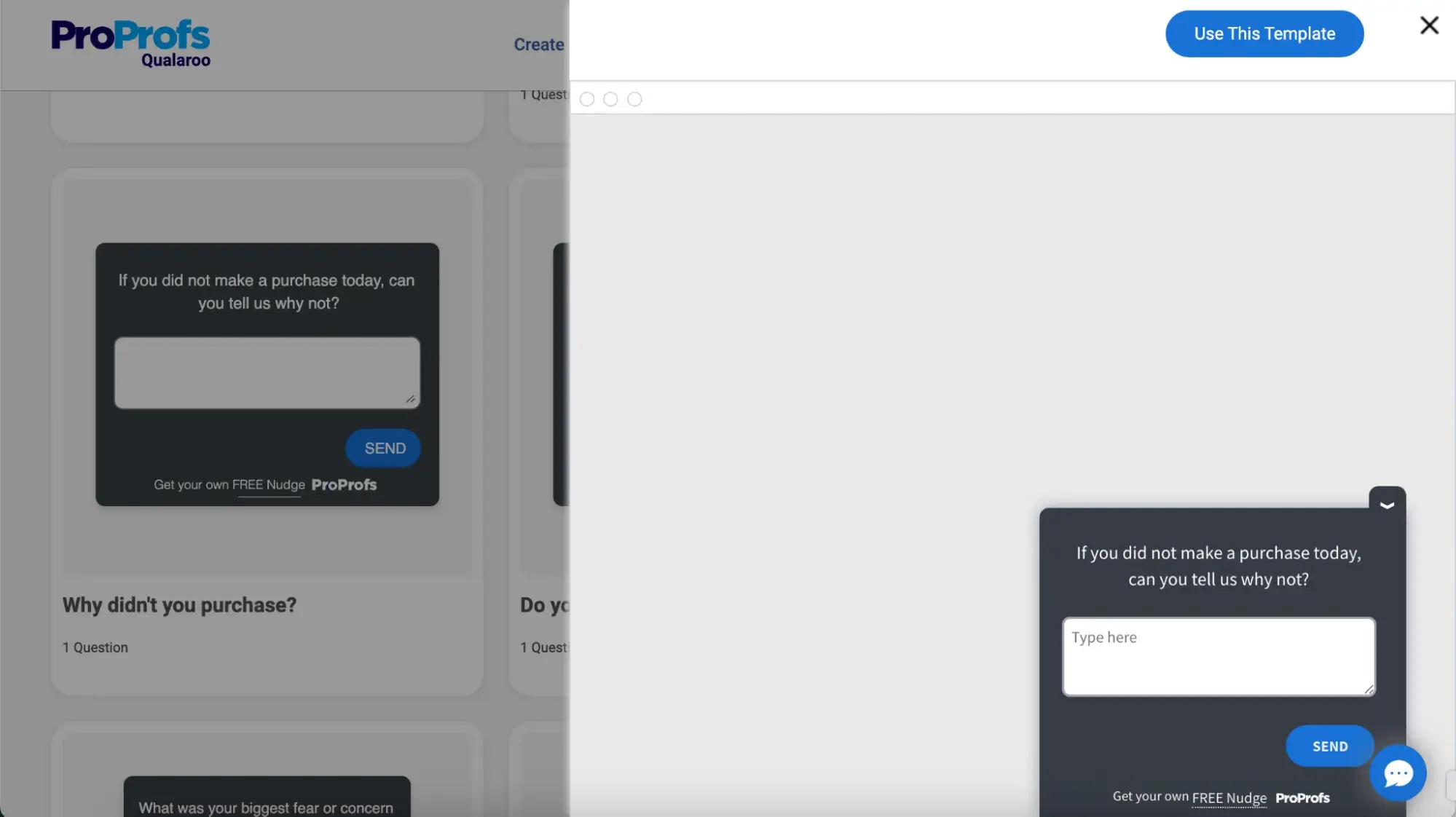
Qualaroo by ProProfs helps sales teams collect customer insights and feedback using website surveys. When installed, the platform uses its Qualaroo Nudge™ technology across websites, mobile devices, and apps to survey users and gather feedback while they’re scrolling. The technology analyzes time on page and behaviors to determine the right questions to ask and when.
Features: Qualaroo offers customizable survey options and advanced targeting features.
What I like: Surveys are an interesting way to generate leads. In my experience, Qualaroo makes categorizing leads and sending them to designated funnels based on their answers seamless.
Pricing: Qualaroo is free for up to 50 responses per month. Paid plans start at $19.99 per month.
7. Discover.ly

Discover.ly is a Google Chrome browser extension that allows you to find and score leads from social media. It connects Gmail, LinkedIn, Facebook, and Twitter (X) so you can see information about your contacts.
Let’s say I’m browsing LinkedIn and see a prospect I’m interested in connecting with. Using Discover.ly, I can see even more information about their social network including if me and this person have any mutual friends on Facebook. This tool helps you turn cold leads into warm ones.
Features: Discover.ly profile scans recommend and score prospects you’re connected to on social media.
What I like: There’s zero barrier to entry with this tool. I can simply download the extension and let it work its magic while I browse social media.
Pricing: Free.
8. LeadQuizzes

Does a question ever pique your interest? How about a quiz? If you want to engage prospects and, at the same time, learn more about them, consider using a quiz. LeadQuizzes is an online quiz maker that helps businesses capture website leads and understand your audience’s interests or needs.
Features: LeadQuizzes can be embedded into your website and integrates with several tools, including HubSpot. This makes it easy to generate leads in a way that fits into your current lead generation process.
What I like: Quizzes are a unique way to capture your audience’s attention and generate leads in a way that brings some value to your prospects.
Pricing: Plans start at $9/month.
9. Hello Bar
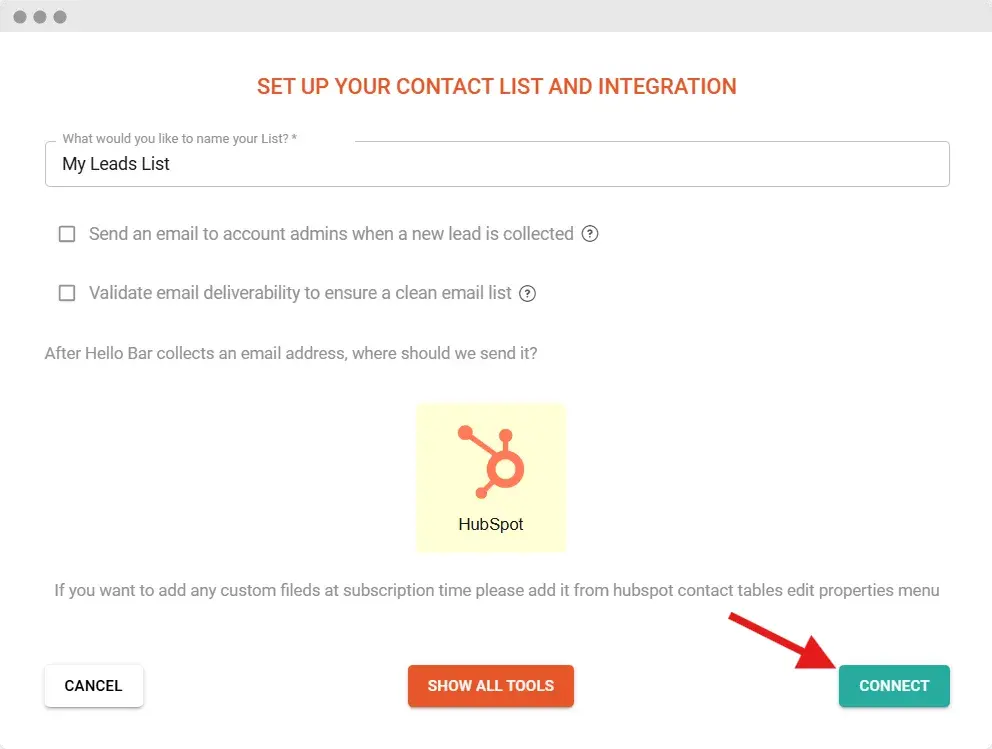
You know whenever you visit a website and you’re greeted by a popup that splashes across the screen? Hello Bar is a widget that enables you to create those popup bars. Popup bars are an effective way to capture leads and gauge users’ interest in your product. Hello Bar claims website popups drive 12x ROI for companies of all sizes.
Features: You can choose from a wide variety of popups: bars, modals, alerts, sliders, and full-screen page takeovers.
What I like: Hello Bar is highly customizable and integrates with many tools, including HubSpot.
Pricing: Free for up to 5,000 page views per month. Paid plans start at $29/month.
10. Everwebinar

Webinars are a key part of any B2B marketing strategy. Webinars are an effective way to educate your target audience on the problem your company solves, discuss industry trends, and, of course, generate leads. Everwebinar is a tool that helps you schedule and automate your company’s webinars.
Features: Everwebinar offers interesting features like a live chat simulator. You can write or upload conversation starters that will automatically show up in the chat during your live event.
What I like: Webinars don’t always get a ton of real-time engagement, but Everwebinar helps make the experience feel lively.
Pricing: $99 per month, $499 per year, or $874 every two years.
11. Mailchimp
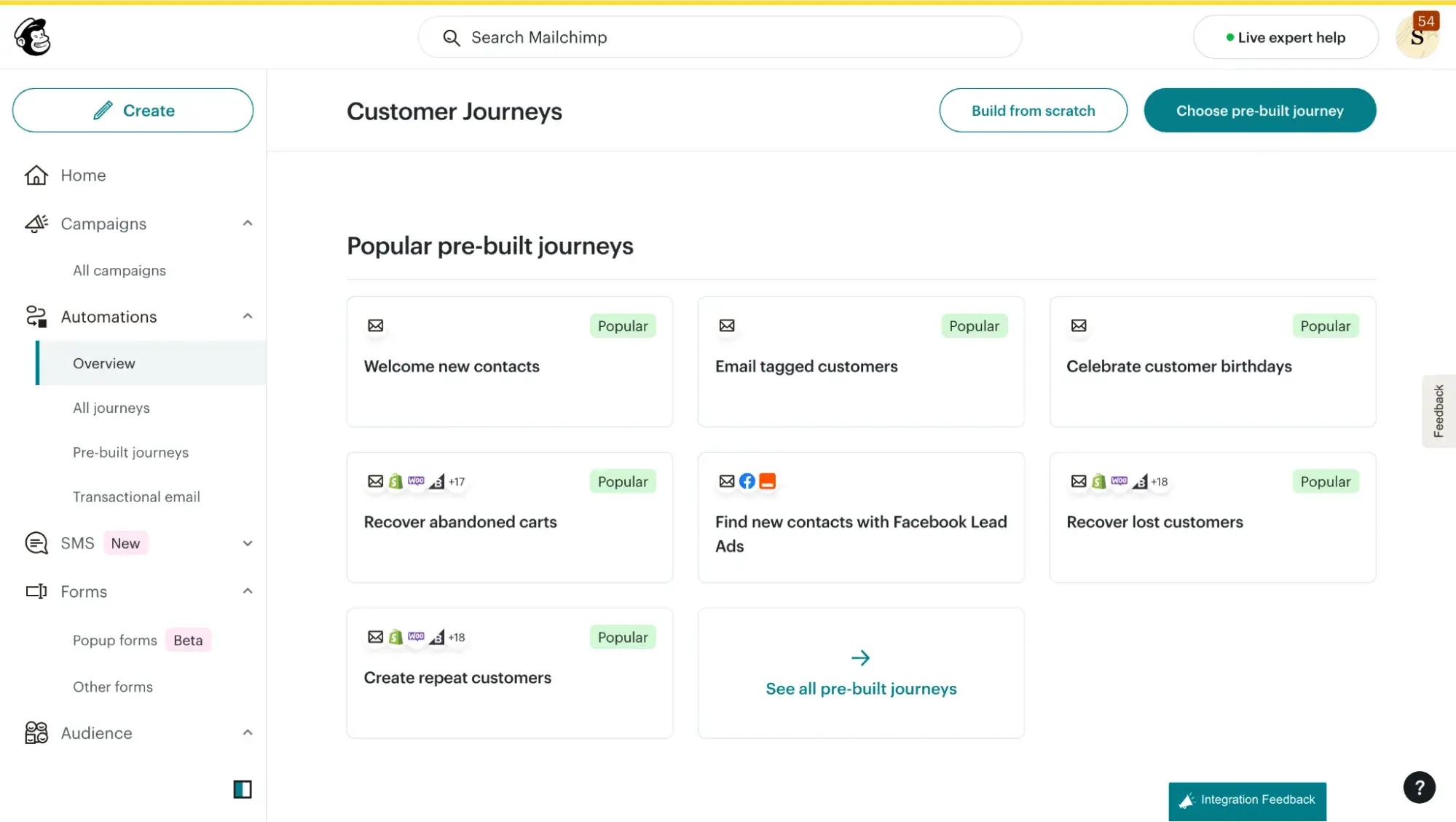
Mailchimp is an email marketing tool that you can integrate with your landing page tools or CRM. In my experience, Mailchimp is easy to use for emails and campaign tracking. It also offers pre-built automation journeys which I found helpful when I was just getting started. However, Mailchimp can be hard to scale with if you have thousands of contacts on your list.
Features: Email automation tools, lead capture forms with exit-intent technology, and shareable newsletter URLs.
What I like: Mailchimp makes it easy to create on-brand emails and track campaign performance.
Pricing: Mailchimp offers a free plan with a 1,000 send limit and up to 500 contacts. Paid plans start at $13/month and increase based on the number of contacts you have.
12. HotJar
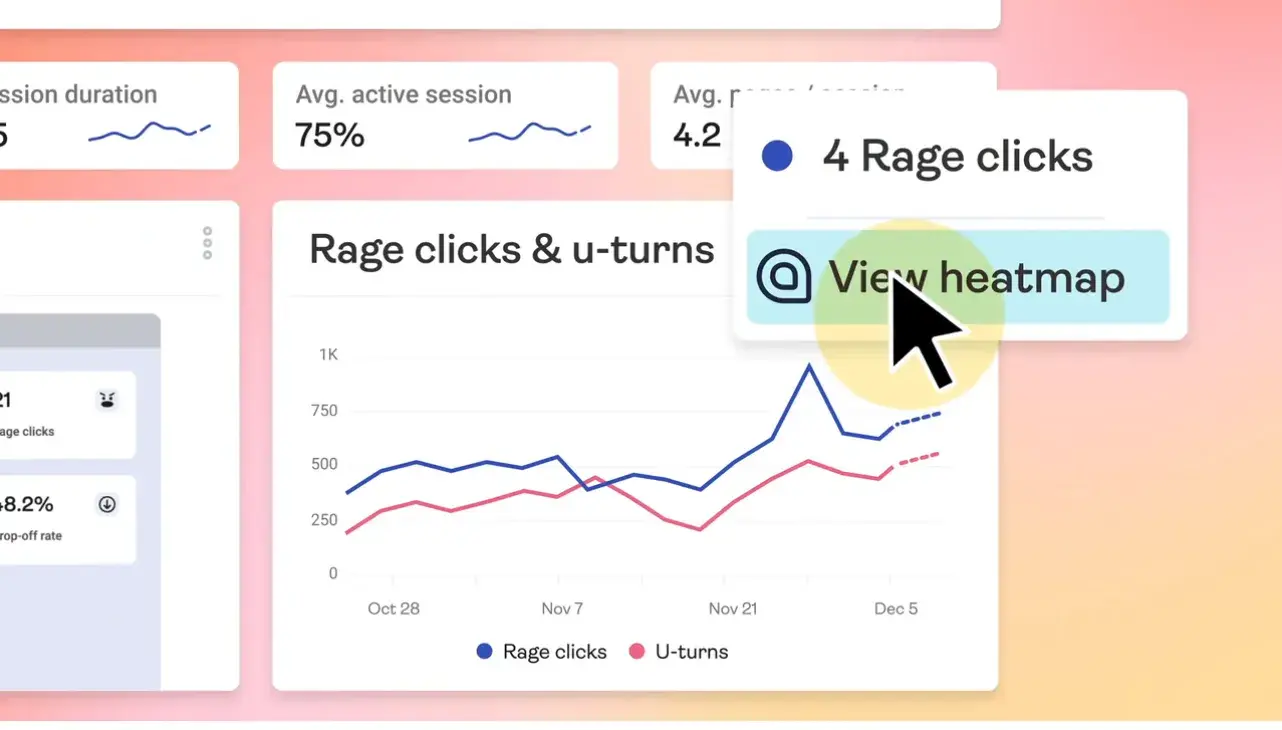
https://www.hotjar.com/product/heatmaps/
At its core, HotJar is a customer experience platform that enables you to visualize user behavior with heatmaps and design surveys. In my experience, heat maps can be incredibly insightful.
Not only can you see which buttons got the most clicks on your site and landing pages, but also where people spent the most time. For lead generation, this can tell you which sections of your site to focus on with your leads.
Features: Heatmaps, surveys, and a dashboard for viewing analytics.
What I like: Heatmaps provide useful intelligence about how users behave on your site. HotJar also enables you to target visitors by URL, device, and user attributes.
Pricing: Hotjar offers a free plan for up to 20K monthly sessions. Paid plans start at $40/month.
13. Zapier
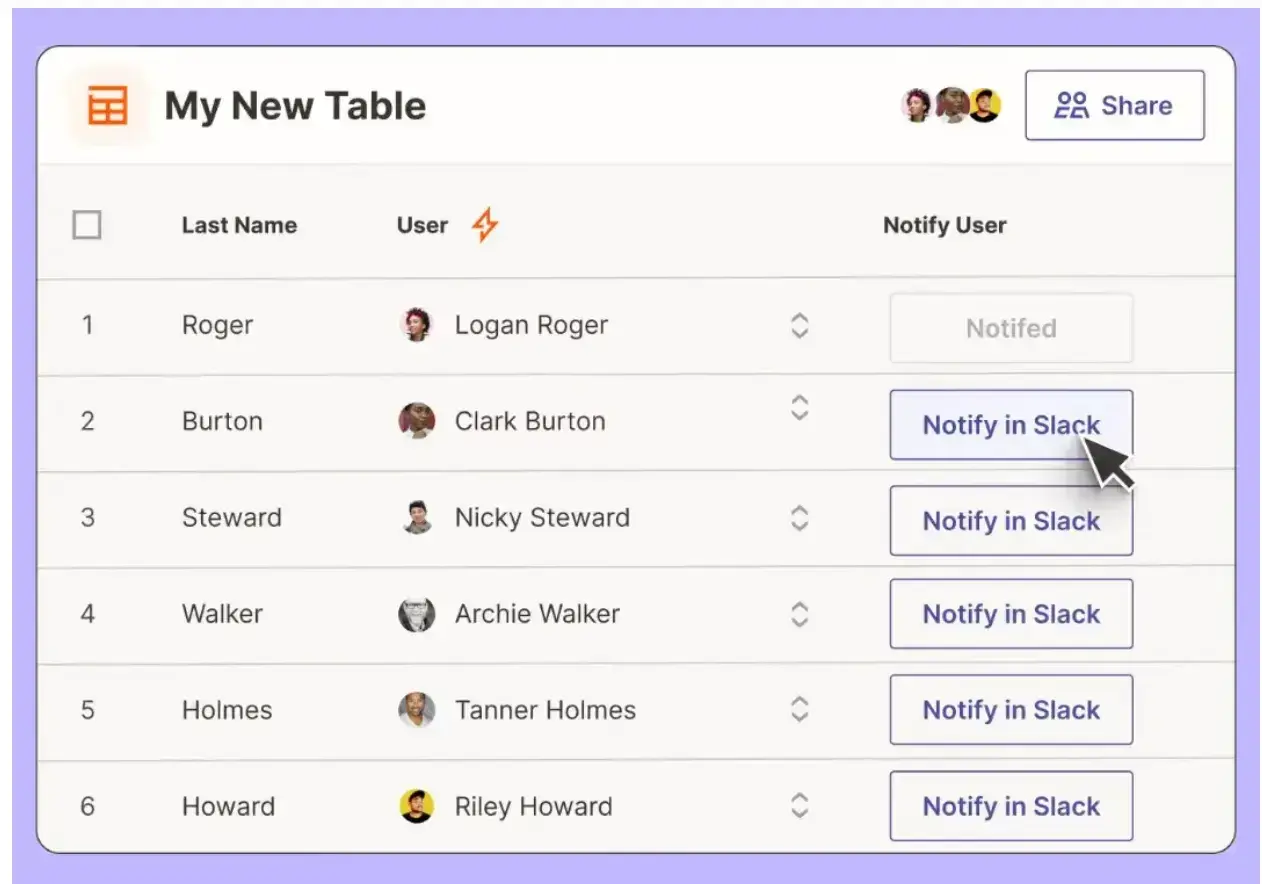
Zapier is an automation platform that lets you connect over 3,000 apps to create an automated workflow. This is an essential tool for B2B sales and marketing teams to stay aligned when it comes to connecting with leads. In my experience, Zapier makes it easy to automatically start the lead nurturing process as soon as a lead is captured.
Features: Pre-made templates for connecting and automating tasks, plus countless integrations
What I like: Zapier is compatible with over 3,000 apps, making integrating software and tools easy.
Pricing: Zapier has a free version. The Starter plan is $19.99/month while the Company plan is $599/month.
14. Wistia
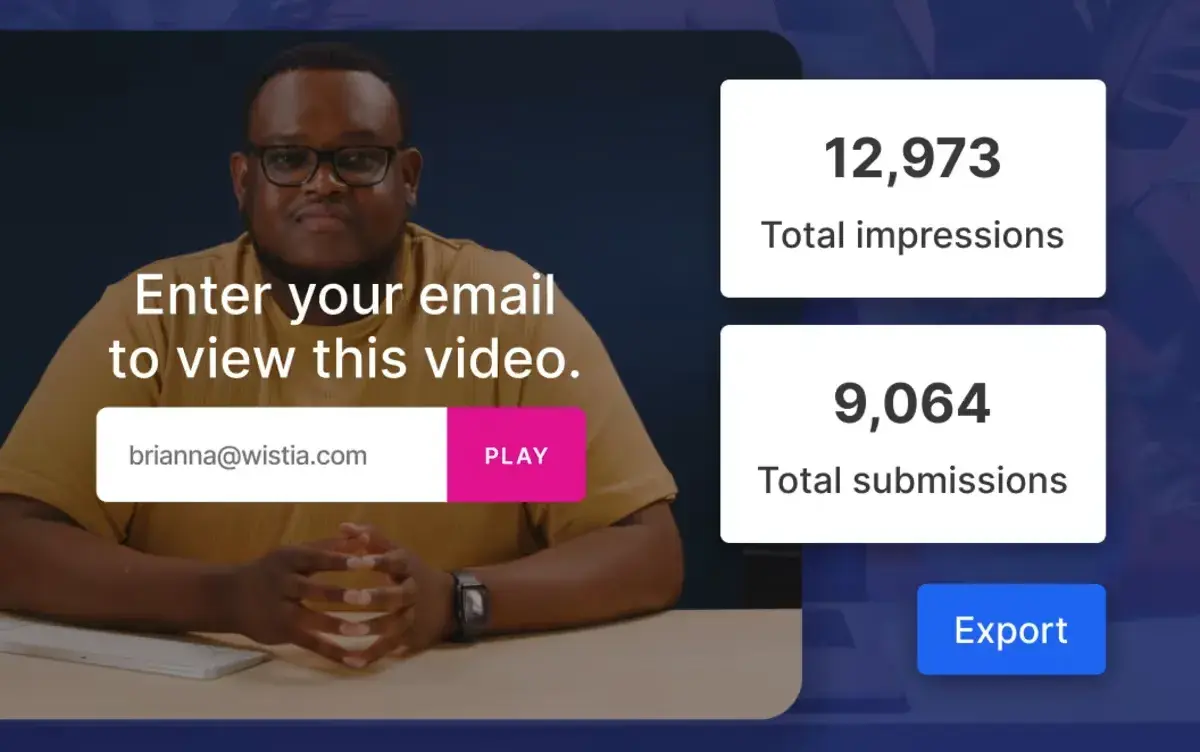
During a time when videos are ruling the marketing world, it’s a good idea to integrate them into your lead generation process. Wistia helps you collect emails from your videos to generate leads.
Let’s say you have a demo video on your website. Once prospects have entered their email to view the video, you can easily connect Wistia to your CRM — like HubSpot. From there, you can set up different workflows based on certain triggers.
Features: You can customize how you want your email collecting form to appear, like on hover. You can also personalize the submit button copy.
What I like: You can connect your data to your existing CRM, like HubSpot, which makes lead capturing seamless.
Pricing: Wistia offers a free plan for individuals. Paid plans start at $19/month.
15. Datanyze
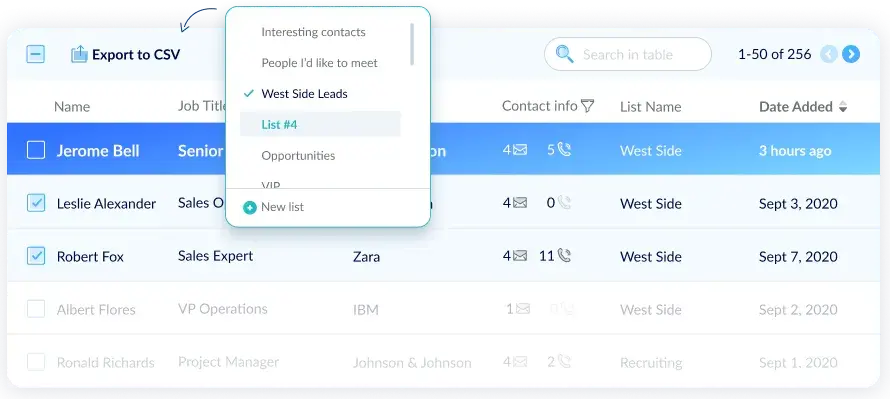
Receiving quality data is important for generating quality leads — it also helps you cut down on time spent prospecting. Datanyze is a Google Chrome extension that collects contact information directly from LinkedIn profiles and company websites.
Features: Datanyze lets you store, collect, and export prospect data including email addresses and phone numbers.
What I like: Because it’s a Google Chrome extension, I like that you don’t even need to stop what you’re doing and leave your browser to collect prospect contact information.
Pricing: Datanyze offers a 90-day free trial. Paid plans start at $21/month.
16. Customers.AI
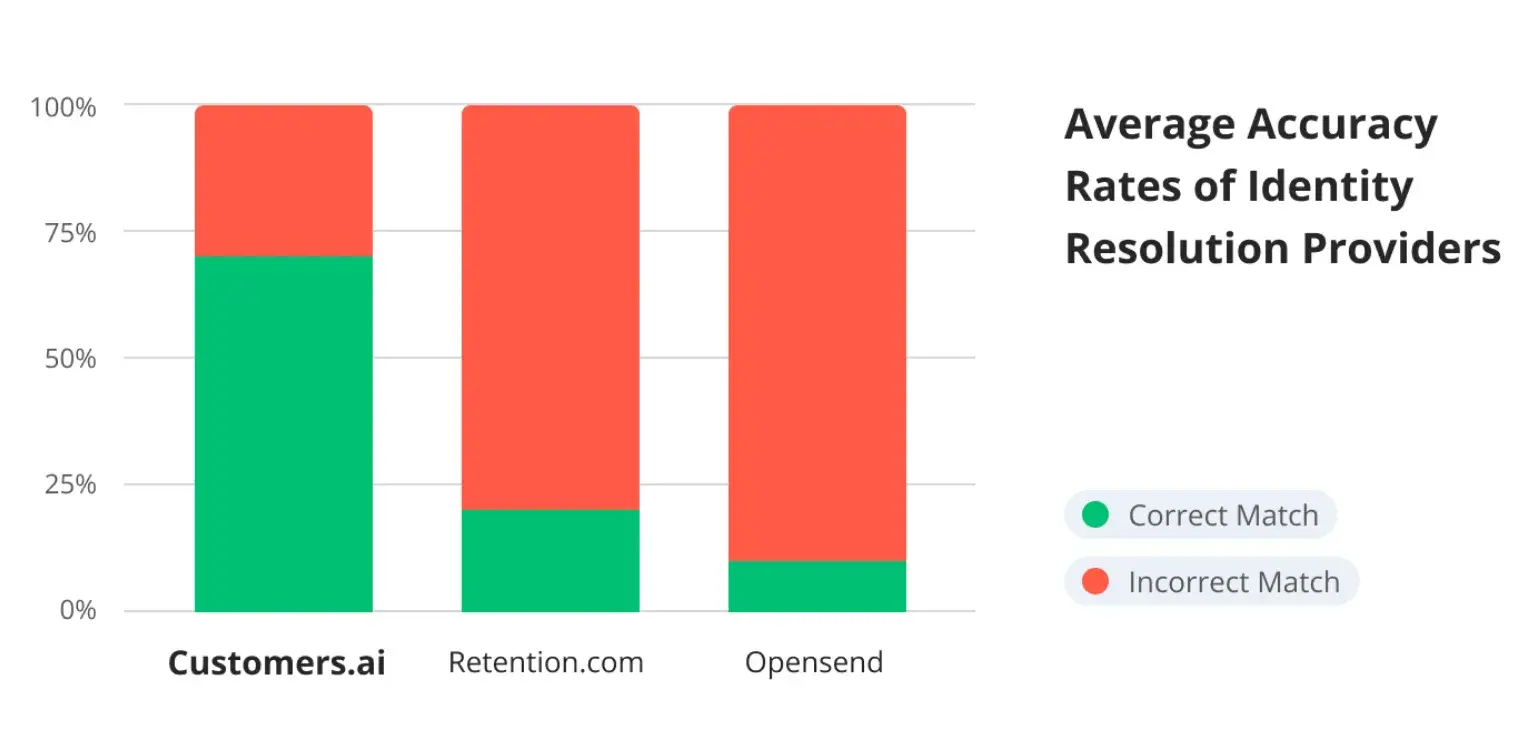
Customers.ai is a website visitor tracking tool that claims to be 65-85% accurate — compared to other ID providers which may be 70-95% inaccurate. Customers.ai can help you increase conversions with better user journey transparency of both anonymous and known website visitors.
Features: Customers.ai reduces spam rate, offers a native ESP, and helps target high-intent users.
What I like: In my experience, capturing website visitor data can be tricky to navigate. This tool helps improve accuracy and targeting.
Pricing: Plans start at $199/month.
17. Hootsuite

Hootsuite is, first and foremost, a social media marketing tool. But it can also be used for lead generation if you know which features to use. Hootsuite enables you to monitor social profiles from one place, schedule posts in advance, and analyze social campaigns’ performance. You can also set up automated responses to DMs, which can be useful to ensure you don’t miss out on any leads.
Features: The shared inbox is the most compelling feature for sales teams. The platform also offers post scheduling, advertising tools, and comprehensive analytics.
What I like: Hootsuite consolidates social media activity across multiple channels, and the shared inbox is ideal for keeping sales and marketing teams on the same page.
Pricing: Plans start at $99/month.
18. Semrush
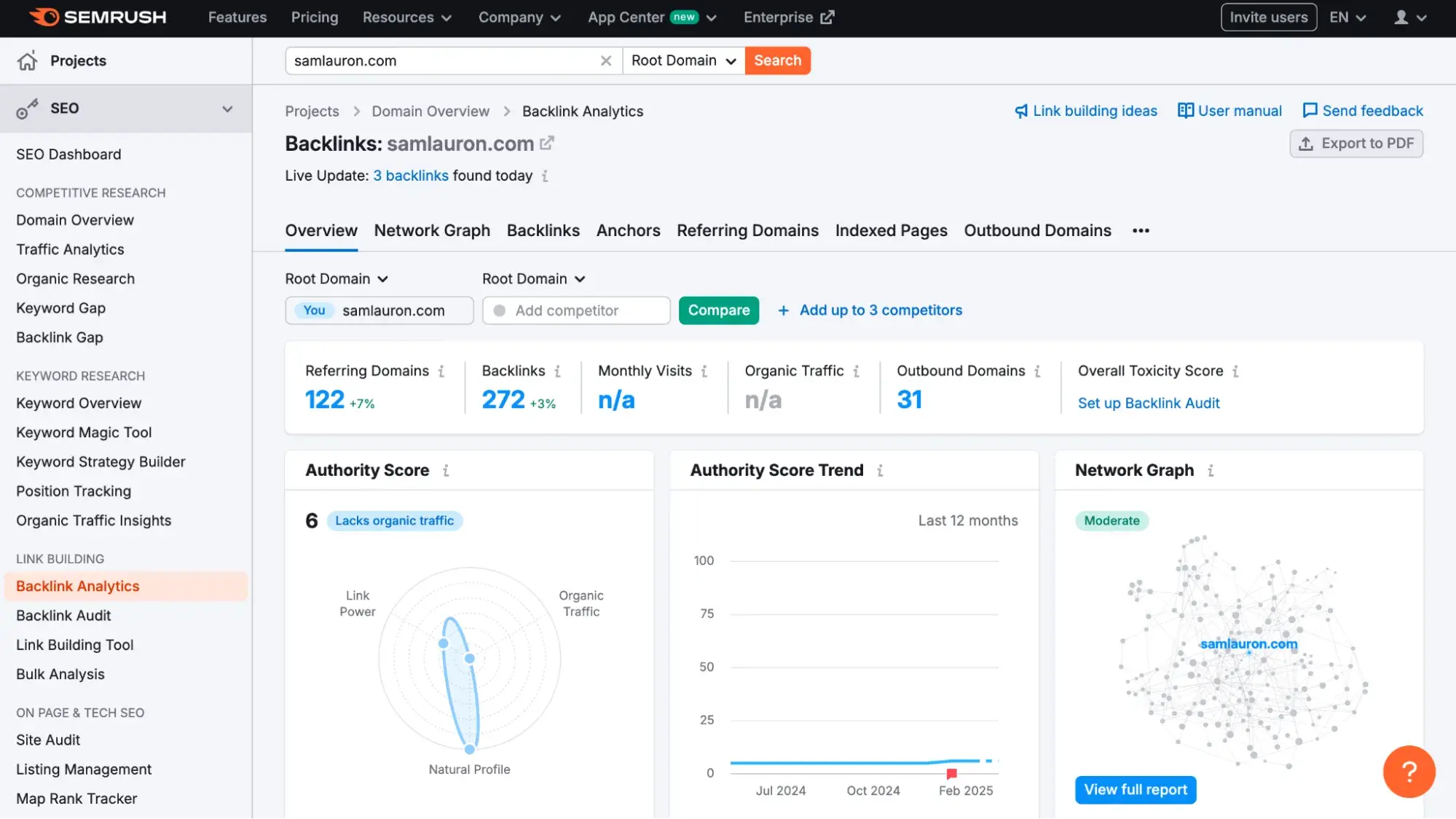
It would be hard to drive qualified site leads with bad SEO. SEMrush is an SEO tool you can leverage to perform website audits and use that information to assess where you can improve in driving search traffic to lead-gen content.
Features: You can run technical SEO audits, track SERP positions; integrate with Google Analytics and other data tools, build, execute, and monitor PPC (pay-per-click) ad campaigns.
What I like: SEMrush integrates with Google Analytics, making insights more powerful.
Pricing: Plans start at $117/month.
19. ActiveCampaign
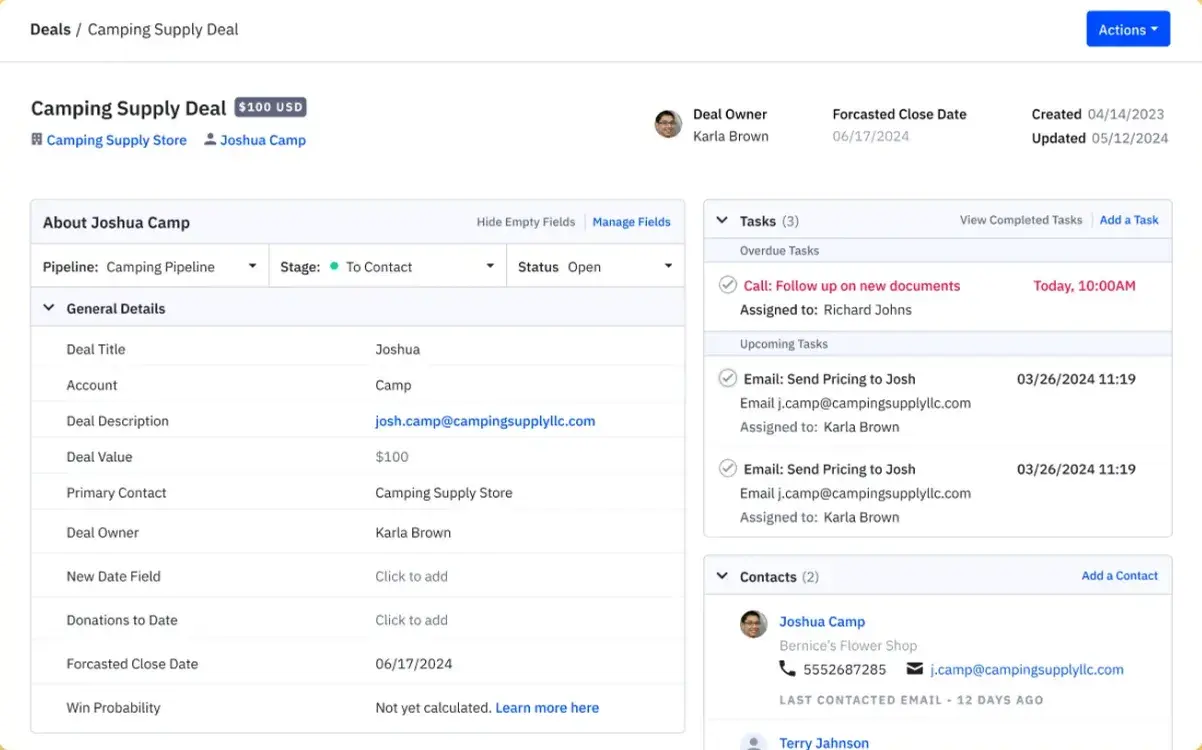
ActiveCampaign is an email marketing and automation tool that doubles as a sales CRM. The platform aims to help users collect and organize leads through campaigns, engagement, and automations.
Features: You can connect email, SMS, and ad campaigns in one platform.
What I like: If you’re on a budget, you can affordably get a lot out of ActiveCampaign’s features.
Pricing: Plans start at $15/month.
20. Jotform
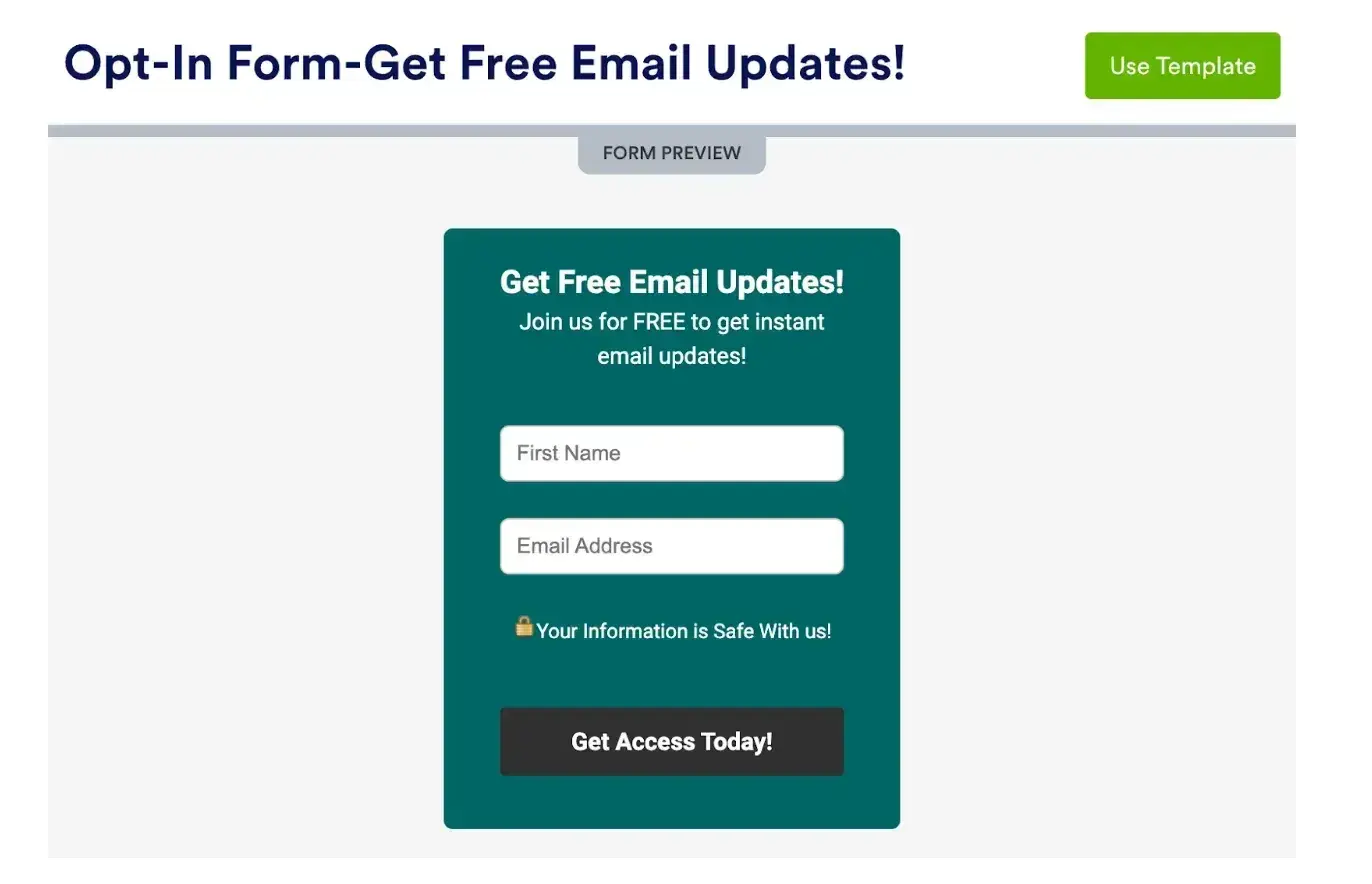
Every B2B website needs some sort of form for collecting data. Jotforms does exactly that by allowing you to collect data like website visitor emails, payment information, and names.
Features: You can build professional-looking forms that integrate with email marketing services, project management boards, CRMs, cloud storage apps, and more. You can also be paid directly through your form.
What I like: Jotform has over 10,000 free templates, from registration sign-ups to surveys to contact forms. They’re simple, professional, and easy to customize, in my experience.
Pricing: Jotform offers a free plan with up to five forms. Paid plans range from $34 to $99 per month.
How to Choose Winning B2B Lead Generation Tools
While the list of lead generation tools feels endless these days, here are a few quick things I recommend keeping in mind when choosing the right tools:
- What channels are most effective for your lead generation efforts?
- Which channels can be improved?
- What’s your budget for lead generation?
- What level of ROI do you need?
- How many users will need to use these tools?
By answering these questions, you can identify the best tools for your exact sales and marketing needs. B2B lead generation can be a tricky process when you’re getting started, but these tools can help make the process easier.
Editor’s note: This post was originally published in April 2023 and has been updated for comprehensiveness.
![]()
This AI prompt can transform you into an elite marketer in any field, here’s how
We all know AI assistants can help with marketing tasks. But, here’s what most people are missing: Using AI as a prompt engineer is where the real productivity gains happen. I’ve been experimenting with this approach for months, and the results are mind-blowing. Instead of […]
MarketingWe all know AI assistants can help with marketing tasks. But, here’s what most people are missing: Using AI as a prompt engineer is where the real productivity gains happen.
I’ve been experimenting with this approach for months, and the results are mind-blowing. Instead of crafting prompts from scratch every time you need help with a campaign or strategy, you can use AI to build an entire library of expert-level prompts that work.
The best part? It works across every area of marketing and scales with whatever you‘re working on. Below, I’m going to share the single AI prompt that will create an expert-level library of marketing prompts. With it, you can transform how you approach marketing work entirely. Let’s dive in.
This One Prompt That Will Make You a Marketing Master
To get this prompt going, the first thing I do is open up ChatGPT and tell it to act like a prompt engineer, expert marketer, or strategic operator. Then, I give it a task:
- “When I give you any kind of marketing discipline (e.g., SEO, paid media, lifecycle), create a prompt library designed by an elite marketer in that field.”
For the deliverables, I tell ChatGPT the format I want, including a summary of how top marketers in this discipline think, what drives results, and how they scale their work. And then, I include instructions on how to create the prompt library.
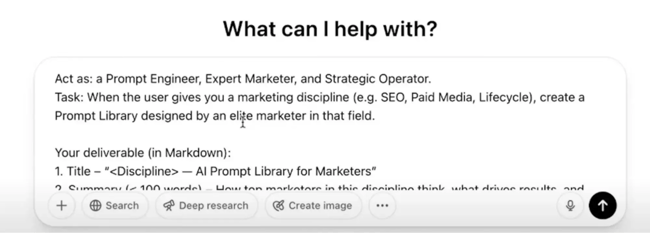
The full prompt is below for you to see. When I run it, ChatGPT comes back with ten prompts that I can just copy and paste. And, each prompt is based on the thinking of an elite marketer in the field. So, basically, it’s accumulating tactics from successful brands and giving me prompts from that company’s perspective.
Let me give you an example of how this works. After I put in the prompt, ChatGPT will ask me what discipline I want to use. If I say SEO, it first gives me a list of Winning Mental Models, citing the best tactics from the best brands. Here’s what ChatGPT generated:
- The importance of “topic clusters,” citing HubSpot, with the lesson, “build depth-first content silos to signal topical expertise to Google.”
- The idea of “velocity over volume,” citing Grow & Convert, with the lesson, “80% quality at 5X speed wins vs. perfectionism.”
- Six other tactics from elite-level marketers that I can review before I dive into the prompt library.
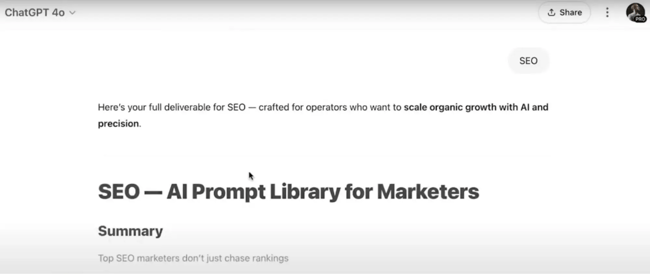
Then I get a ready-made list of ten prompts that takes the above tactics and develops strategies that I can recreate. With the SEO example, the first prompt I get is:
- Cluster Plan for a Core Topic – “Act like a senior SEO strategist at HubSpot. I want to rank for [employee engagement]. Build a topic cluster with: (1) a pillar post, (2) five cluster articles, (3) intent tags, and (4) internal link structure.”
This prompt is ready to use just by changing the keyword in brackets to whatever I want to rank for. The output also tells me why this fits and how HubSpot would use this tactic. I then get nine more prompts with the same level of detail that I can plug into my AI assistant right now.
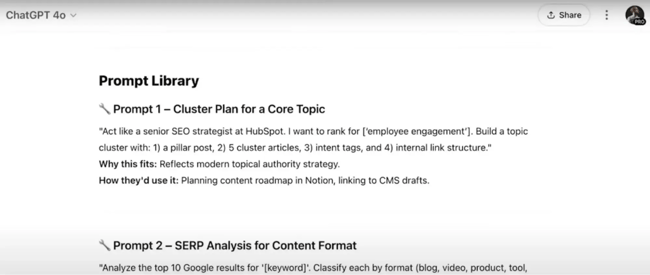
This example was for SEO, but I could do the same thing for product marketing or brand marketing, and I would get entirely different results and prompts. It’s just going through and asking, who are the elite marketers in the world? And, what AI prompts would those people use?
The great thing is that you can use this for any tactic to automate your marketing. Just copy the prompts and start to build a library that’s relevant for you and your team.
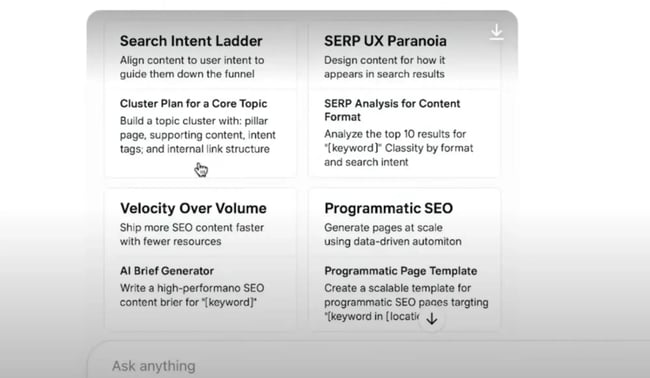
The Prompt
Act as: A prompt engineer, expert marketer, and strategic operator.
Task: When the user gives you any kind of marketing discipline (e.g., SEO, paid media, Lifecycle), create a prompt library designed by an elite marketer in that field.
Your deliverable (in Markdown):
- Title — “<Discipline> — AI Prompt Library for Marketers”
- Summary (≤ 100 words) — How top marketers in this discipline think, what drives results, and how they scale their work.
- Winning mental models
- List 5-10 key strategies or operating principles used by elite marketers in this field. For each, include: a name (e.g., “Content-Audience Fit”); a 1-line description; a practical, bite-sized lesson; a source or citation (Operator + Year, or company if applicable).
Prompt library — exactly 10 actionable prompts. Each must include:
- Prompt <#> — <Goal>
- <Prompt text written in the voice of an advanced operator>
- Why this fits: (≤ 25 words — explain why this prompt reflects cutting-edge thinking in this area.)
- How they’d use it: (How the marketer would deploy it in a real-world workflow. Include tool or channel if relevant.)
Style
- Use clear, modern marketing language.
- Prioritize tactics that *scale*, not fluff.
- Be concise, punchy, operator-grade.
Sources
- Use examples, operators, or results from trusted sources post-2015 (e.g., Growth.Design, Reforge, Demand Curve, HubSpot blog, etc).
Why It Works
This one AI prompt works because it takes the brain power of the best people in the world and turns it into easily accessible knowledge. By telling you what elite marketers do in their space, you can replicate their tactics.
I love AI because you start with one thing and then continue to build on it. For more prompts, I recommend checking out our curated prompt library, along with this list of marketing prompts. Then, you can steal our favorite AI prompts to use on your own.
A Game-Changing AI Marketing Prompt
With a single input, you come away with actionable prompts that you can use right now, save for later, or share with your team at any time. An advanced-level AI prompt that generates more expert-level prompts? That’s transformative for any marketer.
To learn more about this game-changing AI prompt, check out the full episode of Marketing Against the Grain:
![]()
Content strategy red flags: What B2B marketing teams get wrong and how to course-correct
I see a lot of marketing teams stuck in the same cycle: They believe in content. They’re creating constantly. But, they’re just not seeing the results they want. Add that the CEO is asking why the competitor is “suddenly everywhere.” Oh, and internally, there’s no […]
MarketingI see a lot of marketing teams stuck in the same cycle: They believe in content. They’re creating constantly. But, they’re just not seeing the results they want. Add that the CEO is asking why the competitor is “suddenly everywhere.”
Oh, and internally, there’s no real alignment on who you’re talking to, what you’re trying to say, or how you’re measuring success.
That’s usually when I get the call.
I’m Devin Reed — former head of content at Gong and Clari, now working with B2B marketing teams through my company, The Reeder. I’ve helped scale brands from $20M to $ 200M+ ARR, and I’ve worked with companies like Notion, Wiz, and FloQast to build content engines that drive tangible pipeline.
When I run a content audit, I’m not just skimming through performance dashboards. I’m digging into what’s broken, what’s missing, and what it’s going to take to turn content into a real growth lever.
In this piece, I’ll walk you through how these projects usually start, the most common mistakes I see, and what teams can do to course-correct.
Why Companies Reach Out for a Content Audit
Before I begin working with clients, a CMO or VP of marketing already has had a long-time conviction that content is important. But, they’ve had a recent realization that it’s no longer something they can take lightly. Put another way, they know they can’t afford not to invest in quality content marketing.
Usually, something went spectacularly wrong recently, or the CEO said something like, “It’s time to get our act together.”
Other times, they’ve realized there’s not one growth number they can look at confidently and say, “See, it’s working!” And even more often than ever, it’s a bigger strategic play, like launching new products, especially now with AI.
So the question becomes: How do we get our name and our product story out there in a way that makes it radically clear that we are different than our competitors?
Sometimes, it’s just competitive pressure. The CEO of their biggest competitor is active on LinkedIn. Their whole team is posting. It feels like they’re eating up all the attention. So, they start thinking, “We’ve got to do something.”
That’s where my Content Design process comes in, which always begins with an audit. Because if I were stepping into the Head of Content role at a company, that’s exactly what I’d do before publishing a single word. I’d want (and need) to know:
- What have we been doing?
- What’s working?
- What’s not?
- What are our competitors doing, and what seems to be working for them?
From there, we can build something off their strengths, avoid weaknesses, and, most importantly, create something that actually stands out.
The 5 Most Common Content Marketing Mistakes I See
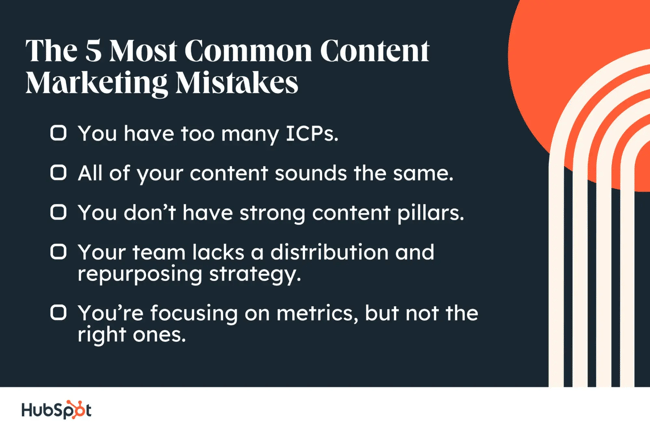
I’ve done a lot of these audits, and there are a few mistakes that come up over and over again, regardless of company size or industry. Here are the most common and damaging.
1. You have too many ICPs.
I think the biggest mistake I see is having too many ideal customer personas.
There’s been so much noise (or insight, depending on how you look at it) about how buying committees are getting bigger and sales processes are more complex. So, I see a lot of marketing teams that feel pressured to market to everyone as a result.
One day, it’s the CRO. The next day, it’s the CFO. Then, it’s the sales enablement team. Before you know it, you’ve got five or seven ICPs you’re trying to speak to. But here’s the thing: You can’t have seven “ideal” customers. If everything is a priority, nothing is.
You’ve got to pick one, maybe two, and prioritize accordingly.
The other version of this is: You only have one or two ICPs, but you don’t really understand them. You’re not clear on what their world looks like, what their real problems are, or how they’re trying to solve them.
Those are the two biggest challenges: Either you’re spread too thin, or you’re not going deep enough.
2. All of your content sounds the same.
When I’m doing the audit, I always ask the client to send me recent content, usually the stuff they consider “top-performing.” (But honestly, they probably wouldn’t have hired me if it were truly performing.)
What I see most of the time is content that’s informational, but not entertaining. It’s not different. It doesn’t share a perspective that hasn’t already been said a hundred times.
And, I think that used to be fine. Maybe pre-2022, before ChatGPT and AI, information had more value. You needed to have real experience, be a researcher, or deliver something in between to say something useful.
But now, information is everywhere. You can use ChatGPT and be an “expert” in almost anything, really quickly. Just having information isn’t enough anymore.
What is enough? A unique spin. A point of view. What’s your take on this trend? What’s the connection you see that others don’t? What’s a story from your experience that makes this relatable?
So now, information has less value. The relatability becomes really important. The stories become important. That’s what people are going to remember more. That’s what makes the content stand out.
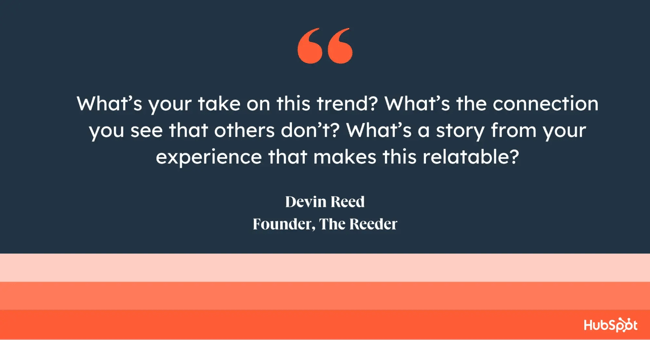
3. You don’t have strong content pillars.
This one’s super common: Most folks don’t have a documented content strategy.
Their topic selection gets reactive. One week, it’s product-focused. That is, until the CEO pings them and says, “Hey, our competitor just did a podcast on this. How come we don’t talk about it?”
So, now you’re chasing competitors instead of setting your own direction.
And when you play that out over time — like, a year’s worth of content — you end up with a calendar that’s all over the place. No one’s going to remember what you stand for. No one’s going to associate your brand with a single idea.
We all have busier lives and access to more content than ever. You’re lucky if someone remembers one thing about your company. If your content is scattered, that never happens.
Instead, you want guardrails. That doesn’t mean you can’t newsjack or jump on trends. But you need to be playing one beat, all year long. One drum that points to one core idea. And, 90% of your content needs to ladder up to that.

4. Your team lacks a distribution and repurposing strategy.
I’m working on this exact problem right now.
Someone hired an SEO agency. They’re making great content. But, what happens next? They post the blog on their website. Maybe make a corporate LinkedIn post. That’s it.
So now, they’ve got all this good content sitting in a place where people aren’t actively spending time.
That’s not a distribution strategy. You’ve got to meet people where they are. Your audience may go to your website. But, you need to appear on their LinkedIn feeds, inboxes, and webinar rotations.
Otherwise, your team is investing $10K+ per month on content that’s not driving traffic, not driving conversions. You end up with great content for the sake of having it.
So, make the time to repurpose your greatest hits. You spent all this time on a smart framework, solving an urgent problem. Why not turn that into 10 LinkedIn posts? Why not make it a webinar, a keynote, or go on a podcast circuit?
We can’t assume, “If we build it, they’ll come.” We’ve got to be just as intentional about distributing and repurposing as we are about creating.
5. You’re focusing on metrics, but not the right ones.
The biggest gap I see is people who don’t understand how the work connects to business outcomes.
Let’s just take webinars as an example. I’ll ask, “Why are you doing them? Why does the number of registrations need to grow 20% quarter-over-quarter?”
Do you know your attendance rate? Let’s say it’s 25%. Cool. What’s your MQL rate? What’s your conversion rate from MQL to opportunity? What’s your ACV?
Most marketers don’t know that cascade. So, they just keep doing more. That means more webinars, more content, more stuff — without knowing why or what it’s driving.
If you’re doing content that doesn’t have a direct ROI, fine. But, you need to tie it to what I call the “CEO slide.”
Every year, the CEO gets up and says, “Here are the four or five strategic priorities this year.” Perfect. Tie your content to one of those. Then share metrics that show some form of impact. Growth over time. A directional shift. Something that says, “This matters.”
How Teams Can Get Back on Track

If you’re trying to fix these issues, here’s where I’d start.
1. Create a cohesive content strategy.
That’s the first thing. You need a content strategy that aligns all your decision-making in one place. You can’t align your team if you don’t have a single source of truth for what you’re doing and why.
This handles a lot. It gives you focus, clarity, and a way to evaluate ideas beyond, “Does this sound cool?”
2. Build content program or channel playbooks.
You should have a step-by-step guide for how to create high-impact content every single time. That includes ideation, production, approval, distribution — start to finish. The whole process should be mapped out.
That way, once you have a good idea, you’re not reinventing the wheel. You’ve got a clear path to take it from idea to execution consistently and effectively.
3. Define your metrics (and own them!).
This should live in your content strategy, too. What are the top three metrics you care about? And then, go deeper by channel.
Like I mentioned with webinars, ask, “What does success look like? What’s the full funnel of that channel?” If your team doesn’t know it, that gives you an opportunity for learning and development.
And as a head of marketing or content, that’s something you can teach.
Get Clear Before You Create
If you’re creating consistently but still not seeing the impact you want, don’t assume the answer is to do more. Step back. Audit what’s working, fix what’s broken, and rebuild with focus.
Once you understand where things are falling short, you can make smarter decisions, realign your team, and finally start seeing the results your content was supposed to drive in the first place. And if you need more support, you know where to find me.
![]()
How to create a landing page: My simple step-by-step approach
The other day, I was reading a blog post when something caught my eye: a section about how to create a landing page to promote offers like a free ebook. Naturally, I clicked the link. It took me to a clean, focused page that broke […]
MarketingThe other day, I was reading a blog post when something caught my eye: a section about how to create a landing page to promote offers like a free ebook. Naturally, I clicked the link. It took me to a clean, focused page that broke down what the ebook included, how to get it, and why it was worth checking out.
As I scrolled through, a few things stood out. The design was super simple — no distractions, just a clear focus on the ebook. The copy was sharp and persuasive, and it made the offer feel like a no-brainer. Best of all, they only asked me for my name and email. I got valuable insights, and they got a new subscriber. Win-win. That’s the power of a well-built landing page.
Interested? Well, in this post, I’ll walk you through the key steps for creating a landing page that builds on those principles. Personally, I love starting with a template. It saves me from dealing with any code, and I can focus on making the page look great and convert well.
I used HubSpot’s CMS, but you can use any similar software that offers landing page templates, like HubSpot’s free landing page builder or Mailchimp.
Table of Contents
Landing pages usually fall into one of two categories: reference or transactional.
- A reference landing page is more like an informative guide — it explains a specific product or service in detail.
- On the flip side, a transactional landing page is all about action. It’s designed to get visitors to do something, like download an ebook, sign up for a webinar, or make a purchase, which is why it’s a go-to for marketing campaigns.
For this example, let‘s say that I’m a marketer for a fictional NASA-esque space corporation, and I‘ve been tasked with making a landing page for a fantasy ebook about space to get children interested in aeronautics. This landing page’s goal is to increase leads.
1. Choose a template that will help you achieve your goal.
To build my page, I chose from a list of templates, while keeping my end goal in mind.
Knowing that increasing leads and the customer experience were top priorities, I chose a template that showcased my ebook offer and provided a form. I also wanted a unique, eye-catching structure and a simple design.
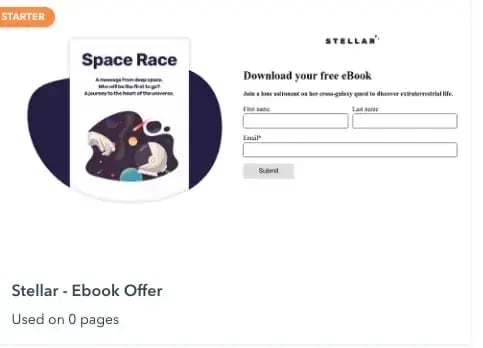
What I like about this landing page template — in addition to the criteria above — is that it’s labeled as “Starter.” As a marketer with little to no design experience, a beginner-level working template sounded right up my alley.
2. Name your landing page so you can find it later.
Next, it’s a good idea to name your landing page. If you plan on having multiple pages exist on the same system, be sure to name each something that will distinguish one design from future pages. For this example, I decided to name it “Ebook Offer One.”

That way, when I check on the performance of this particular landing page, I’ll locate it easily on my dashboard.
3. Design your page layout according to what you want your audience to see first.
After labeling your landing page, let‘s start designing. For this step, I was able to use a drag-and-drop editor. I’d decided that it was important for the leads to see the ebook’s cover, an engaging description, and the form.
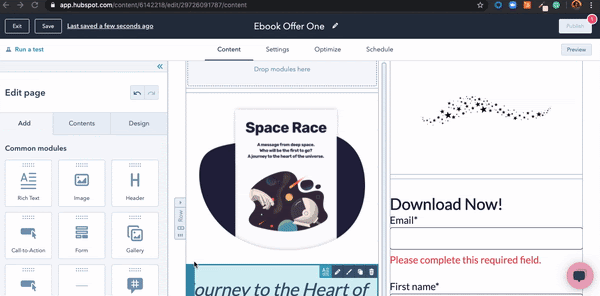
As a visual learner, a drag-and-drop editor is a dream come true. I can spend less time trying to learn code that would fix these elements and more time visualizing the experience for the lead. I can look at how the header‘s copy will be presented and if it’s effective at keeping audiences engaged.
4. Use the free Campaign Assistant to generate engaging copy.
This is the point where I’d like to ask you: Do you already have your landing page copy ready for publishing? The reason I’m asking is that I know from experience that it can take weeks to even draft a first version. If you don’t have text for your page yet, then I suggest using HubSpot’s free Campaign Assistant to generate copy based on your campaign goals and product/service information.
How does it work? Describe:
- The campaign you’re running.
- Who you’re targeting.
- What you’re offering
- What tone of voice you’d like to use.
For example: “I’m creating a landing page for a co-working space called [X], offering 25% off your first month for freelancers and remote workers. I’d like the tone of voice to be friendly and conversational.”
You’ll see a first version of the copy, which you can easily edit out. You can also regenerate the copy if you’d like to see an alternative. What I love is that you can save all versions of your copy and improve it as time goes by and you get the first results from your campaign.
5. Communicate the benefits of completing the landing page form to the website visitor.
Somewhere on my landing page, I wanted to provide short, impactful blurbs of value that would ultimately persuade the reader to complete the process.

In my example, the three columns at the bottom of the form communicate the value of my ebook. These columns each had their own engaging icon that was colorful, professional, and clean. I used the text to communicate a main benefit, then described it in a sentence below.
6. Personalize the page so it’s unique to the purpose and your brand.
The next step is sort of a “Choose your own adventure.” Here, I added elements that would fit with the brand of my imaginary company. I uploaded a logo image and made sure the colors were consistent throughout.

I wanted to make sure the text stayed black and white to match my logo and the images didn’t disrupt the usability of my webpage. This choice makes the page look professional and functional.
Once you‘re satisfied with the layout and design, it’s time to move on to the final steps.
7. Test your landing page for dynamic content and user experience.
Because mobile phone usage is increasing each year, it‘s a good idea to test your page to ensure it’s dynamic. When your page is “dynamic” it simply means that the content on your webpage automatically adapts according to the type of screen being used to access the content.
Here, I tested my landing page for formatting on mobile. I wanted to make sure that the content was still displaying neatly and professionally, despite being shown on a different screen type than the one I used to create the page.
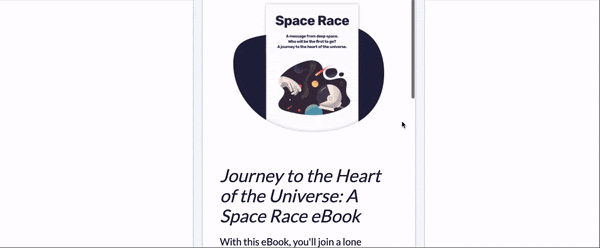
If you‘re using a CMS to make your landing page, check if the software offers dynamic content options. For example, if you find that the logo you’re using doesn’t appear well on a smaller screen, you can make the necessary adjustments.
8. If you desire, run a test to analyze page performance before pushing it live.
Finally, consider running a test on your page. Testing can show variations of your page to audiences and analyze which variations perform better. In this case, the winning page would have the most conversions.
With the software I’m using, I can choose to run an A/B test or adaptive test. Both of them achieve the same goal, with the only difference being that the first runs two different versions and the latter runs many.
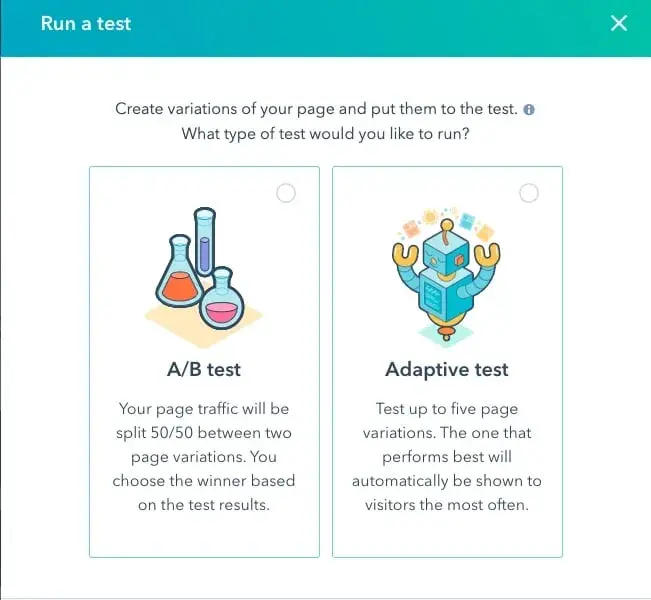
These tests will be running with a real audience, so make sure your pages look publish-ready before you begin. Be sure that the form fields work and your copy is free of any typos.
After completing these steps, your landing page is complete. I bet it looks fabulous.

Best Practices for Building a Landing Page
1. Only use one CTA per landing page.
Before you dive into building your landing page, hit pause and get clear on one thing: What’s the goal? What action do you want someone to take when they land here? Maybe it’s downloading an ebook, signing up for a free trial, or booking a call. Whatever it is, defining that goal upfront is key — it’ll guide how you write your copy, design the page, and choose the perfect call-to-action.
And while it might be tempting to include more than one CTA (I’ve seen brands like Home Chef try this), it’s rarely a good idea.
Speaking from experience as a marketer, every time I land on a page with two CTAs side by side, I catch myself rolling my eyes. It feels confusing. You want your visitors focused on one thing, not torn between options. If someone comes to download an ebook but sees another button like “Learn more about us,” they might click that instead and totally forget about the ebook.
One page, one goal, one CTA – that’s how you keep your audience on track and your landing page working the way it should.
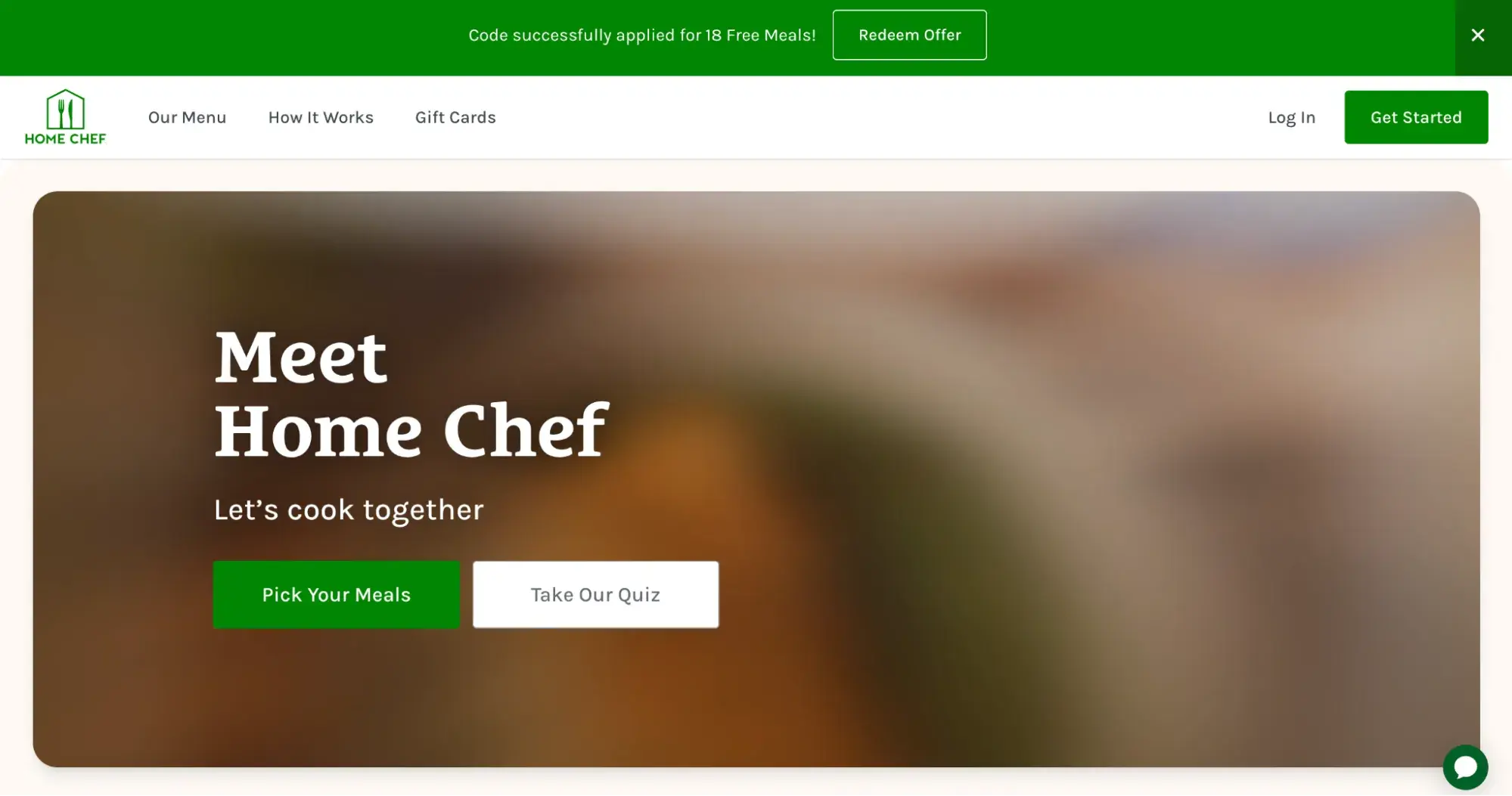
2. Only feature key information.
What’s the one thing that drives you away from a landing page the fastest? For me, it’s definitely information overload.
When I see a wall of text, I’m usually out, unless that page happens to be the only place I can get what I’m looking for. But let’s be real, that’s rarely the case. Most of the time, I can find what I need somewhere else, and I’ll always choose the site that offers a cleaner, more pleasant experience.
So, make sure your design and copy stay focused and uncluttered. Zero in on the key information your audience needs to know.
I get it, sometimes you feel like there’s just so much to say about your product or service. But trust me, you’re better off highlighting only the most important benefits. People aren’t looking to spend forever on your site — they just want to know enough to make a decision.
A strong value proposition, a few standout benefits, some testimonials, and a persuasive CTA — that’s usually all it takes to get the job done.

3. Stay authentic – don’t use stock images.
I can’t help but giggle a little when I see the same stock image popping up all over the internet; it definitely doesn’t do much for a brand’s authenticity.
Sure, using stock photos might seem like the most cost-effective option in the short term, but in the long run, it can really hurt your brand image. Inigo Rivero, managing director of House of Marketers and one of the first EMEA employees at TikTok, once told me that design is absolutely a key element to consider before launching any marketing campaign.
“In our work with TikTok campaigns and brand promotions, we discovered that simplicity and authenticity drive results. For one campaign, we transformed a generic landing page into a conversion powerhouse by replacing stock photos with real, engaging user-generated content (UGC),” he shared.
Instead of polished, overly staged visuals, they showcased raw clips of influencers actually using their clients’ products – straight from their TikTok campaigns. This change made the page feel alive and relatable, which resonated with audiences craving genuine connections.
“Visitors stayed longer, engaged more, and converted at higher rates. By showing real people using the product, we built trust,” Rivero added.
4. Remove top navigation.
Good landing page design really comes down to simplicity. One of the easiest ways to cut out distractions is by removing the top navigation bar. This helps keep visitors focused on what’s right in front of them on your landing page.
Brandy Hastings, SEO strategist at SmartSites, shared a great example with me about how they redesigned a page for one of their clients, MalpracticeOne.
“We removed the top navigation to eliminate distractions and keep users focused on conversion. The mobile version retains all critical elements: the logo, CTA, short copy, and form — with clear tap targets. We also used color contrast (teal + coral red) to draw the eye to the CTA buttons like ‘Get Quote’ and ‘Call Now’ without being overwhelming,” Hastings explained.
After that update, bounce rates dropped by 17% and quote submissions shot up by 29%. Plus, the mobile layout became much easier to scroll, with CTAs that stayed visible the whole time. This just goes to show that thoughtful design choices — like smart spacing and visual focus — aren’t just about looks. They make a real difference in how well your landing page converts.
5. Remove visual distractions around your CTA.
Your CTA can be in competition not only with other CTAs — it could also lose to distracting elements placed around it.
“I have optimized hundreds of landing pages for B2B and ecommerce, but one visual tweak consistently drives results was isolating the CTA in a contrasting color block with zero visual clutter,” Alan Muther, UX designer and marketing specialist at Ardoz Digital, told me.
“On a recent landing page revamp, I stripped the footer, removed secondary links, and surrounded the primary CTA in a solid white box against a dark background,” he said.
In this design, he featured no gradients, no shadows, and no icons. “That change alone boosted our form fills by 36% in 14 days.”
I agree with Muther that we shouldn’t give users reasons to wander around your site and choose a path that doesn’t end in your funnel. “When everything else fades to the background, the CTA becomes the hero,” he concluded.
6. Make the entire landing page copy engaging – not just the header.
Focusing on the above-the-fold of the site is a mistake I’ve seen quite a lot, especially from businesses that don’t have much website design or marketing experience.
Don’t get me wrong — nailing the top of your page is super important. It’s the first thing people see, and it plays a big role in whether they’ll stick around or bounce.
But here’s the thing: that top section is just the opener. Its real job is to spark enough interest for someone to keep scrolling. If the rest of the page doesn’t deliver, if it loses steam or doesn’t build on that momentum, people drop off. I think of it like a book with a killer first chapter that fizzles out, or a show that hooks you in the pilot but falls flat by episode three.
For me, the goal is to always make sure that the entire page tells a consistent story, not just the beginning.
7. Don’t forget to optimize your page for SEO.
Remember to optimize your landing page for SEO. Most CMS software is really good at pointing out SEO opportunities for web pages, and optimizing your page could get more traffic from queries on search engines.
For a quick starting point, to optimize my space ebook for SEO, I would make sure the ebook has an engaging, yet relevant title. I would also tag the post with relevant keywords in order to boost visibility on search engine results pages.
A great landing page makes a difference.
One of my favorite ways to learn and improve my own strategies is by observing what other brands are doing and seeing what I think works, and what I think doesn’t. How have you recently seen a landing page promoted? I’ve seen some while scrolling through LinkedIn and in email newsletters. Next time you do, take a closer look and analyze how the landing page was created.
After reading this article, I hope you’re feeling confident about how to create a landing page. With these high-level steps and my top-recommended best practices, you’re well on your way to creating an opportunity to earn more leads.
Editor’s note: This post was originally published in June 2020 and has been updated for comprehensiveness.
![]()
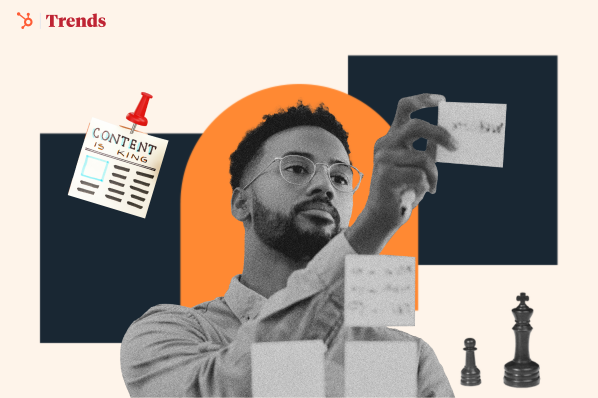
Why your startup needs a content strategy (& how to build one that scales)
A content strategy for startups begins with a simple truth: Every piece of content needs a purpose. I learned this lesson the hard way when managing my first startup blog. Armed with enthusiasm but no real plan, I spent three months writing what I thought […]
MarketingA content strategy for startups begins with a simple truth: Every piece of content needs a purpose. I learned this lesson the hard way when managing my first startup blog.
Armed with enthusiasm but no real plan, I spent three months writing what I thought were brilliant posts about industry trends. When I finally dug into our analytics, I discovered our most-shared article had exactly seven readers. Three were my team members, and the other four were probably bots.
That’s why a content strategy for startups isn’t just about creating content — it’s about building a system that attracts the right audience, nurtures trust, and drives actual results. Unlike paid ads, which stop working the moment you pause your budget, content marketing builds momentum over time, creating a sustainable engine for growth.
In this post, I’ll share how to build a content strategy that helps your startup scale, even with a lean team and limited resources. After working with dozens of startups, I’ve discovered what truly moves the needle — and what just creates busy work.
Table of Contents
What is content marketing for startups?
Content marketing for startups involves creating valuable, educational content that attracts and nurtures an audience over time. Unlike traditional marketing, which aims for immediate sales, content marketing is often a long game that builds trust, credibility, and a steady stream of qualified leads.
The investment in content marketing keeps growing. Research from the Content Marketing Institute (CMI) shows that 76% of organizations have dedicated content teams, reflecting a shift toward long-term content strategies.
Content marketing pulls double duty for startups: It boosts search visibility, establishes authority, and helps build meaningful connections with potential customers. And with 81% of B2B marketers now using AI tools, creating high-quality content at scale is more accessible than ever, even on a tight budget.
What makes a startup content strategy different?
Having worked with startups at every stage — from scrappy early days to scaling growth — I’ve seen how content strategy differs from what you’d find at an enterprise company. Startups don’t have the luxury of brand recognition or big budgets, so every piece of content has to work harder, move faster, and drive real results.
Maximizing Resources and Budget Efficiency
Startups have to do more with less — there’s no way around it. Unlike enterprise companies with dedicated content teams and hefty budgets, startups often rely on a lean team (or even just one person) to build and execute a strategy. In fact, 54% of marketers cite a lack of resources as their biggest content challenge. (Yep, I’ve been there.)
One way startups are closing the gap is through AI. HubSpot’s 2025 research shows that 35% of marketers now use AI for content creation, and I’ve found that, when used strategically, AI tools can help scale efforts without sacrificing quality.
For example, tools like Breeze, HubSpot’s AI blog writer, and Jasper can help startups create optimized content faster, while platforms like Canva make high-quality visuals more accessible.
Get started with HubSpot’s AI Blog Writer
Rapid Brand Building and Credibility
Startups don’t have years of brand equity to lean on, which means every piece of content needs to build trust and showcase expertise. According to the Content Marketing Institute, 87% of marketers say content marketing helps create brand awareness — but it has to do even more for startups.
I’ve seen startups establish credibility quickly by investing in thought leadership content, educational resources, and proof points that showcase expertise — even when case studies or testimonials are limited.
Loom’s early content strategy is a great example. It focused on video communication best practices to establish the company as an authority even before its product went mainstream.
Agility and Adaptability
In my startup roles, I’ve seen how crucial it is to pivot quickly based on market feedback and new opportunities. Unlike enterprise companies, where established processes can slow down content adaptation, startups have the advantage of agility.
That agility pays off — 74% of B2B marketers say content marketing has helped them generate demand and leads, proving that flexible strategies drive results. I’ve learned to lean into this adaptability, refining content strategies in real time as we discover what truly resonates with our audience.
Hyper-Focused Content Strategy
Large companies create broad content for multiple segments, but I’ve found that startups succeed by owning niche topics and speaking directly to their ideal audience. Instead of casting a wide net, the most effective startup strategies dive deep into specific pain points and provide high-value, actionable insights.
For instance, Ahrefs built its early content strategy around in-depth SEO guides that catered to digital marketers — a focused approach that helped it compete against much bigger SEO platforms.
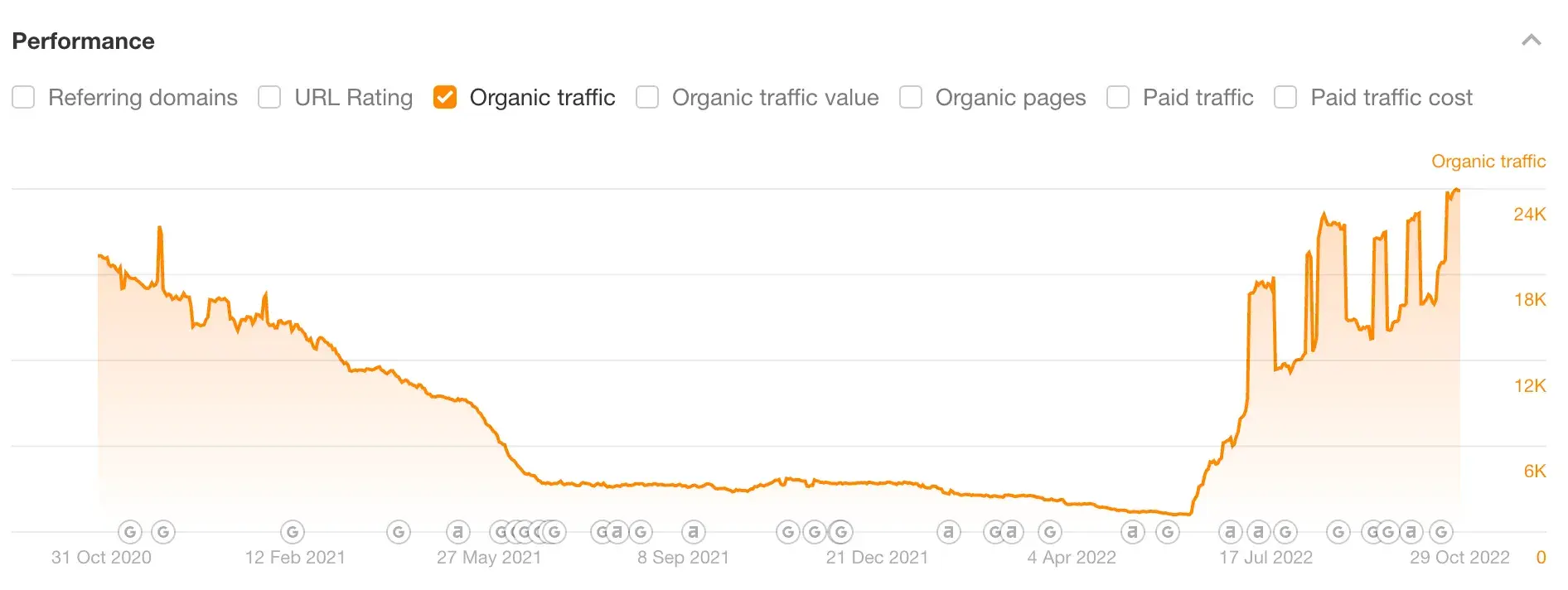
Why do startups need a content strategy?
After working with startups for over a decade, I’ve personally discovered that a solid content strategy isn’t just a nice-to-have — it’s what keeps a business afloat and fuels growth. I’ll walk you through why, backed by data and experience.
Building Credibility and Thought Leadership
Quality content helps startups stand out, even against industry giants. I’ve seen how a focused content strategy builds trust and positions a company as an expert. But without clear direction, teams often struggle — 42% of marketers say unclear goals are a major challenge. Having a well-defined strategy is what turns content into a real growth driver.
One of my favorite examples is First Round Capital, a venture capital firm that built a reputation as a thought leader through its First Round Review blog. Instead of pushing self-promotional content, they share deep, tactical insights from founders and operators, making their content a must-read for startups.
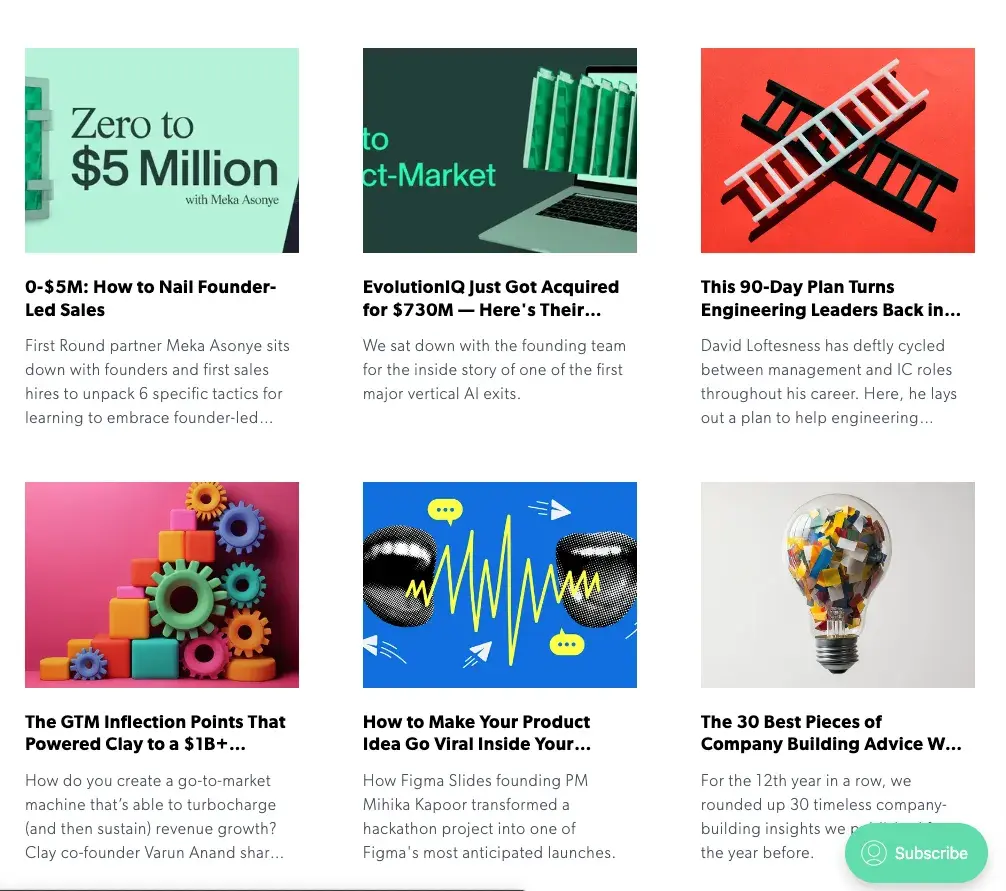
Driving Organic Growth (Without a Big Ad Budget)
One of the biggest challenges startups face is getting noticed without spending a fortune on ads. I’ve worked with teams that tried to outspend bigger competitors, but the results were short-lived. The real long-term wins came from content — especially when optimized for search.
HubSpot’s 2025 State of Marketing research shows that visual and interactive content, like short-form videos and live streaming, are among the most effective formats for driving engagement.
I’ve seen how even a single well-placed tutorial or social post can drive steady inbound traffic over time. Take Notion, for example — the company built a following through blog posts, video tutorials, and user-generated content that naturally showcased their product’s value. Instead of pushing ads, they create content people actively seek out, making it easier to grow an audience organically.
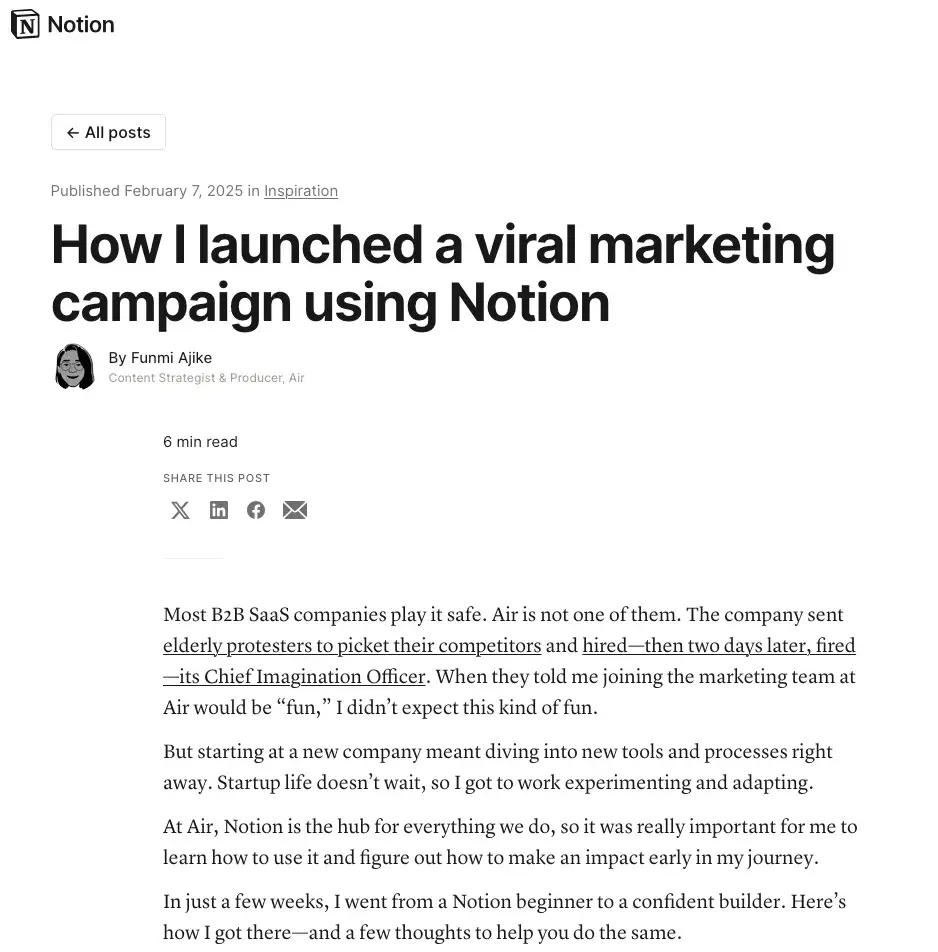
Customer Acquisition and Engagement
Attracting leads is just the start — what really matters is keeping them engaged. That’s where content marketing shines. It’s not just about bringing people in; it’s about giving them a reason to stick around. That’s probably why 96% of marketers say personalized content helps drive sales.
Startups, in particular, have an edge here. They can tailor content directly to their audience’s pain points without the layers of approvals that slow larger companies down. I’ve seen this firsthand — when a content strategy aligns closely with what potential customers actually need, the impact is immediate.
Zapier’s blog is a perfect example. It walks readers through real-world workflows, showing how Zapier’s product fits naturally into solving everyday problems. I remember coming across one of their guides when trying to streamline a project, and by the end of it, I wasn’t just informed — I was convinced Zapier was the right tool for the job.
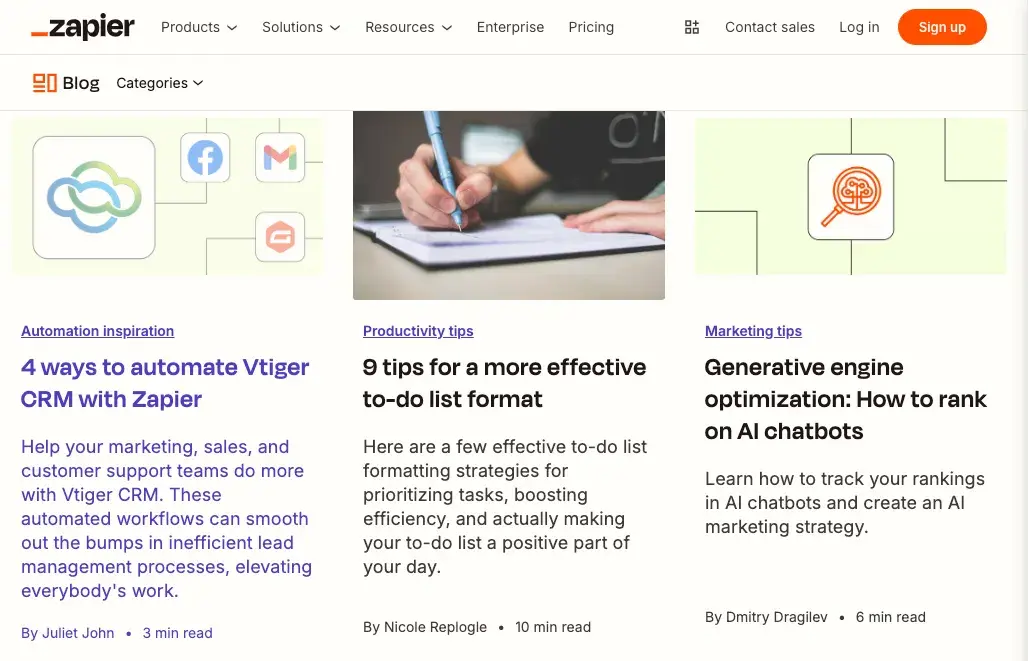
Cost-Effective Market Penetration
I’ve worked with startups where every dollar counts, and content marketing has always been one of the most budget-friendly ways to break into competitive markets. In fact, according to CMI, B2B marketers who consider their content strategies highly successful are more likely to:
- Generate demand and leads.
- Nurture subscribers, audiences, and leads.
- Grow loyalty with existing customers.
- Drive sales and revenue.
Canva’s Design School is a great example of using content to drive growth without a huge ad budget. By offering free design courses and tutorials, Canva attracts new users and shows them the value of its tools.

Building a Community (and Brand Loyalty)
The best startups don’t just sell a product — they create a space where customers feel like they belong. I’ve seen how startups that invest in community-driven content often gain something far more valuable than just engagement: genuine advocates. When people feel connected to a brand, they don’t just buy — they share, recommend, and rally around it.
The best startups don’t just sell a product — they create a space where customers feel like they belong. I’ve seen how this plays out. When startups focus on creating content that truly resonates, they don’t just attract buyers; they build lasting relationships. That’s often what separates a forgettable brand from one people rave about.
Glossier is a perfect example. Instead of relying on traditional marketing, it turned its customers into a community. By amplifying user-generated content and fostering conversations around beauty experiences, they built a brand where people don’t just use their products — they actively promote them.
It’s a reminder that great content isn’t just about what a brand says — it’s about how it invites people to be part of the story.
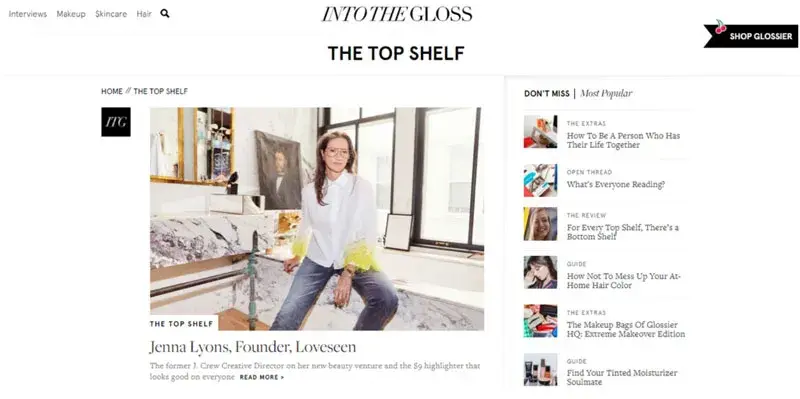
How to Create a Startup Content Marketing Strategy
Creating an effective content strategy requires both data-driven planning and hands-on execution. While 76% of organizations have dedicated content teams, most startups operate with limited resources.
I’ve learned through experience that a solid content strategy doesn’t have to be complex — it just needs to be intentional. Here’s how to build one that drives real results.
1. Define your core content mission.
Understanding your audience is the foundation of a great content strategy. In fact, 82% of top-performing content marketers credit their success to knowing their audience deeply. But that kind of connection doesn’t happen by accident — it starts with a clear content mission statement, a guiding principle for every piece you create.
I like how Andy Crestodina from Orbit Media simplifies this into a straightforward formula: “Our company [or blog or site] is where [Audience X] finds [Content Y] for [Benefit Z].”
Here’s how Orbit Media applies it:
“The Orbit blog is where digital marketers find practical advice on content marketing, AI, GA4, and web design. Our goal is to help you get better results from the web.”
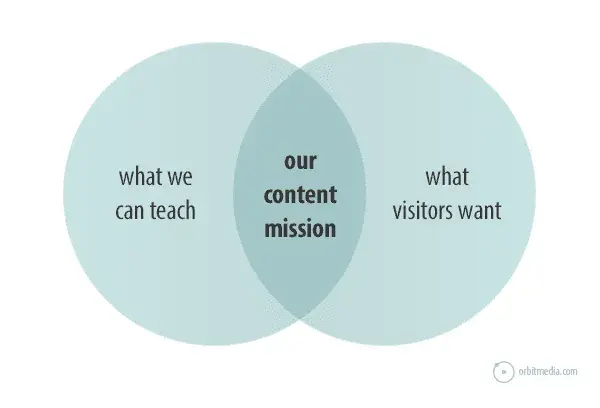
Moz’s blog takes a similar approach with its mission statement:
“The industry’s top wizards, doctors, and other experts offer their best advice, research, how-tos, and insights — all in the name of helping you level up your SEO and online marketing skills.”
Notice how it clearly defines:
- Who it’s for: Digital marketers.
- What it delivers: Expert advice and research.
- The benefit: Helping readers improve their SEO and marketing skills.
From my experience working with startups, the best content missions are specific about who they serve, focus on the unique value they provide, and connect to measurable business outcomes. Having this mission visible and referenced regularly keeps content focused and prevents the common trap of creating content that doesn’t align with business goals.
2. Conduct strategic audience research.
Understanding your audience isn’t just about creating buyer personas — it’s about knowing what truly matters to them. What questions are they asking? Where do they turn for advice? What problems keep them up at night?
Yet, 29% of marketers say ineffective audience research is a major reason their content strategies fall flat. Here are some practical ways to gather real audience insights instead of relying on assumptions.
Quantitative Research (Data-Driven Insights)
- Google Analytics. Identify which content drives the most engagement.
- AnswerThePublic. Study search intent and common user questions.
- Sprout Social or Hootsuite. Track social listening trends and sentiment.
- SparkToro. Analyze where your audience hangs out online.
Qualitative Insights (Direct Feedback & Observations)
- Customer surveys. Aim for 100+ responses to spot patterns in content preferences.
- Customer interviews. Talk to 5-10 real customers (a small incentive helps with participation).
- Subreddits and Discord channels. See what your audience is discussing in real time.
- Sales call recordings. Look for recurring questions and pain points.
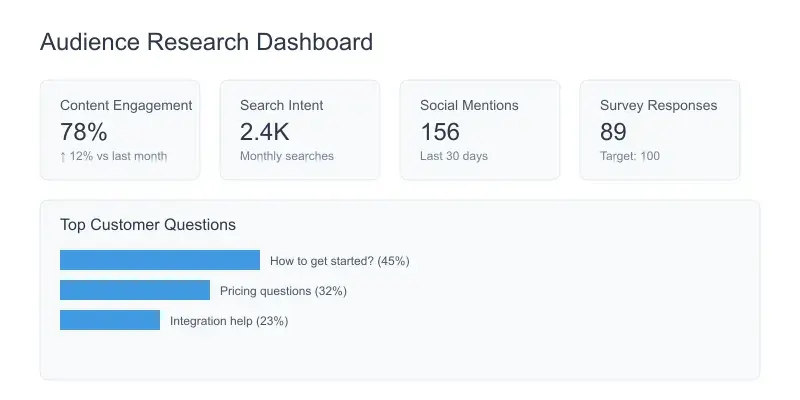
Key Metrics to Track
- Content engagement rates by topic.
- Time spent on different content types.
- Social sharing patterns.
- Email click-through rates by subject.
- Community discussion themes.
- Customer support ticket topics.
I’ve learned that spending extra time on research upfront saves countless hours later. When you deeply understand your audience, you’re not just guessing what they need — you’re delivering content they’ll actually care about. And often, this research uncovers content opportunities your competitors completely overlook.
3. Map your content strategy to the buyer’s journey.
One of the biggest mistakes I see startups make is creating content randomly without tying it to where buyers are in their decision-making process. Yes, it’s tempting to just publish and hope something sticks when you’re moving fast.
But, personalization only works when content meets buyers where they are. That, again, is probably why 96% of marketers say personalized content experiences increase sales.
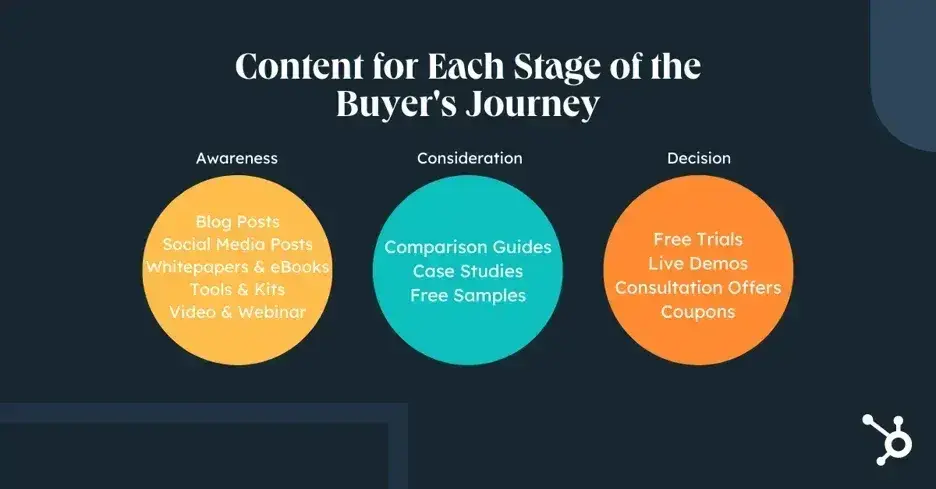
The buyer’s journey typically follows three stages, and your content should guide prospects seamlessly through each one.
Awareness Stage – “I have a problem, but I don’t know much about it yet.”
At this stage, buyers are just starting to recognize a problem exists. They’re not looking for solutions yet — they’re looking for information. Your content here should focus on education and industry insights, not selling.
Best content types:
- Educational blog posts breaking down industry challenges.
- Thought leadership content.
- “What is” and “Why” content that helps define the problem (e.g., “What is SEO and Why Does It Matter?”).
Example: Ahrefs does this well by creating comprehensive guides on SEO fundamentals. Their content attracts beginners who are realizing they need SEO solutions — long before they’re ready to choose a tool.
Consideration Stage – “I know my problem. Now, I’m exploring possible solutions.”
Buyers in this stage are actively researching how to solve their problems and comparing different options. This is where you want to provide in-depth, solution-focused content.
Best content types:
- Detailed how-to guides.
- Solution comparisons (e.g., “HubSpot vs. Salesforce”).
- Expert perspectives on different approaches.
At this stage, the goal isn’t to push your product — it’s to help buyers understand their options and why certain solutions might be a better fit.
Decision Stage – “I’m ready to buy. Now I need to choose the right solution.”
Now, buyers are evaluating specific products or services. They’re looking for reassurance that they’re making the right choice, so your content should focus on proof and guidance.
Best content types:
- Product demos and implementation guides.
- Case studies, testimonials, and ROI calculators.
Pro Tip: Think Beyond the Sale
I’ve seen too many startups focus all their content efforts on attracting new customers while completely overlooking the people who’ve already bought in. That’s a missed opportunity. The customer journey doesn’t end at the sale — it’s just getting started.
Some of the most effective content I’ve worked on wasn’t aimed at leads but at existing customers. Onboarding guides, advanced tutorials, and user communities don’t just improve retention — they turn customers into advocates. When people feel supported and continue to get value long after they’ve signed up, they’re much more likely to stick around, renew, and even refer others.
So, while mapping content to the buyer’s journey is essential, don’t forget about the customer journey, too. A strong post-sale content strategy keeps your audience engaged, builds loyalty, and fuels long-term growth.
4. Choose the right content strategy framework.
A strong content strategy isn’t just about publishing — it’s about having a clear, documented plan that aligns with your goals. In fact, top-performing content marketers are twice as likely to have a documented content strategy with well-defined focus areas.
However, in a startup, too much structure can slow you down, while too little can lead to scattered, ineffective content. Finding the right balance is key.
Traditional content pillars have been a go-to approach for years, but newer frameworks are shifting the focus toward problem-solving and storytelling. Here are three content strategy frameworks startups can use, each with its own strengths depending on your goals and resources.
Traditional Content Pillars
The content pillars approach organizes content around three to five core topics that closely align with your expertise and market needs. It’s a structured, SEO-friendly way to establish topical authority while ensuring content efforts stay focused.
Example: A B2B software startup might build content pillars around:
- Remote team management.
- Workplace productivity.
- Digital communication tools.
Each pillar then branches into subtopics, creating a content hierarchy that helps guide creation and strengthens search visibility.
Why it works: It provides clarity and a strong foundation for scaling content.
Potential downside: It can feel rigid, limiting adaptability to emerging trends or audience feedback.
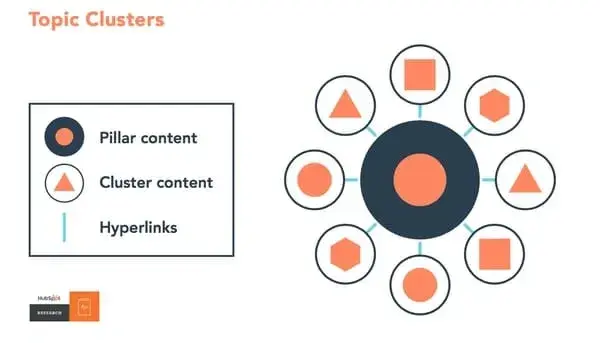
The MP3 Framework
While the pillar approach provides clear direction and helps with SEO organization, Erica Schneider, founder of Cut the Fluff and content coach for solopreneurs and founders, explains in her newsletter, “When you’re stuck in the ‘pillar’ mindset, you start writing what you think you should write, not what actually matters.”
That’s why Schneider created the MP3 Framework, which structures content around three key elements:
- Market the problem. Clearly articulate customer pain points (sometimes better than they can themselves).
- Market the process. Share real implementation experiences and behind-the-scenes insights.
- Market the proof. Demonstrate tangible results and transformations.
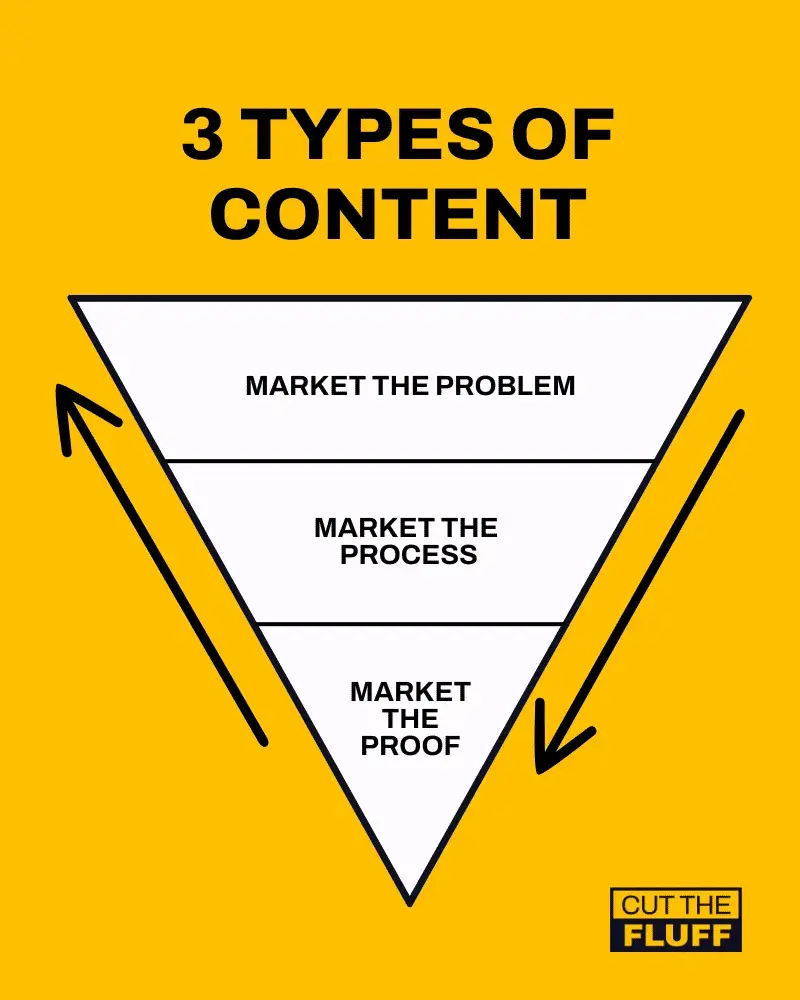
I love this approach because it focuses less on rigid topics and more on what resonates with an audience in real time. It’s especially useful for startups where storytelling and credibility play a huge role in brand-building.
Flexible Hybrid Approach
If you like the structure of content pillars but want more flexibility, this approach blends both. Ashley Faus, head of lifecycle marketing at Atlassian, suggests structuring content around three to five broad conceptual areas rather than rigid, topic-based pillars. This allows for flexibility within a framework, so content can flow naturally across multiple themes while staying strategically aligned.
Instead of strictly categorizing content into fixed silos, this approach maps content to overlapping themes, or “content depths,” where the most engaging and insightful ideas often emerge. For example, a startup in the productivity space might have conceptual areas like:
- Collaboration in remote teams.
- Personal productivity habits.
- The future of work.
Rather than limiting content to one category, this model allows for cross-topic exploration, so a piece on remote work could tie into productivity habits or industry trends without feeling forced into a single pillar.
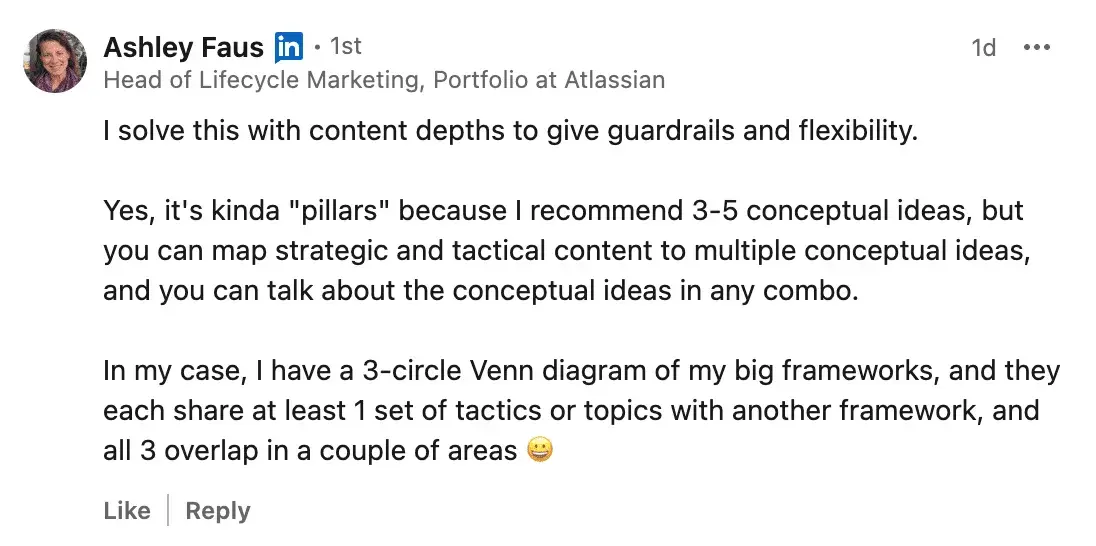
Which framework should you choose?
There’s no one-size-fits-all answer. The best approach depends on your startup’s goals, resources, and audience needs. Through my experience at several startups, I’ve found that success comes from maintaining enough structure to stay focused while staying flexible enough to evolve.
Content pillars are a solid foundation if your goal is SEO and authority-building. If you want to lean into storytelling and real-world impact, the MP3 Framework may be a better fit. And if you need a structured-yet-adaptive model, the hybrid approach offers the best of both worlds.
At the end of the day, your framework should serve your strategy — not the other way around.
5. Build a scalable content operations model.
I’ve learned that content operations don’t need to be complicated to be effective. What matters most is having clear, repeatable processes that match your team’s size and capabilities. In fact, 54% of successful content teams operate with just two to five people, proving that impact doesn’t require a massive team.
Startups evolve quickly, and content operations need to keep up. Here are three models that I’ve seen work well at different growth stages.
The Lean Creator Model
For early-stage startups, keeping things simple is key. I’ve seen small teams succeed by using just a shared Google Doc for planning, Trello for tracking, and Slack for communication. The goal isn’t to build complex systems upfront — it’s to create workflows that can scale later.
Instead of worrying about structure overload, focus on three core elements: planning, creation, and distribution.
The Growth-Stage Model
As your startup grows, so does your content operation. This is when organization and consistency become critical. I’ve seen teams at this stage thrive when they implement:
- A dedicated content calendar with clear ownership.
- Editorial guidelines to maintain quality and consistency.
- Regular content planning meetings to stay aligned.
- Basic performance tracking to measure what’s working.
This model adds structure without becoming overwhelming, making it easier to scale content efforts without chaos.
The Scale Model
At this stage, content production extends beyond the marketing team, requiring collaboration across the company. Many successful startups adopt a centralized content operations model, where:
- A core content team owns the strategy, execution, and editorial process.
- Subject matter experts (SMEs) from across the company contribute insights, ensuring content is informed by real expertise.
This setup helps teams scale efficiently without sacrificing quality. However, it’s worth noting that 33% of B2B marketers find accessing SMEs challenging, highlighting the need for effective collaboration strategies.
In my experience, fostering strong relationships with SMEs and establishing clear communication channels are crucial steps in overcoming these challenges and creating valuable content.
At this stage, robust systems become essential to keep content production running smoothly. I’ve found that tools like HubSpot’s CMS and Breeze (AI) for content automation, Airtable for editorial tracking, and ClickUp for managing workflows make a huge difference in staying organized as production scales. As teams grow, documenting processes becomes crucial for maintaining quality and consistency.
Pro Tip: Build for Growth, Not Complexity
I’ve seen startups struggle when they try to implement enterprise-level systems too early. The most effective content operations grow organically with the business, adapting to new needs rather than forcing complexity before it’s necessary. Start with the model that fits your current stage, but build in flexibility to evolve as you scale.
6. Choose and prioritize the right content channels.
Not every content channel is worth your time — especially in a startup where resources are limited. According to HubSpot’s State of Marketing 2025 research, short-form video (21%), images (19%), and live streaming (16%) deliver the highest ROI across all content formats. But instead of chasing trends, successful startup content strategies focus on channels that align with three key factors:
- Audience behavior. Where does your audience actually spend time?
- Team capabilities. What formats can you realistically create at a high level?
- Business goals. Which channels support long-term growth and conversions?
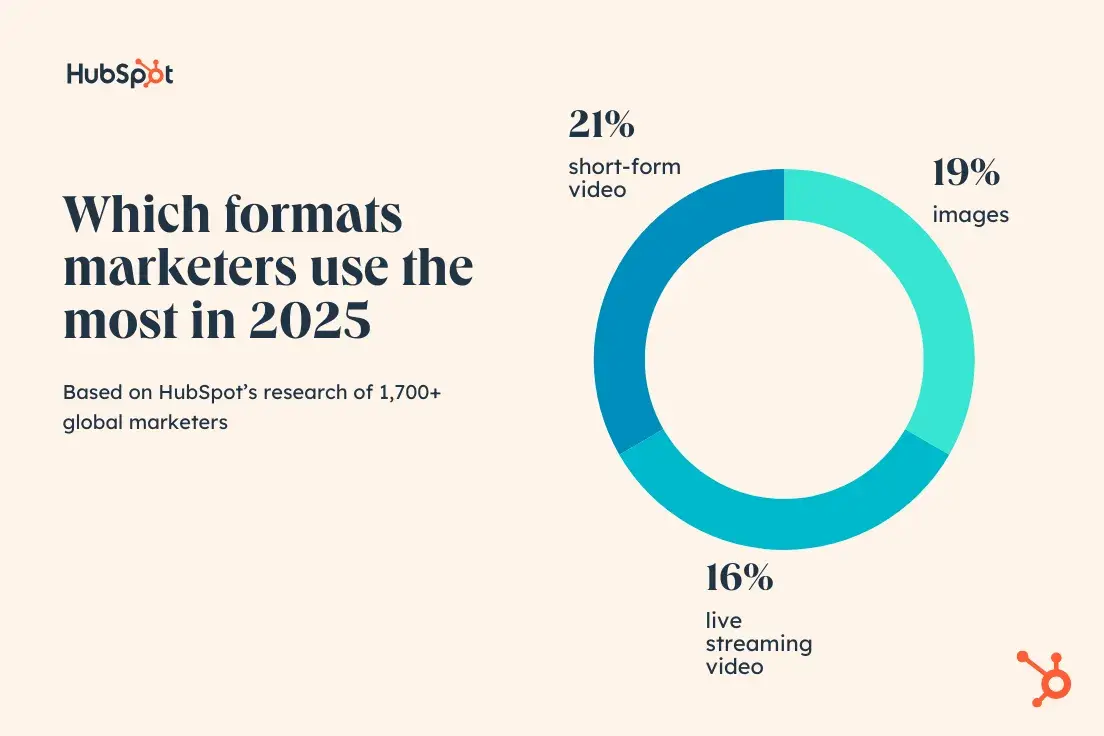
Owned Media Foundation: Your Website as the Hub
Your website and blog serve as your content hub, providing long-term SEO value and a platform you control. Every other channel should support and drive traffic back to this foundation.
For early-stage startups, I’ve found that investing in high-quality website content often delivers the most sustainable results. Organic search visibility compounds over time, unlike social media, where content lifespan is short. A strong, owned media foundation ensures that all other marketing efforts have a reliable, evergreen home base.
Strategic Channel Selection: Quality Over Quantity
Instead of trying to be everywhere, consider a focused approach. Choose one channel to master based on where your audience spends time and your team’s strengths. For B2B startups selling complex solutions, this might be LinkedIn and long-form content. For consumer products, Instagram or TikTok might make more sense.
Then, add a support channel or two that complements your primary channel. For example, an email newsletter can help nurture relationships with blog readers, while a targeted social media presence can amplify your reach.
Through my work with startups, I’ve learned that channel effectiveness often follows the 80/20 rule — 80% of your results will come from 20% of your efforts. Focus on mastering one channel before expanding to others.
7. Optimize your content creation workflow.
Only one in three marketers report having a scalable content creation model. The challenge isn’t just creating content — it’s producing high-quality content quickly without burning out your team.
Strategic Planning
I like to start each piece with a clear brief that outlines:
- Strategic purpose and target audience.
- Primary keyword and search intent.
- Key points and unique angle.
- Competitor analysis to differentiate.
- Required research/assets (images, stats, examples).
- Call-to-action and distribution plan.
I’ve found that front-loading planning actually speeds up content creation — it prevents the common startup pitfall of publishing content that lacks focus.
Smart Resource Optimization
Instead of treating each content piece as a one-and-done effort, I plan for repurposing before I even start writing.
For example, if I’m working on a detailed how-to guide, I don’t just think about the blog post — I also outline:
- Key takeaways that will make strong social media posts.
- Snippet-style insights that could be repurposed for an email newsletter.
- Core messaging that could translate into a sales enablement resource.
This approach unlocks the full potential of content while making it easier to scale content production without extra effort later on.
Quality Control Framework
To maintain consistency, I follow a three-step review process before publishing:
- Technical review. Fact-checking, accuracy, and completeness.
- Editorial review. Grammar, spelling, readability, and brand voice consistency.
- Final check. SEO optimization, visual elements, and distribution readiness.
I’ve found that spelling and grammar issues can undermine credibility, even in otherwise well-researched content. Readability also matters — content should be scannable and easy to digest, especially for busy decision-makers.
This structured approach ensures every piece meets high standards before it goes live.
8. Measure and refine content performance.
Tracking the right metrics ensures you’re not just creating content but creating the right content that delivers actual results. The best content teams don’t just measure success — they use data to continuously refine their approach.
Key Metrics to Track
- For awareness: Social shares, organic traffic growth.
- For engagement: Time on page, comment quality, bounce rate.
- For conversions: Leads and sales attributed to content.
I’ve found that mixing quantitative and qualitative insights gives a more accurate picture of what’s working. High traffic doesn’t mean much if engagement is low, and engagement isn’t enough if content isn’t driving conversions.
Quarterly Content Audits & Optimization
A quarterly content review helps keep your strategy aligned with business goals and audience needs. During these audits, I focus on:
- Updating high-performing content with fresh data to keep it relevant.
- Identifying content gaps in the buyer’s journey that need to be filled.
- Finding repurposing opportunities to maximize existing content.
- Revising underperforming content to improve engagement and conversions.
This process isn’t just about fixing what’s broken — it’s about doubling down on what works and evolving with audience behavior.
Refining the Content Funnel
Understanding how content moves prospects through the funnel is just as important as tracking performance. I analyze:
- Which content drives the most conversions?
- Where do prospects drop off?
- Are there missing content pieces that could fill gaps?
This insight helps fine-tune both content creation and distribution strategies over time. It also ensures resources are focused on content that actually moves the needle instead of just generating vanity metrics.
9. Distribute and promote your content.
Content success relies as much on distribution as creation. HubSpot’s 2025 research reveals that successful marketers spend as much time on content distribution as they do on creation. Through my startup experience, I’ve found that thinking about distribution before you create content helps ensure every piece reaches its full potential.
Create Once, Distribute Strategically
Think of your content as a valuable asset that deserves multiple spotlights. A single in-depth blog post can become a series of social posts, an email newsletter feature, and talking points for your sales team. This approach not only maximizes your content’s impact but also makes the most efficient use of your resources.
When it comes to immediate distribution, focus on three key channels:
- Your owned platforms (website, blog, email list).
- Social media (based on where your audience spends time).
- Community spaces where your target users gather.
Your ongoing promotion strategy should look beyond the initial push. I recommend setting up a system for:
- Regular content refreshes with fresh data and insights to keep high-performing pieces current.
- Strategic internal linking between related content to create topical authority.
- Relationship building with industry influencers and media.
Cross-channel amplification requires thinking beyond simple resharing. Consider how content can be transformed for different platforms. As I mentioned above, short-form video (21%), images (19%), and live streaming (16%) deliver the highest ROI according to HubSpot’s research.
But rather than chasing every format, focus on mastering channels where your specific audience is most engaged.
10. Continuously optimize.
Content strategy isn’t a set-it-and-forget-it exercise. CMI’s research found that while 58% of B2B marketers rate their strategies as only “moderately effective,” those who regularly optimize see better results. Through my work with startups, I’ve learned that small, consistent adjustments lead to major long-term gains.

Each quarter, I recommend reviewing:
- Performance metrics. What’s driving traffic, engagement, and conversions?
- Resource allocation. Are efforts aligned with the highest-impact channels?
- Content pillar relevance. Are core topics still resonating?
- Emerging opportunities. What trends or audience needs should we address?
- Tech and tools efficiency. Are systems streamlining or slowing things down?
Understanding how content moves prospects through the funnel helps refine both creation and distribution strategies. The best content teams continuously evolve their processes, tools, and strategies based on real audience data and feedback.
Startup Content Strategy Tips
Developing a content strategy is one thing — executing it successfully is another. That’s why I always appreciate insights from experts who’ve been in the trenches. One of those experts is Kris Hughes, a content strategist with his own digital strategy consulting firm, who has a track record of turning content into real business results.
His approach to content creation is rooted in authenticity, strategy, and consistency. If you’re looking to refine your content strategy and drive meaningful engagement, his advice is worth noting.
Here are Hughes’ six tips for nailing your content strategy to generate solid, authentic leads.
1. If you don’t tell your brand’s story, someone else will.
As a founder with a million priorities, content like blogs and social media posts can seem like low-priority items.
But if you don’t tell your brand’s story, someone else will make assumptions and tell it for you.
Don’t sit on your hands when it comes to content. Your story and voice need to:
- Be authentic.
- Feel natural to you.
- Make sense to your target audience.
Pro tip: Look at your competitors — are they clearly telling their story? If not, they’re leaving content gaps you can fill to establish authority in your space.
2. Do a thorough brain dump.
Spend ~30 days on a “brain dump” exercise, using voice notes and free-form writing. Record every thought you have about your brand, then pass it on to someone close to your business but not a part of it.
Ask them what they see from the outside looking in. What words are used over and over again? What topics keep returning? This deep-dive step is vital for two reasons.
First, Hughes says, “People are their own worst marketers. There’s probably a ton about your own brand story you’re not telling. The deep dive and outside perspective bring this to the surface.”
Second, this exercise will spin off aligned talking points so that you can hit the ground running with a clear strategy and bank of great content — in your own words.
3. Extrapolate four key pillars for your content.
Sift through your brain dump and organize each idea, spicy quote, or topic into one of four pillars:
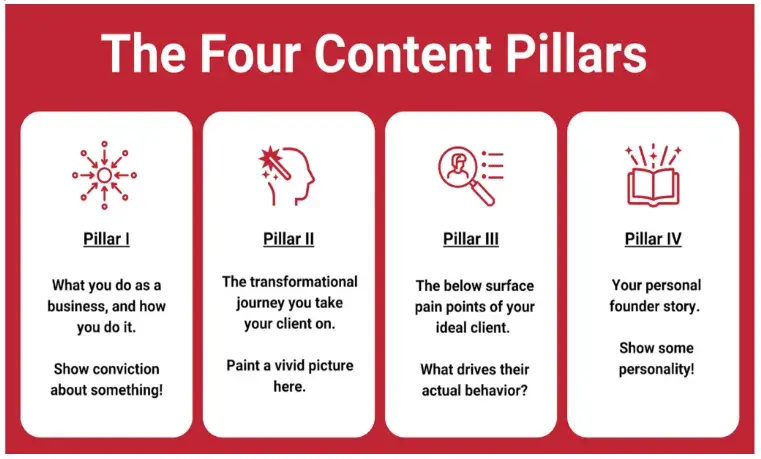
Each pillar gives rise to specific types of content, and alternating between them will ensure the topics you speak about remain varied and fresh, but also on brand.
For example, one week, you may talk about the results you’ve driven for a client (Pillar II), and the next share some of your founder story (Pillar IV).
And if you ever get writer’s block, you can return to your pillars as inspiration and a reminder of what you want to convey to your audience.
4. Focus on community-building before you put out content.
Create a community from the get-go by interacting with your ideal clients, competitors, and peers through value-driven comments and messages.
This step gets you comfortable with how you write, how you portray yourself, and how people receive you.
Keeping track of comments you make (e.g., in Notion) will also ensure you have a content ideas bank; most valuable comments can usually be bulked up into a post.
5. Now, you can get your content out there.
Use your pillars, saved comments, and brain dump to generate content that is authentic to your brand. Remember to:
- Have a clear KPI. Is your content to build generalized awareness or drive leads?
- Develop a voice guide, a resource guide, and a content calendar.
Hughes is an advocate of scheduling content to make sure you get it out there. While the cadence and approach of posting will depend on the platform, consistency is always key.
6. Remember: Content is a long game.
It takes time to build up a reputation to the point where your content drives leads. Keep at it.
“Many founders come in guns blazing with high energy and then fizzle out after a few months,” says Hughes. You’ll miss the magic if you do. Stay motivated by:
- Setting new benchmarks.
- Focusing on positive feedback.
- Reusing your top-performing posts every few months.
As a final tip, Hughes suggests talking to your customers when things are going well.
“We tend to reach out only when we need to put out fires,” he told us. “But getting client feedback during the good times means you’ll find room for incremental improvement — when you have the capacity to act on it.”
Positive customer transformation journeys are powerful additions to your brand story.
Building Content Strategies That Last
I’ve been reminded of a crucial truth through researching and writing this piece: There’s no one-size-fits-all approach to content strategy. While the fundamentals remain constant — understanding your audience, creating valuable content, and measuring results — what works for one startup may not work for another.
The data mirrors my own experiences in the field. With 58% of B2B marketers viewing their content strategies as only “moderately effective,” it reinforces something I’ve noticed time and again: Success isn’t about having the biggest budget or the fanciest tools. It’s about being thoughtful with your resources and truly understanding your audience’s needs.
If there’s one thing I hope you take away from this guide, it’s that building a successful content strategy isn’t about doing everything at once. Start with one channel, excel at it, and expand thoughtfully. Whether you’re a solo founder or leading a small marketing team, remember that every piece of content you create is an asset that can continue delivering value long into the future.
Editor’s note: This post was originally published in September 2024 and has been updated for comprehensiveness.
![]()
How to work from home: Simple strategies for staying productive
Figuring out how to work from home feels easy, right up until the cat throws up on your computer. And your neighbor, who you can only assume is building a time machine, starts firing up all sorts of power tools. In those moments, remote work […]
MarketingFiguring out how to work from home feels easy, right up until the cat throws up on your computer. And your neighbor, who you can only assume is building a time machine, starts firing up all sorts of power tools. In those moments, remote work life feels more like a punishment than a miracle.
Remote work poses benefits and risks. When I began working remotely as a digital nomad in 2017, there was still professional pushback, skepticism, and a general dismissive attitude toward remote work. Since then, I’ve been remotely working abroad, and I’ve even published a book on the topic. The workforce was forced to catch up in 2020, and now remote work finally has the culture cachet it’s always deserved.
Remote work isn’t a trend; this lifestyle is a long-term choice that allows us to get exactly what we want out of our careers. You may need some help greasing the wheels, but I’m determined to help you feel the same about your remote work lifestyle.
Not everyone transitions into remote work smoothly, and that’s okay. Let’s explore the remote work trends, tips, and techniques that can help you get the most out of your remote work.
Table of Contents
Remote working encompasses people who work from home and also digital nomads who work from Airbnbs or hotels around the world. Some remote workers make this choice to increase freedom and flexibility, or meet financial goals. Others choose remote work to help meet their physical needs, mental health needs, or family demands.
Employers benefit when hiring remote workers because they can have an infinitely larger talent pool to pull from. Still, there’s pushback. Some companies insist that their employees must work in-office, even if it’s not necessary to do their job. The culture of remote work is still actively evolving, and it won’t ever stop.
What Remote Work Looks Like Today for Marketers [Data]
Working remotely can take many different forms, but what does it look like for the “normal” remote marketer?
From where remote workers work to how they’re getting dressed and how they interact with their team members, let’s see what the statistics say about remote workers today.
- Information, finance/insurance, and professional and business services have the largest remote and hybrid workforces. (WFH Research)
- More than 95% of U.S. workers report wanting some form of remote work options, either fully remote work or hybrid. (FlexJobs)
- The pandemic sped up remote work by an estimated 40 years. (WFH Research)
And what does the data say about marketers who work remotely? These statistics are from HubSpot’s 2024 Marketing Work Culture Survey:
- Of marketers surveyed, 31% work remotely.
- Of marketers surveyed, 37% are hybrid employees, sometimes working remotely and sometimes working in the office.
- Of marketers surveyed, 41% said that their company hosted virtual team-bonding activities in the past year, such as parties, celebrations, or games.
- When asked about getting dressed for work, 13% of surveyed marketers said they wear an appropriate top for Zoom calls and remain in sweatpants since they’re off-screen in video calls.
- Since the pandemic, 27% of surveyed marketers said that they feel more overworked, primarily due to heightened work responsibilities.
- When asked about what led to conditions of overworking, 9% of surveyed marketers said that hybrid or remote work contributed because it made some team tasks more difficult.
Types of Remote Work
Today, remote workers all over the world will open their laptops in radically different work environments.
Some will do so from a home office, a hotel room, or an airplane 30,000 feet above the middle of nowhere. The remote environment can take almost any form.
When we look closely at the different types of remote work, two primary categories arise: working from home and working from anywhere.
Work From Home
Remote work is most commonly done from home. Remote workers who tune into work from home may do so from their beds, kitchen tables, or tailored home offices. The process can be as minimalistic or customized as you can imagine.
This type of work melds your personal space together with your workspace, making a healthy work–life balance difficult to achieve. Overworking and underworking can become problems.
There are many benefits to working from home, but it also has unique challenges. People who work from home have to remain productive yet still make time for regular breaks and time away from the computer screen.
The average worker invests a lot of time and thought into developing their most productive work zone and refining their work style. I’ll discuss practical tips and best practices for working from home in a moment.
Work From Anywhere
Remote workers who work from anywhere have to manage their work–life balance the same as everyone else, but they do so while working from a revolving door of locations.
Work from anywhere workers may tune into work from their kitchen table, cafes, coworking spaces, local libraries, or Airbnbs across the world. I’m currently writing this article from a sunny apartment balcony in a small coastal town in Spain (though it’s not usually this idyllic).
Remote workers who combine work with travel are called digital nomads, and they can be found working all over the world today.

I became a digital nomad in 2017. At first, I was drawn into the lifestyle for the opportunity to travel. But something bigger motivates me to maintain a remote work life now: The increased freedom in every area of my life.
“The conversation is much richer, much deeper, and more nuanced than just traveling,” said Mitko Karshovski, founder of the remote work newsletter, Remote Insider. “Flexibility is the true underlying theme.”
Getting a Remote Job
There are three main doors to choose from when you’re looking to transition into remote work.
Pivot from in-office to remote.
If you like your current job, the ideal solution would be pivoting from in-office to remote. Consider discussing this with your manager at the next promotion cycle or performance review (assuming the conversation about your performance is positive).
You won’t be negotiating from a position of strength if tasks and emails have been slipping through the cracks. I’ll share my top tip for staying organized in a moment.
Be prepared to compromise in this discussion, potentially starting with a trial where you work from home for two days a week and then reevaluate at a predetermined time. When your boss sees how productive you are, they might feel more at ease letting you work from home more days of the week.
Join a remote-friendly company.
When looking for a work-from-home job, you can use channels like job sites, local job ads, and social media platforms. Job sites that list work-from-home ads include:
You can also go straight to the source: Job listings by companies that hire remote employees. Some remote-friendly firms include:
Explore freelancing and self-employment.
If your current job isn’t remote work-friendly, you can explore going remote by starting your own business as a freelancer or a consultant. Depending on the nature of your current job, you may be able to start your own freelance business while still being employed.
This is how I started working remotely: I began to write articles in the evenings and on the weekends to develop that income stream while I still had a nine-to-five in-office marketing role.
The benefit of starting your freelance business while still employed is that it reduces the financial strain experienced by any new business. It can also obliterate work–life balance and take away crucial time from family, hobbies, etc.
How to Work From Home
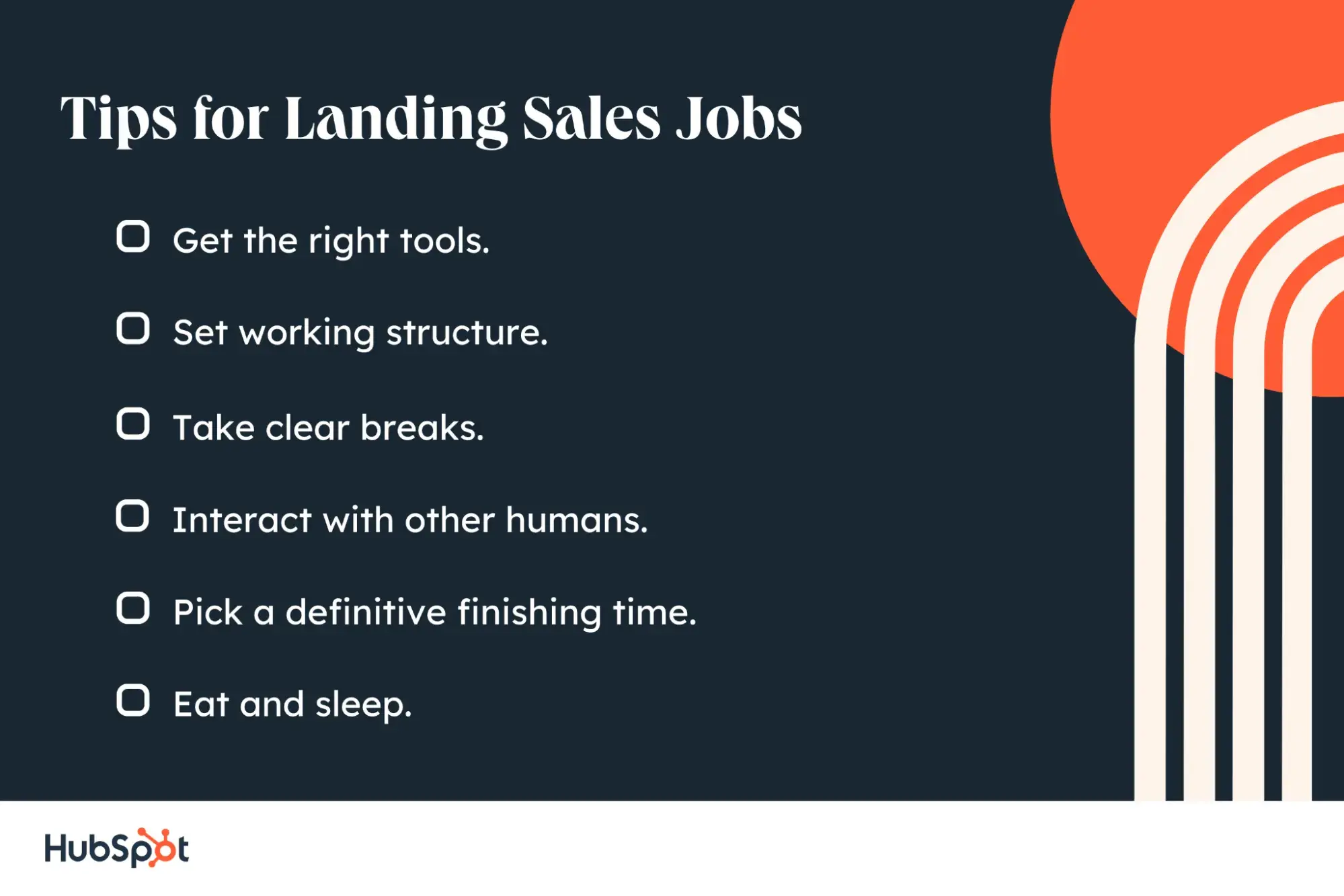
1. Get the right tools.
Something that no one tells you about working remotely long-term is that the cost of your mistakes is greater than when you’re in the office. Little missteps, like falling behind on tasks or not replying to emails, can become your defining features as a co-worker. I believe that the process of transitioning to remote work starts now with being exceptionally organized.
You need a tool that helps you:
- Sync meetings, contacts, emails, etc. (keep things from falling through the cracks).
- Stay on top of your communication across channels.
- Remind you of tasks that are due.
The ideal tool is something intuitive and designed for ease, like HubSpot CRM. I love how tasks are organized in a few simple tabs (no overkill). You can add a task with just a few clicks:

Then your tasks are all organized in one place, where you can switch between tabs to see different groupings. You can also create your own tab groupings to tailor this to your exact preferences:

I love syncing my tasks with my calendar. Working from home has greatly decreased the number of meetings that I have per month, which has left my calendar pretty open. I don’t worry about overscheduling myself in meetings anymore, but I do worry about overlapping deadlines. I need to budget my week very carefully to not overload my schedule.
You can sync your calendar in just a few clicks:

Finding tools that are simple enough to make your life easier is a formative first step in transitioning to working remotely. Next is opening a discussion with your employer.
2. Set working structure.
Structure is your friend when beginning to work remotely. Taking the time to intentionally set yourself up for success will help you avoid distractions, time-consuming mistakes, and overall procrastination. Here are some questions to ask yourself:
- How? Will you get dressed every day, complete a morning routine, etc.?
- Where? Will you work from home, a coworking space, etc.?
- When? Will you have set working hours?
- Who? Will you work alone?
My current routine is to wake up at 7 a.m., get dressed, and have coffee with my husband in the morning before opening my laptop. Unchecked, my natural tendency is to start my day off with screen time and no morning routine. Reinforcing this structure sets me up for a much more balanced and productive work day.
When I sit down to work in the morning, I always know which task I’m going to start with. I decide this based on two factors: task due dates and prioritization. At a quick glance inside Hubspot CRM, you can easily see which tasks you have due today and due soon (plus their priority level):

3. Take clear breaks.
It can be so easy to get lost in your work as a telecommuter. Breaks are crucial to both your mental health and your productivity.
Try to use your breaks to get away from your desk. Go for a walk, enjoy fresh air, or spend time with others who might also be in the house. Take breaks near natural light, if possible, for added mental stimulation.
4. Interact with other humans.
When you start working from home, you’ll likely miss the casual social interactions with colleagues you’re used to throughout the day. Little staples of office life, like small talk and social activities, made each day in the office unique. So what can you do? Communicate.
Use your breaks to interact with others. Have virtual social time with colleagues, and build human contact into your non-work-related tasks.
Managing virtual relationships becomes much easier using HubSpot CRM. All of the information on a single contact is stored with:
- An AI-generated summary of your contact with each individual.
- Varied tools to communicate, all within your dashboard.
- Automated follow-up communication and reminders.
There’s an incredible amount of value packaged into one digestible page. My favorite feature is the Breeze AI summary — it gives you a summary of your communication, AND you can prompt it with questions. It feels like getting the world’s best assistant.

5. Pick a definitive finishing time.
You might be under the impression that working from home establishes better work-life balance, but be careful with that assumption. Working from home can also feel like being at a casino — you can get so caught up in your activity that you lose complete track of time.
In lieu of coworkers whose packing up and leaving the office reminds you to do the same, set an alarm at the end of the day to indicate your normal workday is coming to an end. You don’t have to stop at exactly that time, but knowing the work day is technically over can help you start the process of saving your work and calling it quits for the evening.
6. Eat and sleep.
When analyzing how working from home impacts your health, it’s easy to fixate on the sedentary nature. I get it; my step counter probably thought I died when I first went remote. But let’s not ignore the potential health benefits:
- Breaks can be spent doing exercise, walking, meditating, etc.
- Your workspace can be personalized to fit your needs.
- Without a commute, you have more hours for sleep.
- Access to your kitchen makes meals easier.
For many remote workers, it gets easier with practice to prioritize health and wellness at home.
Working From Home Tips
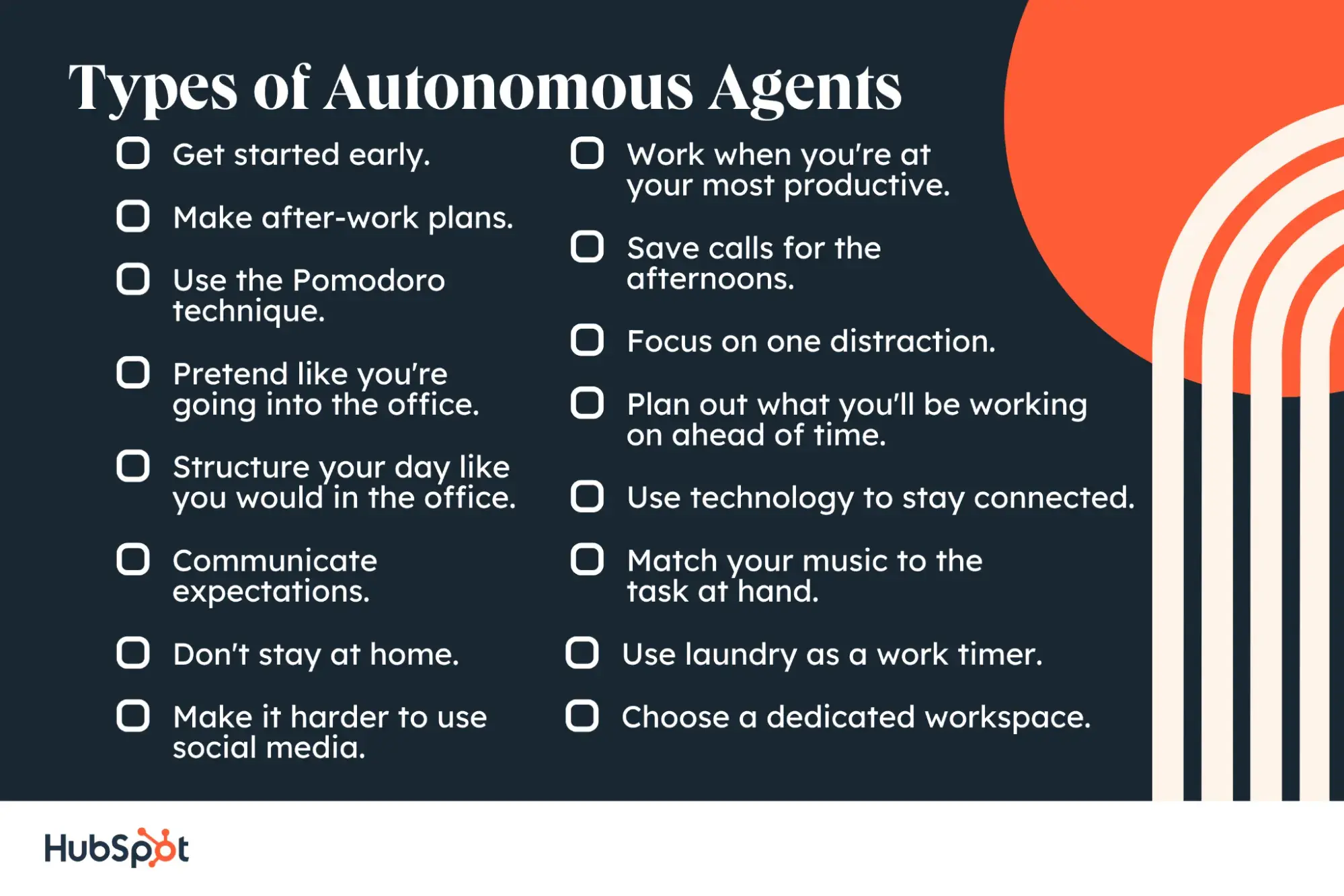
1. Get started early.
When working in an office, your morning commute can help you wake up and feel ready to work by the time you get to your desk. At home, however, the transition from your pillow to your computer can be much more jarring. I know some workers who thrive with a morning routine, and others who thrive by jumping straight into their to-do lists.
Lindsay Kolowich says, “When I work from home, I wake up, put on a pot of coffee, and start working immediately — much earlier than normal working hours. I only start making breakfast once I’ve hit a wall or need a break. I’m a morning person and find I can get a ton done in the early morning hours, so this works really well for me.”
2. Make after-work plans.
Do you have trouble closing your laptop and moving on to the next part of the day? Make it easy for yourself by making plans immediately after work.
“You can instantly boost your remote work productivity by scheduling something fun or important in the afternoon,” shared Mitch Glass, founder of Project Untethered and remote worker of seven years.
“Adding a firm deadline cranks up the pressure and forces you to knock out the most important tasks as fast as possible. If left unchecked, remote work has a way of creeping into the evening hours, so having this hard cutoff point helps protect work–life balance as well,” Glass says.
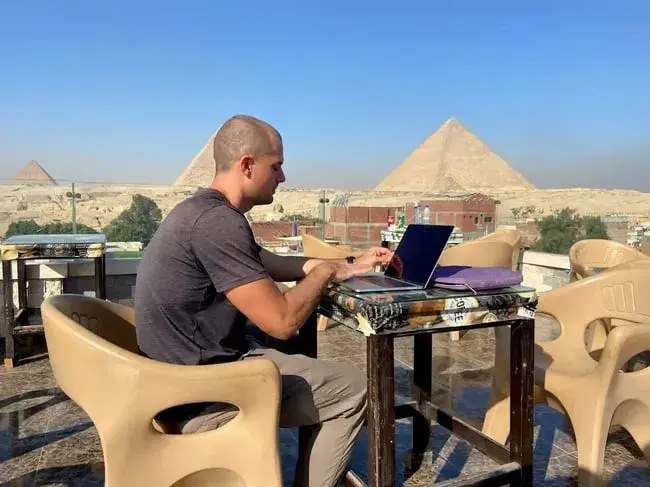
3. Use the Pomodoro technique.
One of the top tips for working remotely is to take breaks, but that poses a challenge for most remote workers. Let the Pomodoro method make it achievable.
“My top work-from-home tip is to use the Pomodoro method to stay productive and focused throughout the day,” shared Kat Smith, founder of A Way Abroad. Smith has been a remote worker for seven years, having spent four years as a freelancer and three years as a full-time remote employee.
In the traditional Pomodoro method, you set a 25-minute timer, pick a specific task you can finish in that time, get rid of any distractions, start the clock, and complete your task.
“This creates some urgency, so you don’t let a single task stretch longer than it should. When the timer beeps, take a 5-minute break. You can repeat this throughout the day,” Smith says.
This technique is so popular that you can easily add a Pomodoro Google Chrome Extension to your browser.
4. Pretend like you are going into the office.
The mental association you make between work and an office can make you more productive, and there’s no reason that feeling should be lost when working remotely. I know that you love working in your sweatpants (I do, too), but the mere act of changing clothes to something more serious will give you a signal to get work done throughout the day.
Take to heart the words of BetterUp senior brand designer Anna Faber-Hammond, who says, “Get fully ready for the day and pretend you’re actually going to work. Otherwise, you might find yourself back in bed.”
5. Structure your day like you would in the office.
When working from home, you’re your own personal manager and can choose your working hours.
However, without things like an in-person meeting schedule to break up your day, I know it’s easy to lose focus or burn out.
To stay on schedule, segment what you’ll do and when for the day. If you have an online calendar, create personal events and reminders that tell you when to shift gears and start on new tasks. Google Calendar makes this easy.
Structuring your day as you would in the office also saves you from work creep. With this structure in place, working from home will not cause your work to invade your personal life.
“Are mornings for writing while you’re in the office? Use the same remote work schedule at home. This structure will help keep you focused and productive,” says Ginny Mineo of Spring Health.
6. Communicate expectations with anyone who will be home with you.
If you’re already working from home or you manage to get a remote position through one of the ways listed above, you might have “company” at home. I suggest you make sure any roommates, family members, and dogs (well, maybe not dogs) respect your space during work hours.
Just because you’re working from home doesn’t mean you’re home. If you share space with another work-from-home adult, you may have to lay ground rules about meeting times, shared desks and chairs, and quiet times.
Sam Mallikarjunan, CEO of AI company OneScreen, tells how he manages to get work done even when people are around.
“If anyone else is going to be at home when you’re working, they just have to be clear that when you’re in your ‘office’ (in my case, my signal to the family is having headphones on), you’re working — even if it looks like and feels like you’re hanging out at home,” Mallikarjunan says.
He adds, “It’s easy to get distracted by the many things that have to be done around the house during the day.”
If working alongside other family members or housemates can’t be avoided, consider investing in home office equipment like noise-canceling headphones or room dividers to minimize distractions.
7. Don’t stay at home.
If your home office is just not getting it done for you, I have great news for you. You can take your work-from-home life a step further and get out of the house.
Coffee shops, libraries, public lounges, coworking spaces, and similar Wi-Fi-enabled spaces can help you simulate the energy of an office so you can stay productive even when you don’t sit in an official workplace.
Content marketer Corey Wainwright comments, “I get out of my home to work and go to an establishment with actual tables, chairs, and people. It helps simulate the work environment and removes the distractions I typically have at home, like the urge to finally clean my room, do laundry, or watch TV.”
8. Make it harder to use social media.
Social media is designed to make it easy for us to open and browse quickly. As remote workers, though, this convenience can be detrimental to our remote work productivity.
To counteract your social networks’ ease of use during work hours, remove them from your browser shortcuts and log out of every account on your phone or computer.
You might even consider working primarily in a private (or, if you’re using Chrome, an “Incognito”) browser window.
This ensures you stay signed out of all your accounts, and each web search doesn’t autocomplete the word you’re typing. I guarantee you won’t be tempted to take too many social breaks during the day.
Also, many have found it helpful to shut off social media notifications during the hours they work from home.
Al Biedrzycki, partner marketing at Ramp, says, “I remove all social networks from my toolbar bookmarks… you can get sucked in without knowing it, so eliminating the gateway to those networks keeps me on track.”
9. Work when you’re at your most productive.
Nobody sprints through their work from morning to evening — your motivation will naturally ebb and flow throughout the day.
However, when you’re working from home, it’s all the more important to know when those ebbs and flows will take place and plan your schedule around it.
To capitalize on your most productive periods, I recommend saving your more challenging tasks for when you know you’ll be in the right headspace for them. Use slower points of the day to knock out the easier logistical tasks on your plate.
Verily Magazine calls these tasks “small acts of success,” and they can help build your momentum for the heavier projects that are waiting for you later on.
Product designer Brittany Leaning says about her routine, “For me, the most productive times of the day are usually early in the morning or late at night. I recognize this and try to plan my day accordingly. Also, music that pumps me up doesn’t hurt.”
The responsibility is on you to know when you are most productive and build your work schedule around the periods of maximum productivity.
10. Save calls for the afternoon.
Sometimes, I’m so tired in the morning that I don’t even want to hear my voice — let alone talk to others with it.
You shouldn’t have to give yourself too much time to become productive in the morning, but you can give yourself some extra time before working directly with others.
If you’re struggling to develop a reasonable work schedule for yourself as a telecommuter, start with the solitary tasks in the morning.
Save your phone calls, meetings, Google Hangouts, video calls, and other collaborative work for when you’ve officially “woken up.”
VP of Partnership Marketing at HubSpot James Gilbert advises that you “take advantage of morning hours to crank through meaty projects without distractions, and save any calls or virtual meetings for the afternoon.”
11. Focus on one distraction.
There’s an expression out there that says, “If you want something done, ask a busy person.”
The bizarre but true rule of productivity is that the busier you are, the more you’ll do.
It’s like Newton’s law of inertia: If you’re in motion, you’ll stay in motion. If you’re at rest, you’ll stay at rest. And busy people are in fast enough motion that they have the momentum to complete anything that comes across their desks.
Unfortunately, it’s hard to find things to help you reach that level of busyness when you’re at home — your motivation can just swing so easily. HubSpot’s principal marketing manager, Pam Vaughan, suggests focusing on something that maintains your rhythm (in her case, it’s her daughter).
She says, “When I work from home, my 20-month-old daughter is home with me, too. It seems counterintuitive, but because I have to manage taking care of her and keeping her happy and entertained while still getting my work done, the pressure helps to keep me focused.”
Vaughan says when her daughter is napping or entertaining herself, she goes into super-productive work mode.
“The ‘distraction’ of my daughter (I mean that in the most loving way possible) means I can’t possibly succumb to some of the other common distractions of home,” she says.
12. Plan out what you’ll be working on ahead of time.
Spending time figuring out what you’ll do today can take away from actually doing those things. And, you’ll have planned your task list so recently that you can be tempted to change your schedule on the fly.
I think it’s important to let your agenda change if you need it to, but it’s equally important to commit to a schedule that outlines every assignment before you begin.
Try solidifying your schedule the day before, making it feel more official when you wake up the next day to get started on it.
“Plan out your week in advance to optimize for the environments you’ll be in,” says Niti Shah.
13. Use technology to stay connected.
Working from home might make you feel cut off from the larger operations happening in your company.
Instant messaging and videoconferencing tools like Slack and Zoom can make it easy to check in with other remote employees and remind you how your work contributes to the big picture.
I’ve found it’s also vital to invest in the right technology. For instance, a slow router can take the steam right off your enthusiasm to work, so it’s better to invest in a high-performance router.
CMO and former HubSpot employee, Meghan Keaney Anderson, remarks:
“At HubSpot, we use Slack to keep conversations going remotely, Trello to keep us organized around priorities, and Google Hangouts plus Webex to make remote meetings more productive. Getting the right stack of support tools to fit your work style makes a big difference.”
14. Match your music to the task at hand.
During the week, music is the soundtrack to your career (cheesy, but admit it, it’s true).
And, at work, the best playlists are diverse playlists. Personally, I like listening to music that matches the energy of the project I’m working on to boost my productivity.
Video game soundtracks are excellent at doing this. In the video game, the lyric-free music is designed to help you focus; it only makes sense that it would help you focus on your work.
Want some other genres to spice up your routine and make you feel focused? Take them from Mineo, a startup marketer, who offers her work music preferences below.
“When I’m powering through my inbox, I need some intense and catchy rap/R&B (like Nicki Minaj or Miley Cyrus) blasting through my headphones, but when I’m writing, Tom Petty does the trick. Finding what music motivates and focuses me for different tasks (and then sticking to those playlists for those tasks) has completely changed my WFH productivity,” Mineo says.
15. Use laundry as a work timer.
You might have heard that listening to just two or three songs in the shower can help you save water.
And it’s true; hearing a few of your favorite songs start and end, one after another, can remind you how long you’ve been in the bathroom and shorten your wash time.
Why do I bring this up? Because the same general principle can help you stay on task when working from home. But instead of three songs off your music playlist, run your laundry instead.
Doing your laundry is a built-in timer for your home. So, use the time to start and finish something from your to-do list before changing the load.
Committing to one assignment during the wash cycle and another during the dry process can train you to work smarter on tasks that you might technically have all day to tinker with. And when you know there’s a timer, it makes it hard for distractions to derail your work.
People ops manager Emma Brudner notes:
“I also usually do laundry when I work from home, and I set mini-deadlines for myself corresponding to when I have to go downstairs to switch loads. If I’m working on an article, I tell myself I’ll get to a certain point before the wash cycle ends. Then I set another goal for the dryer.”
16. Choose a dedicated workspace.
Rather than cooping yourself up in your room or on the couch in the living room — spaces associated with leisure time — I recommend dedicating a specific room or surface in your home to working remotely. I’ve discovered that a dedicated office space can be pivotal in having fewer distractions.
No matter the space or location, have an area of the home to work and stay committed to it throughout the day. And, after choosing your dedicated workspace, make the most of it by making it quiet.
Mallikarjunan says, “Have a place you go specifically to work. It could be a certain table, chair, local coffee shop — some place that’s consistently your ‘workspace.’ It helps you get into the right frame of mind.”
Staying Productive While Working From Home
Can I confess something? I still miss office life sometimes, despite having a remote job for the majority of my career. It’s natural to go through ebbs and flows with your work. The secret to success is seeing the process as fluid and always striving for continuous improvement in productivity and job satisfaction.
You need more than just a reliable internet connection to make this lifestyle work for you. You need systems, like HubSpot CRM, to keep things from falling through the cracks. Press play for an easy beginner tutorial for setting up HubSpot CRM. You’ll already be one step closer to having a thriving remote job.
Editor’s note: This post was originally published in September 2014 and has been updated for comprehensiveness.
![]()
The Best AI Tools for CSS Code Generation, Based on Real Dev Tests
I used to spend 30 minutes tweaking one CSS section — adjusting margins, testing responsiveness, and fixing weird browser quirks. Half the time, I’d end up copy-pasting snippets from five different tabs just to make a layout look decent on both mobile and desktop.
WebsiteI used to spend 30 minutes tweaking one CSS section — adjusting margins, testing responsiveness, and fixing weird browser quirks. Half the time, I’d end up copy-pasting snippets from five different tabs just to make a layout look decent on both mobile and desktop.
![]()

Content aggregators can help you get more eyes on your marketing collateral — here's how
Those who know me know that I have a healthy obsession with travel. So, I often pore over travel blogs looking for the best way to plan a trip and the best activities to do in a given place. One tool that will always help […]
MarketingThose who know me know that I have a healthy obsession with travel. So, I often pore over travel blogs looking for the best way to plan a trip and the best activities to do in a given place. One tool that will always help me find what I need is content aggregation.
Since they’re not solely for travel sites, content aggregator sites can be a useful strategy. Marketers can reach new audiences, and consumers can find relevant resources.
In this post, you’ll learn what content aggregation is and discover high-quality sites.
Table of Contents
These sites can collect things like:
- News articles.
- Social media posts.
- Images.
- Videos.
- And more.
Essentially, content aggregator sites collect and repost content so viewers can see articles from various sources all in one place. Usually, these sites are set up to aggregate content through RSS feeds automatically.
So, now that we know more about content aggregation, see how you can get started.
How Content Aggregators Can Help Marketers
Content aggregation can help marketers distribute content on multiple platforms, making it easier for people to find you.
The major benefits that content aggregator sites have for marketers include:
- Expanded reach and visibility — likely in front of the right audience — since users rely on content aggregators to surface content that matches their interests (see example section below).
- Referral traffic from pieces on aggregator sites that pique the interest of users. If you manage to secure a feature, traffic should increase significantly.
- SEO benefits due to the link from a high-authority, relevant site.
- Content inspiration because aggregator sites allow you to see trending topics.
The more platforms you’re on, the more exposure you have to a variety of audiences. Given this, content aggregation is a tactic you could include in a brand awareness strategy.
Additionally, using content aggregators to distribute your business content can help you become involved in your community, especially if you encourage interaction. For example, people can leave comments, have discussions, and also have conversations with you.
Before you get started, it’s essential to understand how to pick a content aggregation site.
How to Pick the Right Aggregator Service

When it comes to picking the right aggregator service for your business, the most critical question is the type of content you’re hoping to share on it.
For example, there are specific sites for news stories, others for blogs, and others focused entirely on social media content — you want to pick the one that aligns most with your needs (our list below will help).
In addition, some aggregators cost money. If you have a strict budget, you’ll want to visit the pricing pages of services to see if there are any fees.
However, many services are free of cost and are curated by editors or algorithms, so your choice depends on your business needs.
Want to write content faster with AI? Try HubSpot’s free AI Content Writer.
Aggregation vs. Creation vs. Curation
There are a variety of ways you can provide valuable content to your audience. It’s important to understand which approach (or combination of approaches) best suits your business goals and your audience’s interests.
Content creation is the process of developing topic ideas and content for your target audience through written and visual products. This information is made available through blogs, videos, infographics, and other digital formats.
Top tip: If you need help creating content, you can use HubSpot’s content creation templates.
Content curation is a bit closer to content aggregation in that it is not original content. Instead, it is content that is curated and presented to the target audience.
The content is manually collected, organized, and annotated, so it often includes commentary and/or context.
Content Curation vs. Aggregation
As I previously explained, content aggregation is different from both content creation and curation in that it’s automatic and collects information based on keywords.
The content is gathered from different sources online and put together in one easy-to-find place.
This tool allows your audience to derive a lot of value from your distribution and aggregation with minimal and efficient effort on your end.
Each of these methods can offer a way to expand your marketing strategy and are worth your consideration. However, in this article I’m focusing on digital content aggregators.
Content Aggregation Tools
Now, let’s go over some different high-quality content aggregation tools that can be valuable to you.
Blog Aggregators
As implied in the name, blog aggregator sites focus on blog websites. They can contain general blog posts or more niche-focused aggregators, such as a travel blog aggregator that’s focused on travel blogging content.
1. Travel Blogger Community
Travel Blogger Community is a content aggregation site that I use when searching for travel blog content. You can request to have your content featured, and it is curated by editors.
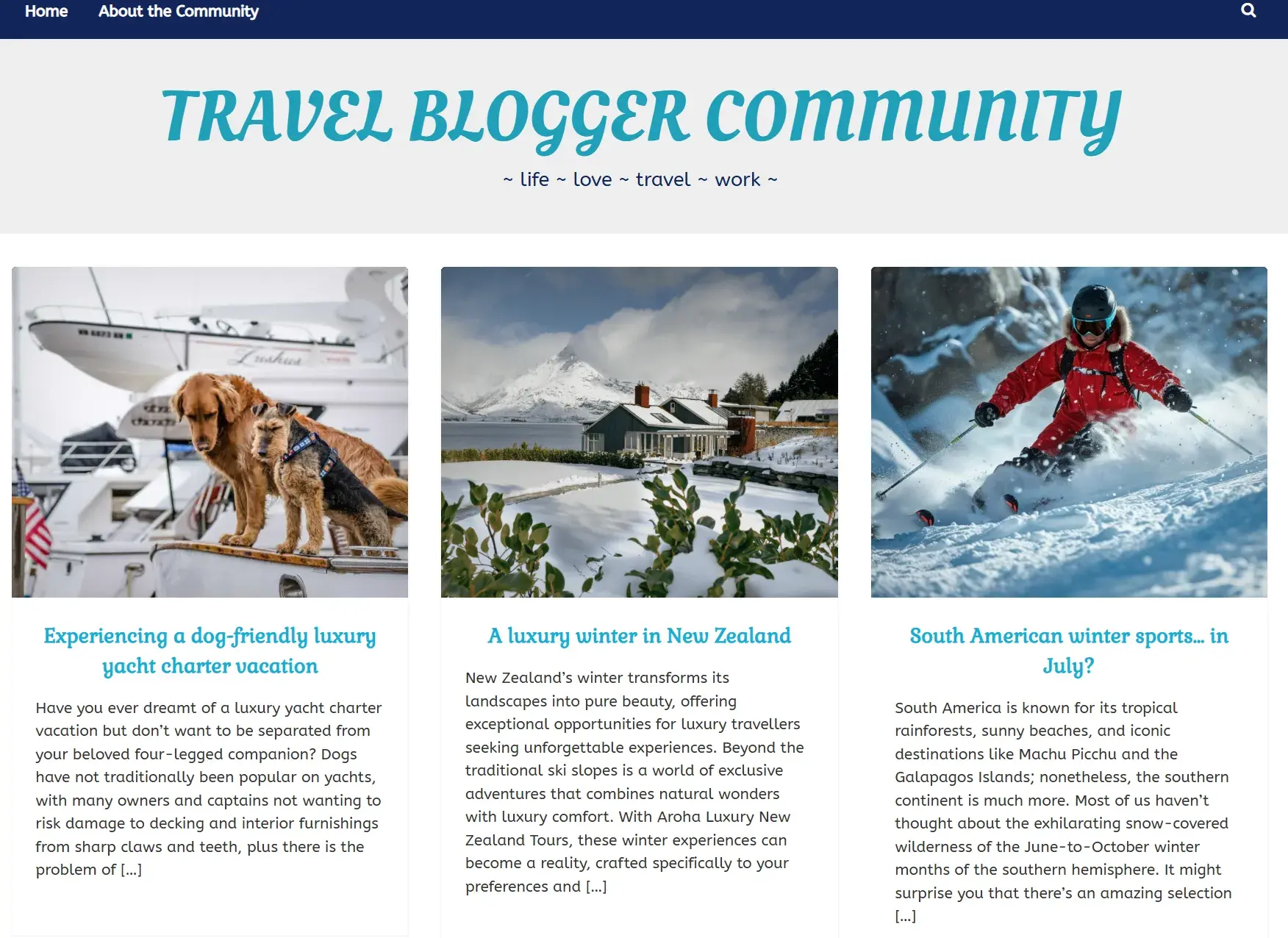
Pro tip: Travel Blogger Community is a great example of a niche site that may also exist within your industry, so be sure to do some research if you’re going to implement a content aggregation strategy.
2. Flipboard
Flipboard is a popular blog aggregator that allows users to create a custom feed based on their interests.
What I like: Personalization allows you to create a profile, submit an RSS feed, and share your content. You can also create a personal storyboard with content related to your business and link to it on your website via social buttons.

3. The Web List
The Web List is a single-page content aggregator with original content from a variety of sources. It highlights the most popular items of the day at the top, then organizes other articles by source.

News Aggregators
News aggregator sites compile content from various high-quality news sources. These sites can be for general news, location-specific news, or industry happenings.
4. Google News
Google News displays the top news stories for the day, saving users a trip to their search engine.
You can’t submit your content to the site as it is curated based on search history and location, but if your site gains traction, you increase your chances of being featured.
Best for: Customization. Users can customize their feed by “following” specific topics, sources, or searches.

5. AllTop
AllTop aggregates content from various topics and sources, such as top news sites and social media forums.
Users can search for topics of interest and get the top stories or just browse through the homepage.
Pro tip: AllTop sometimes accepts site submissions, so be sure to check back periodically if you want to feature your content.
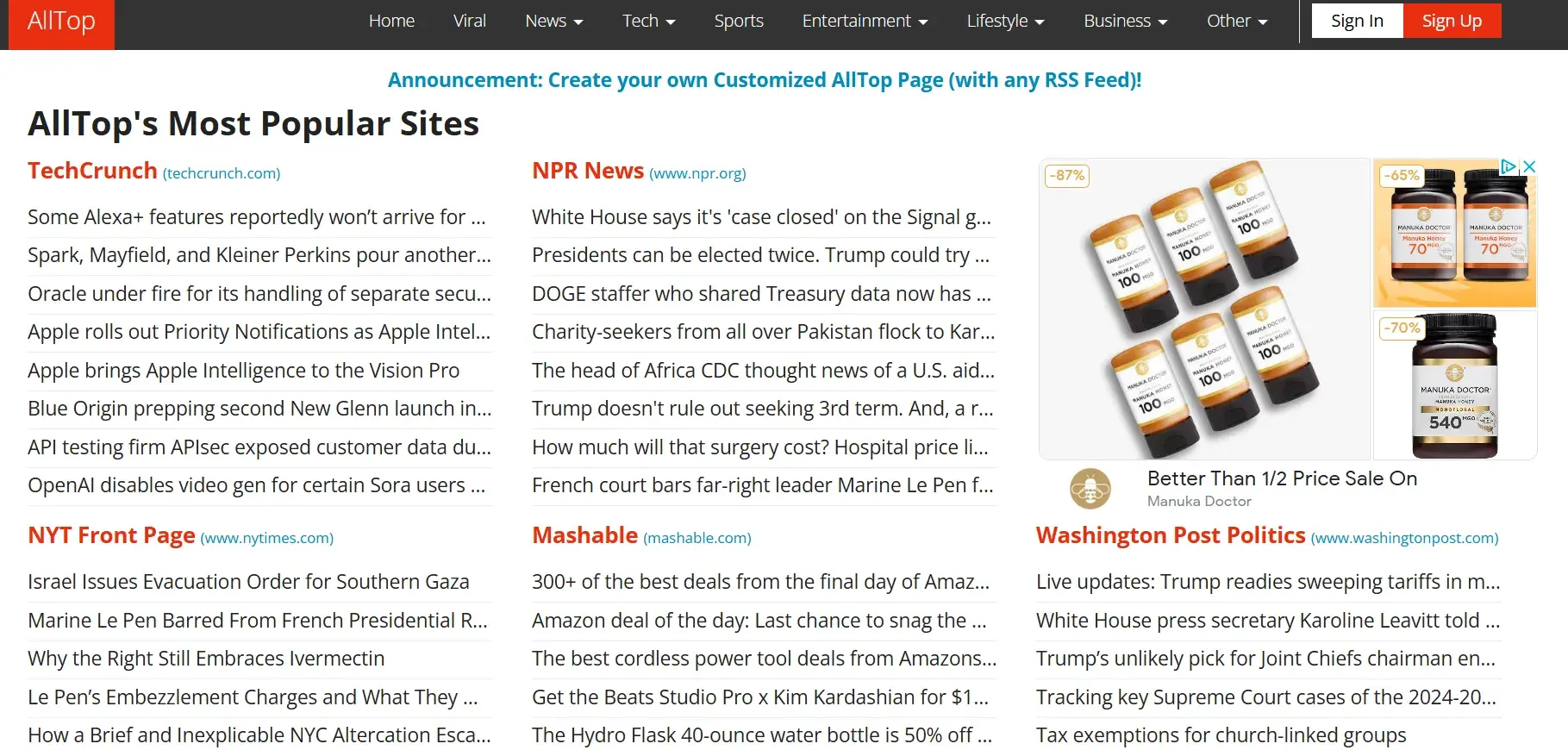
6. Pocket
Pocket is an aggregation site that features a wide variety of content that users can customize to meet their interests by clicking a “Follow” button. You can also bookmark content to read on the go on your mobile devices — hence Pocket.
Best for: Anyone! There is a wide range of categories, from tech to finance to travel.
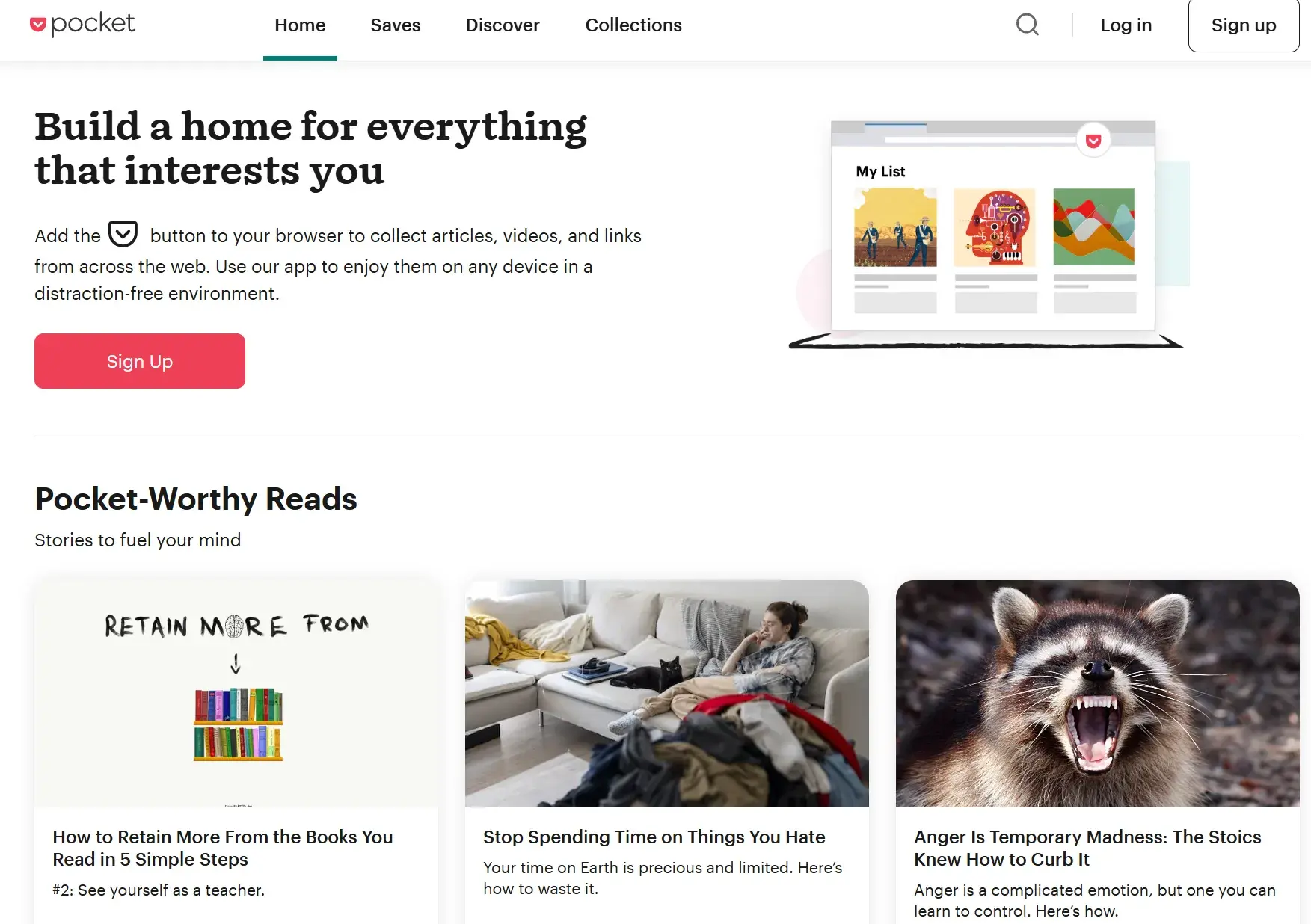
7. WP News Desk
WP News Desk is a unique aggregator site that focuses on content related to the WordPress community.
You can’t submit your own content to be featured, but if you run a high-quality WordPress blog that is informative for users, you may find your site featured on the aggregator.
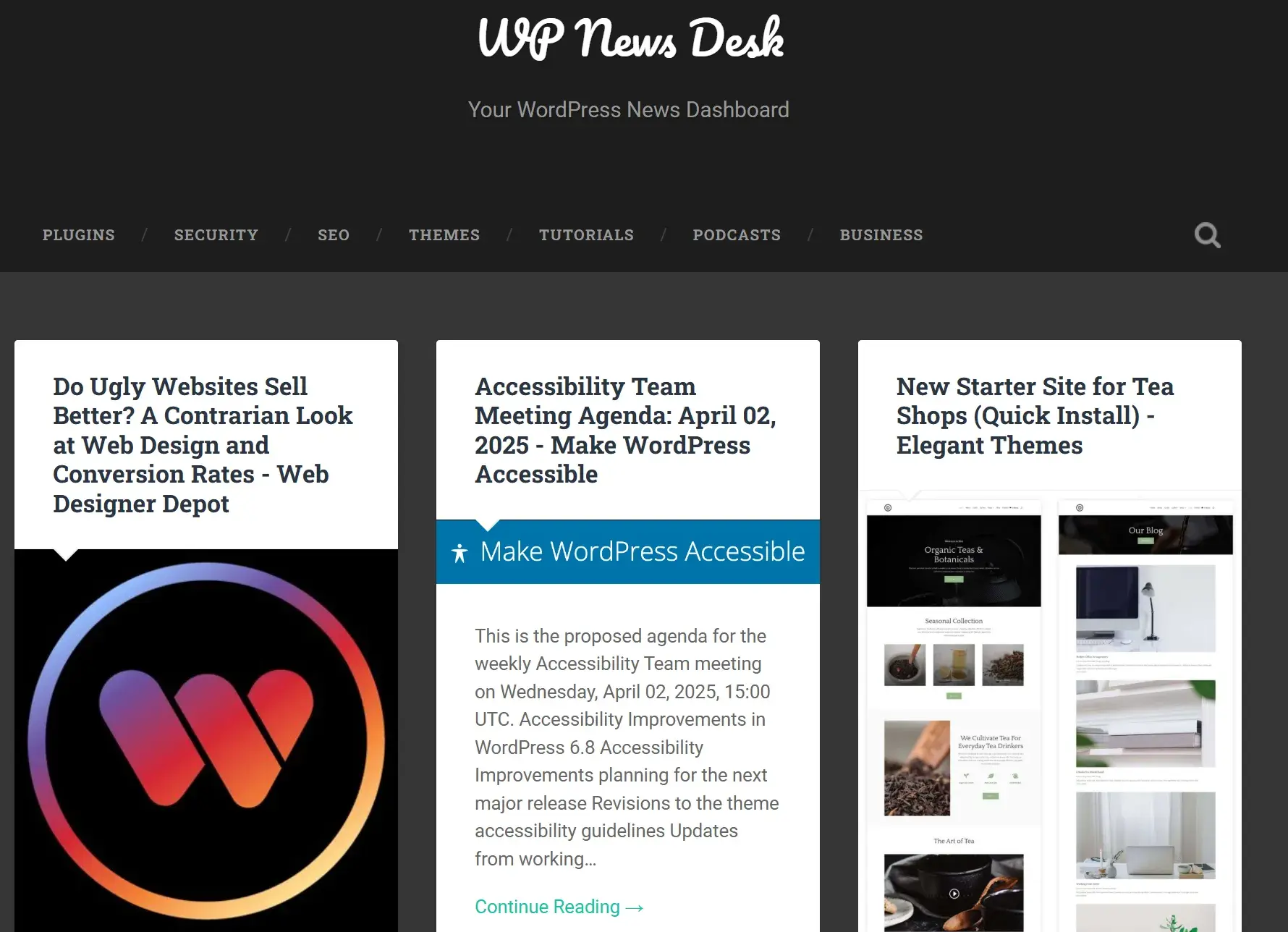
8. Feedly
Feedly is a content aggregation site that’s focused on helping users create their own feed, so they aren’t overwhelmed with information overload.
Pro tip: The site has both free and paid plans, so users can aggregate content from as many sources as they want and across any niche.

9. Techmeme
Techeme is a niche news aggregator site that provides readers with the top news stories about technology-related topics, curated by editors.
In addition to the homepage, which features the day’s top stories, you can also choose the River view to see live updates or the Leaderboard view to find articles by topic.
Pro tip: You can pay to have your content, event, or job listing posted on Techmeme, so if you’re in the tech business, this may be a great resource to tap into.

Information Aggregator Websites
Information aggregator websites contain exactly that — information. This can include blog posts, news stories, links to social media content, and any information that users can benefit from.
10. Upstract
Upstract is a popular information aggregator. It allows users to choose the platforms they want information from to create a custom feed.
What I like: The crazy variety — it pulls from Reddit, Huffington Post, The Verge, Google News, Wired, and even TikTok, setting them all side-by-side.
While you can’t submit your site to be included in this aggregator, it’s nevertheless a powerful platform to be aware of if you’re going to start using content aggregation.
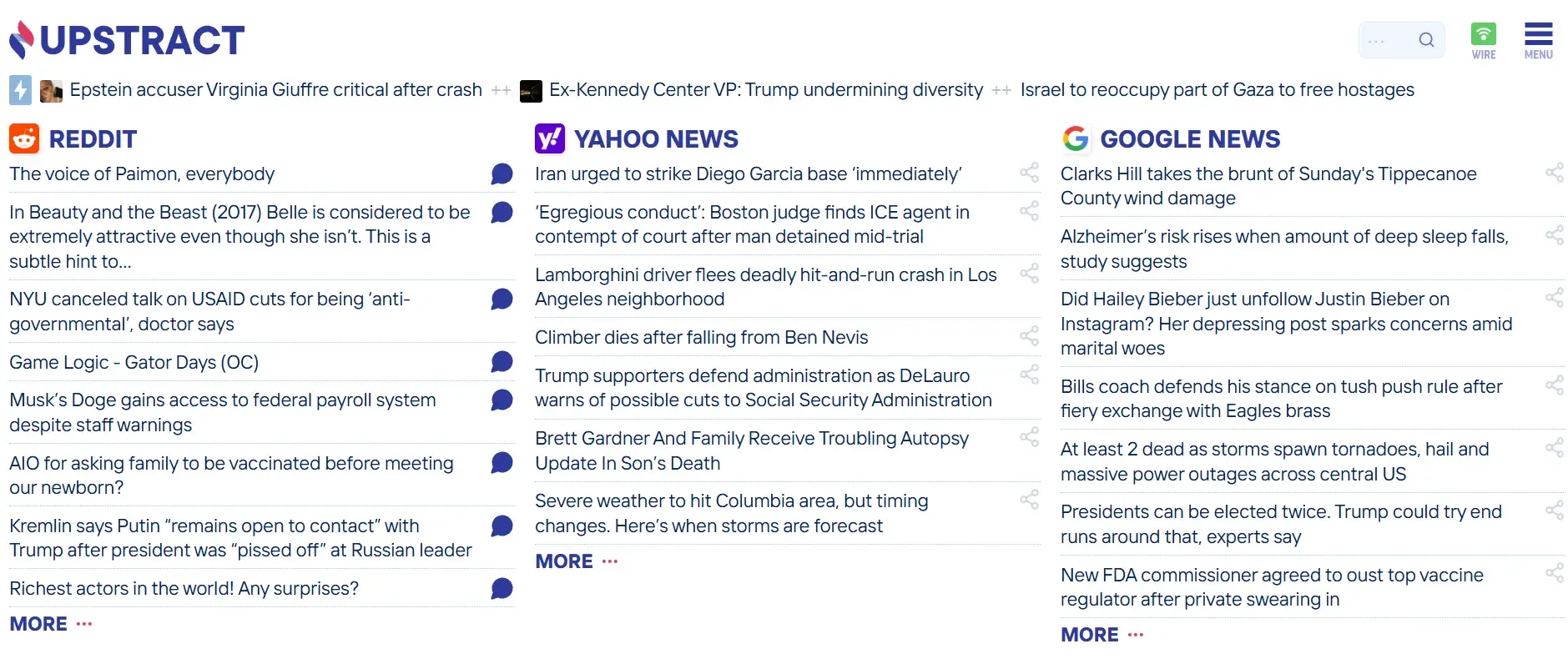
11. Panda
Panda offers both a website and a Chrome extension specifically curated for developers, designers, or just anyone who identifies as an entrepreneur.
It allows you to stay up to date with industry news from sources such as Hacker News, TechCrunch, and GitHub.
What I like: It is presented in an easy-to-use and aesthetically pleasing manner, making it the perfect content aggregator for anyone in the industry.
However, keep in mind that Panda doesn’t allow user submissions. Therefore, your feature may just come about if your content rises to the top of any of these notable news sites.
12. Reddit
Reddit is a household name, and if it isn’t in your home, then you must be living under a rock. However, it is also one of the most popular information aggregator sites.
It features trending topics from all different areas of interest while also providing a forum where people can comment and discuss the latest news.
Pro tip: As I’m sure you know, members of the site can submit content such as text posts, images, and links. Therefore, it’s a great tool for marketers to spread their word further.

Social Media Aggregators
Social media aggregators compile high-quality content from sources such as Instagram, Facebook, YouTube, and TikTok. Most social media aggregators help markets find user-generated content to share with their audience to build brand trust.
13. TaggBox
TaggBox is a social media aggregator focused on helping marketers develop brand trust and engagement through user-generated content.
You create an account, select the tags that are relevant to your business, and you’re shown posts across different social media platforms that your audience has made about you.
Pro tip: You also have the option to create a social feed of user-generated content to display on your own website, helping site visitors see your content in action and generate trust from other consumers.

14. Tagembed
Tagembed collects and curates engaging social media content related to your business that you can then display on your website.
What I like: You can generate a social feed from multiple sites and share the custom content within your site for all users to see.
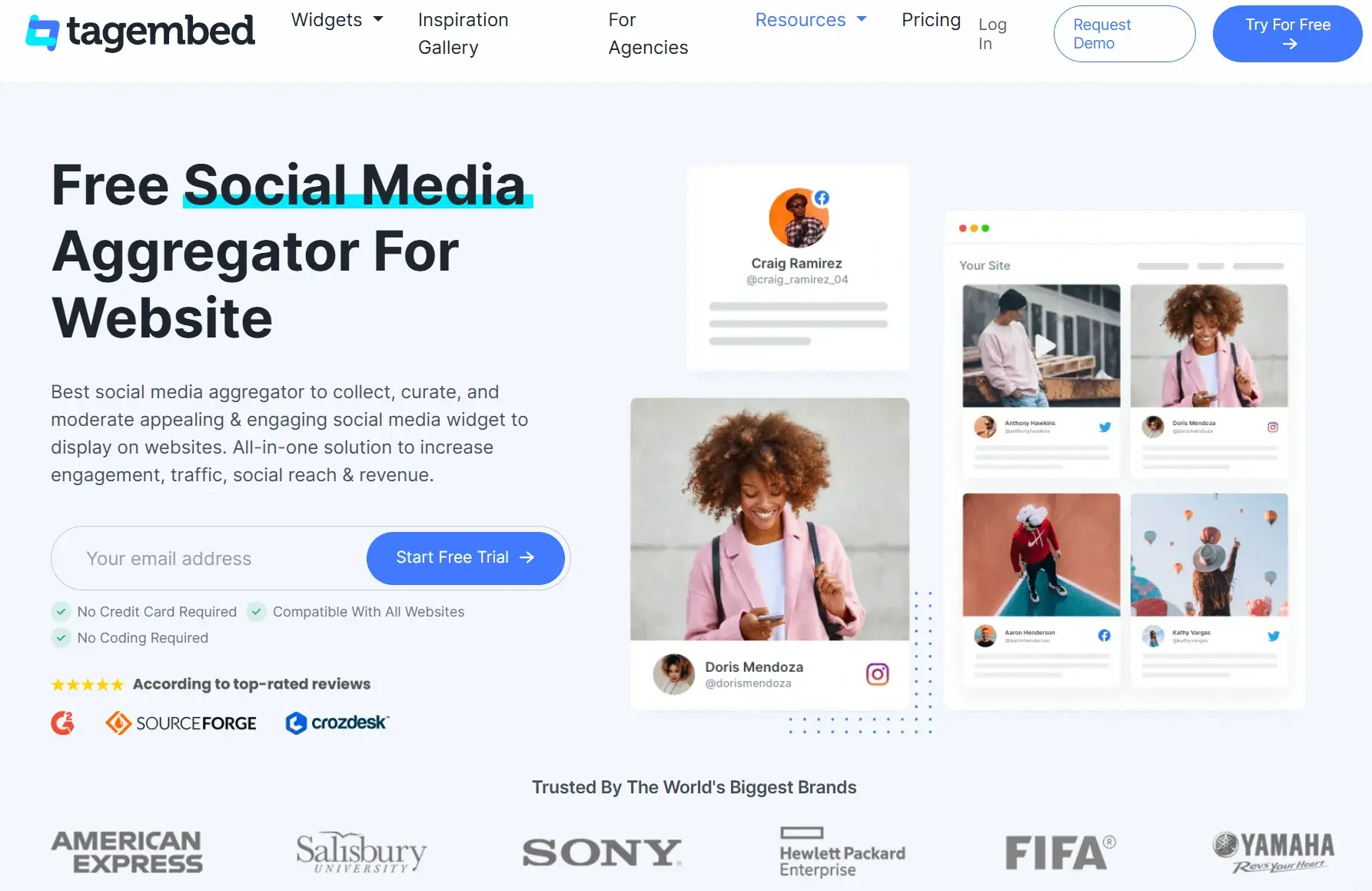
15. Curator
You can draw posts from the most popular social media sites to create and share your own feed on your business’ website.
You can choose whether the posts automatically appear on your site or whether you manually approve each one first. Curator offers free and paid plans.
Best for: Building brand trust by sharing customer posts with prospects and site visitors.

While it may not make up the core of your marketing plan, content aggregators are a unique and exciting tool for marketers to use to share their content and gain exposure while simultaneously becoming involved with your community.
Start Using Content Aggregators in Marketing
If you’re creating content in marketing, then you might consider making content aggregator submissions a part of your process.
As a marketer and a blog writer, I make sure I submit to content aggregators when I’ve created a piece of content that will work for an aggregator. I suggest creating a sheet using Google Docs. Then, pull all the relevant examples from above, plus a note for those you can manually submit to, then make submitting the content a part of the process, as natural as writing it!
Editor’s note: This post was originally published in March 2020 and has been updated for comprehensiveness.
![]()
15 AI tools to streamline your social media strategy
It’s no secret that content is king. And with more and more channels to keep up with — each requiring unique formats for your creative content — AI tools aimed at social media are stepping in to do some of the heavy lifting. In this […]
MarketingIt’s no secret that content is king. And with more and more channels to keep up with — each requiring unique formats for your creative content — AI tools aimed at social media are stepping in to do some of the heavy lifting.
In this post, I’ll introduce you to 15 cutting-edge AI tools for social that can help you optimize your strategy, boost productivity, and drive positive ROI. While I admit I was intimidated by some of them at first (or the whole idea of implementing AI), once I saw what these tools could pull off — not as a stand-alone content creator, but as an adept and much-needed assistant — I quickly changed my mind.
Whether you’re trying out AI-powered content creation for the first time or just want to add some variety to your current content repurposing routines, I rounded up marketers who have already put these tools to the test and asked them what they recommend. They had many opinions to share, in addition to stories about how AI has transformed their social media strategies.
So, if you’re ready, let’s dive in and discover how innovative AI tools can transform your content strategy.
Table of Contents
Top Social Media Trends
According to HubSpot’s 2025 Social Media Trends Report, marketers’ reliance on AI continues to increase. At the same time, they’re hiring for content-related roles, due to changing and increasing content needs.
Visual Storytelling
One of the major additions for 2025 is the importance of visual storytelling across all mediums. Short-form video, images, and live-streaming were among the most common in 2024, but in 2025 this trend is accelerating. This makes sense given that all three formats were reported as some of the highest ROI last year.
As you can imagine, this shift is especially felt in social media strategy, with YouTube, Instagram, and TikTok seeing increased investment at higher rates than other channels.
Micro-Influencer Partnerships
Another key trend is partnering with small-scale influencers (audiences smaller than 100K) in the context of a shift to brand-led strategies. When asked the biggest benefit of working with this group, almost half of marketers (45.63%) responded that small influencers are more trusted by their followers, with 40.18% believing that small-scale creators give you access to a more niche and tight-knit community. Also, it tends to be less expensive.
Evolving Data Analysis
Lastly, while data remains important, the current adverse data landscape has meant that marketers are changing their relationship to it, in terms of what data is collected and how it’s analyzed. Measuring and tracking campaigns has become a primary way to demonstrate ROI by understanding how various strategies are performing relative to one another. This is in contrast to using data to understand a target audience, since consumers are increasingly cautious with their personal data.
So, what does all this mean for AI?
With increased content creation, AI usage among marketers is rising at a staggering rate just to keep up.
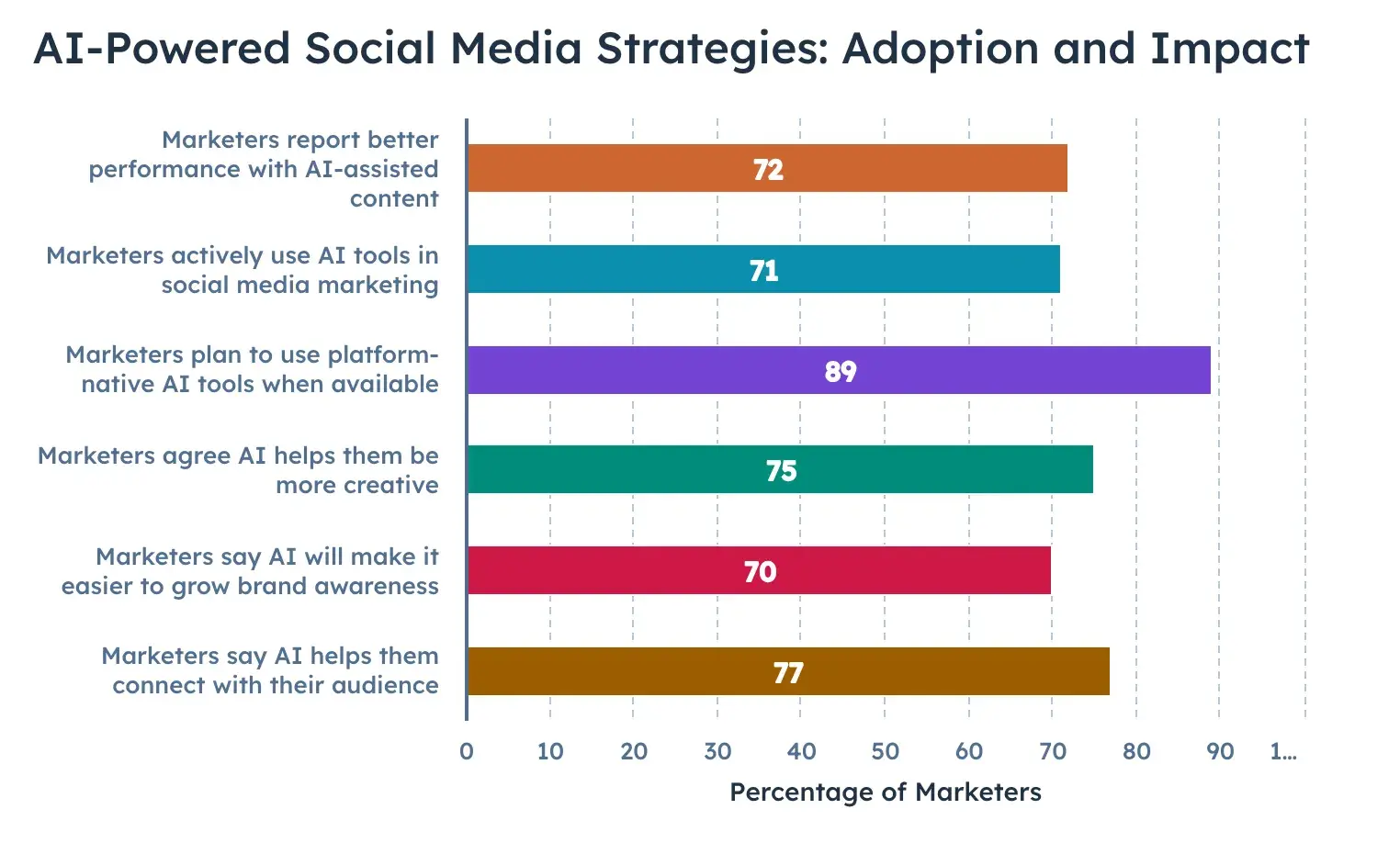
And yet, roughly half of all marketers are unsure of their ability to use AI effectively and measure the ROI of using AI to assist their marketing efforts.
If that describes you, the list of tools below aims to give you some inspiration and ideas when it comes to implementing AI in your social strategies so you can go forward with confidence.
3 Ways to Implement AI in Your Social Media Strategy
Social media marketers are creatives, analysts, and expert advertisers, which is a lot of roles to fill at once. Rather than replacing any of those roles, or the people who occupy them, AI can help augment your work in each space and free up time to do what you do best.
1. Use AI to create post content.
Marketers who embrace AI are seeing better results across content creation, engagement,
and audience growth. And as platform-native AI tools become more widely available, marketers are integrating AI into their processes to stay ahead of the competition.
While many of us know about ChatGPT and its capacity to write full-length blog posts, there’s an abundance of choices when it comes to AI tools that can help social media marketers create the content they share — many of which are targeted to social media specifically.
Currently, 43% of marketers are using generative AI to write copy, create images, and even ideate, according to HubSpot’s 2025 Social Trends Report. And it’s no longer reserved for text or static images. AI video tools that can automatically clip or create are making a big splash, as marketers shave hours off creation time.
2. Monitor and analyze your social media channels with AI.
Generating content is only half the battle. A huge portion of social media marketing is managing and monitoring social channels before or after content is released.
Here’s another place where AI can shoulder the burden. Handing off data-heavy tasks can help you make better marketing decisions, as AI tools collect information from millions of posts at scale and use that data to identify patterns, predict new ones, and create posts.
And with the above-mentioned trend of partnering with lesser-known influencers, there are even tools to help you monitor, track, and discover those that would be the best fit for your brand (see Emplifi below, for example).
3. Create, optimize, and manage paid social media advertising.
Social posts aren’t the only thing that AI can help you create. Ad copy, directed at different audiences, is also only a click away with some of the AI tools below. Plus, the ads can be optimized for clicks and conversions using predictive analytics, meaning they’re likely to perform better.
If you’re interested in trying this out for yourself, read on.
The 15 Best Social Media AI Tools
1. Lately

Lately makes generating social posts easy by repurposing long-form content. If you’ve got lengthy videos or wordy reports, this tool can grab ahold of bits and pieces and churn out a number of clips ready to go with captions.
Plus, it analyzes engagement with prior posts, so that the newly generated social posts are likely to perform well, and then recommends the best posting schedules across channels.
And if you manage more than one brand, it offers a hierarchy system that lets you distribute everything from one place.
Best for: Generating content.
What I like: Lately’s AI features let you quickly and easily generate social posts by repurposing long-form content, which is a big time saver.
Pricing: Lately offers two plans, Growth and Enterprise. Plans start at $199 per month billed annually for growing businesses.
Lately Case Study
Abhishek Shah, founder of Testlify, used Lately to successfully launch a new enterprise software feature as part of his company’s offering.
“We transformed a technical whitepaper into 50+ tailored social posts targeted for different platforms and audience segments. The campaign generated 340% more engagement than our previous launch, with LinkedIn posts specifically seeing a 27% higher click-through rate.”
He tells me that, using Lately over time, the most impressive feature is its ability to match the brand’s voice. “It gets better at mimicking our specific tone with each iteration.”
2. Sprout Social
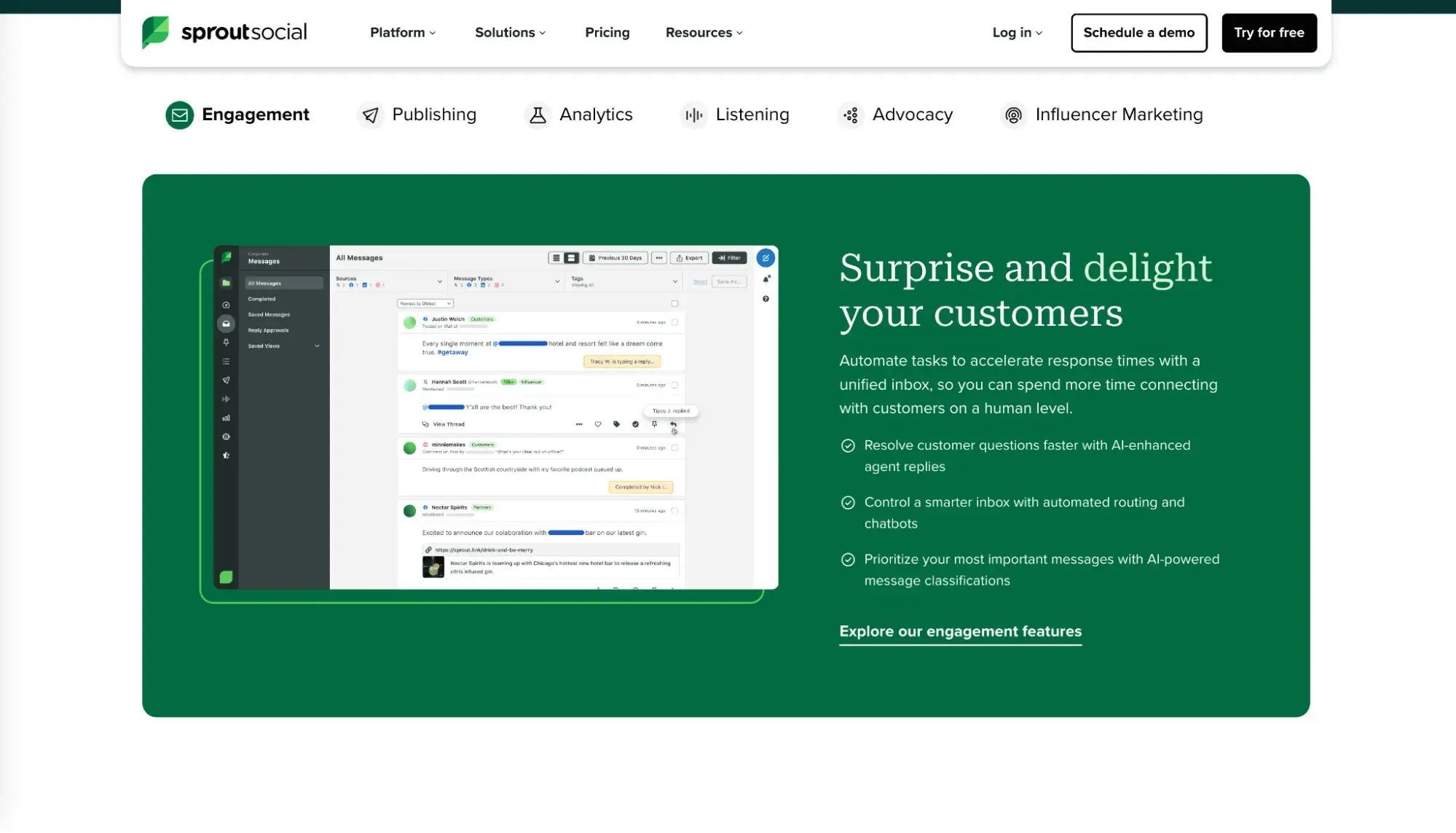
If you use your social platforms for community management, Sprout Social’s automated technology can help you reply to fans, customers, or followers.
The dashboard allows you to see and respond to posts through a unified inbox, which uses AI-enhanced agent replies and automated routing.
In both the dashboard and direct message view, Sprout analyzes the wording and sentiment of a message and suggests a response (which is up to you to approve or edit).
Best for: Managing customer messages.
What I like: Sprout Social’s Social Listening solution is a great feature that leverages the power of AI technology to uncover customer and competitor insights to enhance your strategy.
Pricing: Sprout Social offers four plans: Standard ($199), Professional ($299), Advanced ($399), and Enterprise (custom), which are priced per seat/month. Prices increase if billed monthly rather than annually.
Sprout Social Case Study
Goally, a company that offers skill-building tools on e-tablets for neurodiverse children, experienced success with Sprout Social’s Smart Inbox for message management.
By leveraging the personalized customer care and engagement features of Smart Inbox, Goally grew 254% in followers month over month and reached a 100% action rate on TikTok comments, ensuring a high level of responsiveness and satisfaction among their target audience.
3. HubSpot’s Content Hub
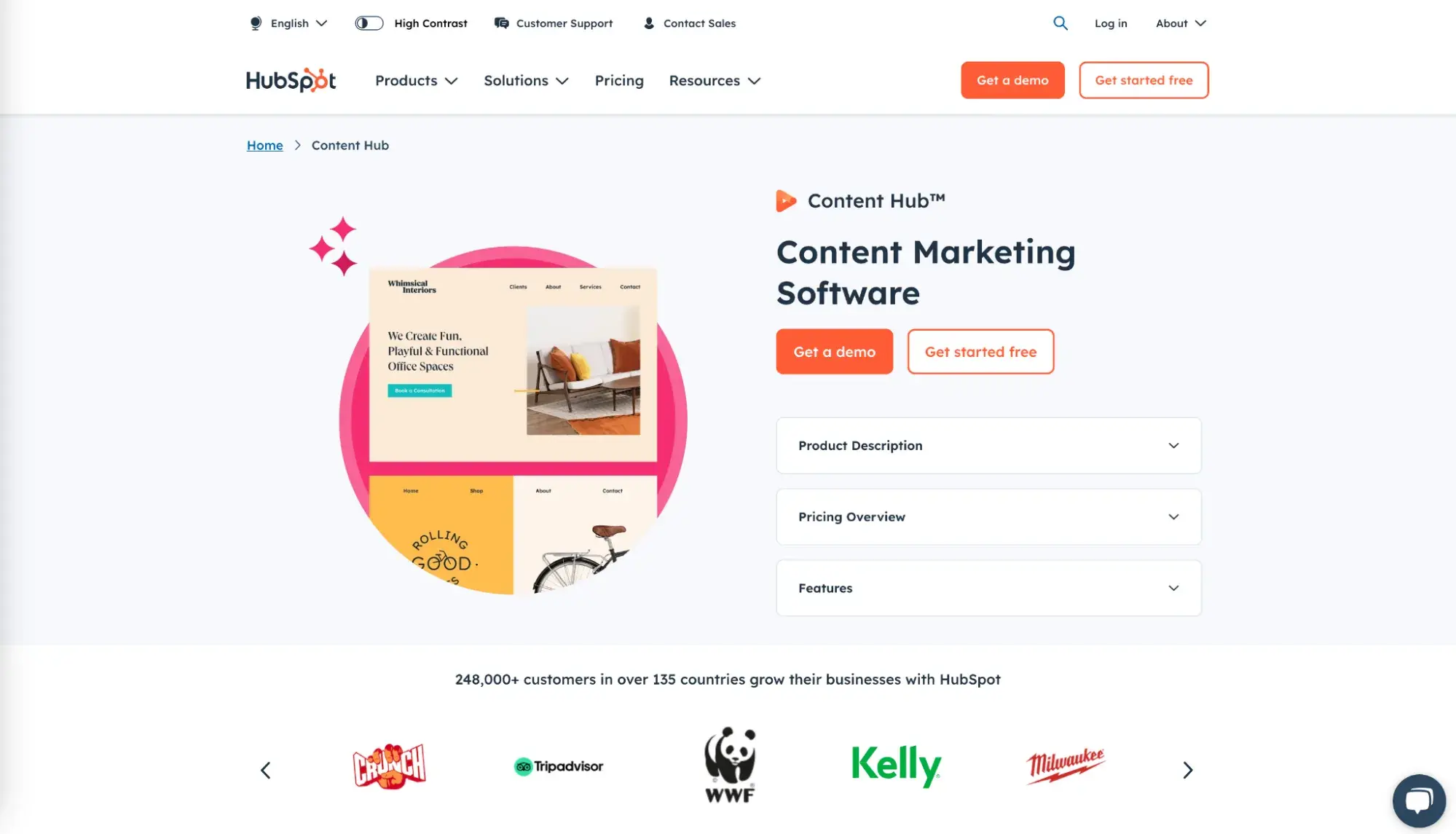
HubSpot’s Content Hub is an AI-powered marketing software built for marketers to create and manage content. Using generative AI to create personalized content, it tracks performance, gives SEO recommendations, and captures leads, all powered by Breeze.
One of the highlights is its content repurposing tool, Content Remix, which can take a single piece of content and transform it into multiple marketing assets across channels — all in a matter of seconds. Not only will it turn that long blog article into social posts, it will also optimize the content for each platform, thus saving time while increasing output and reach.
Best for: Remixing and repurposing content.
What I like: HubSpot’s Content Remix tool
Pricing: HubSpot’s Marketing Hub pricing starts with free tools and then varies depending on how many users you have and which features you want to access. To begin with Content Hub features, you’ll want the Starter Customer Platform, at a minimum, which starts at $15/month.
HubSpot Case Study
Adrian Iorga, founder and president of Stairhopper Movers, leans on Content Hub’s remix feature “because there’s more pressure than ever to maintain a presence on more platforms,” he tells me.
“We used it to create a few social post variations from a blog post and test them from different angles. We were able to see what our audience engaged with most, which meant better content and a 10% lift in overall referral traffic from social media to our website that month.”
“It’s one of the best AI products I’ve seen in the last five years,” he says, adding that “it’s incredibly good at analyzing and using brand tone and voice.”
4. Copy.ai
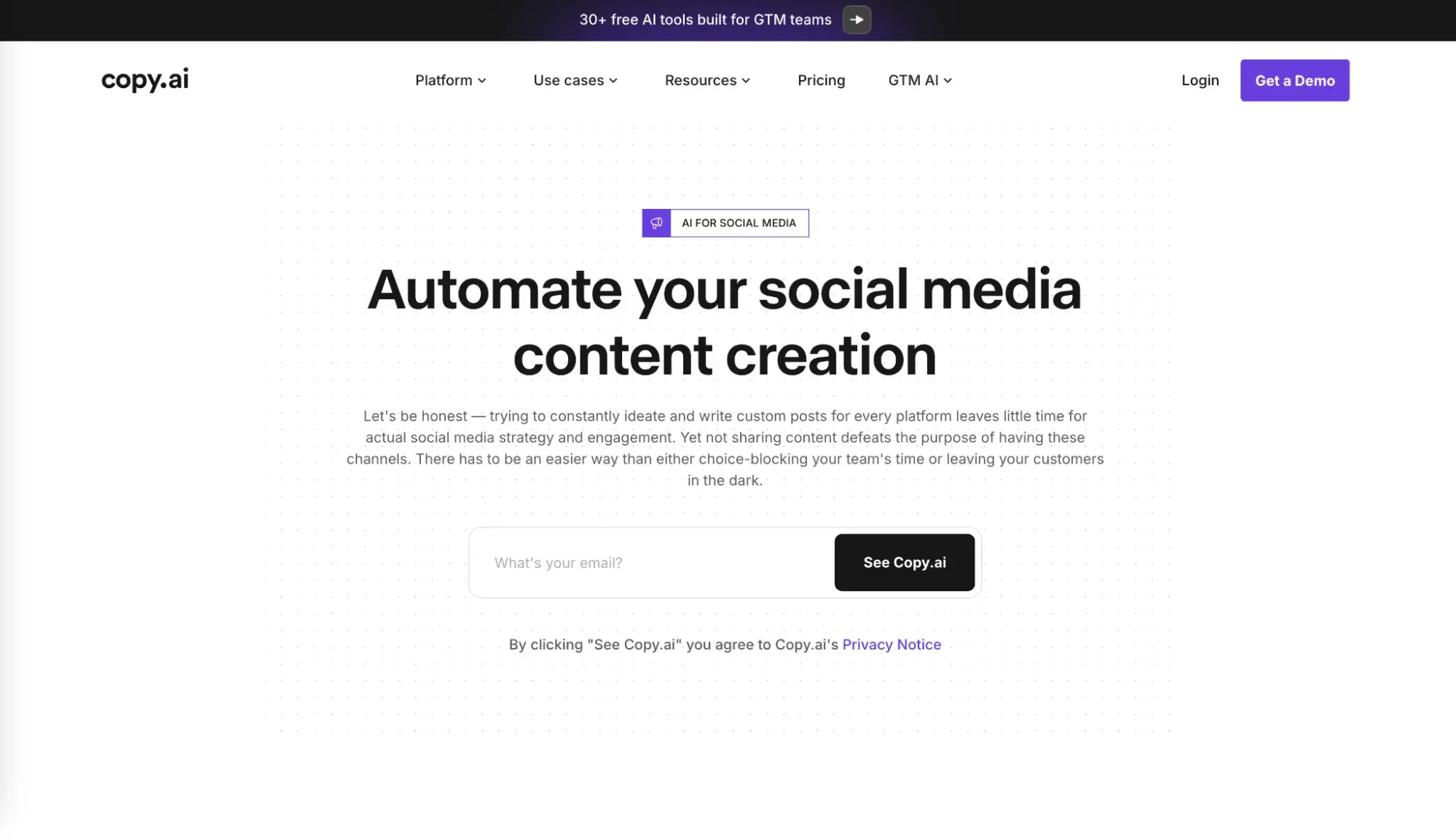
Writing the perfect copy with the right word count for each platform can take hours of your day. Copy.ai helps automate the process of ideating and writing custom posts by generating hundreds of social posts in just a few clicks.
With Copy.ai you can automate captions, descriptions, short-form video scripts, and also generate and repurpose content, and then integrate it with more than 2,000 tools that you might already be using.
Best for: Writing custom content.
What I like: Copy.ai lets you generate multiple versions of copy, creating personalized posts in seconds.
Pricing: Plans begin with a free version, increasing to Starter ($49), Advanced ($249), and Enterprise (custom) billed monthly. But you can save 20% by paying annually.
Copy.ai Case Study
Andrew Lokenauth, founder of the site Fluent in Finance, uses Copy.ai as his go-to tool for social posts, noting “it saved me about 15+ hours each week on content creation.”
As an example, he says, “Last month, my team generated over 200 social posts using Copy.ai, and our engagement rates jumped by 47%. The tool learns from your brand voice over time, which means less editing on my end. Plus, the analytics integration helps me track which AI-generated content performs best.”
5. Canva
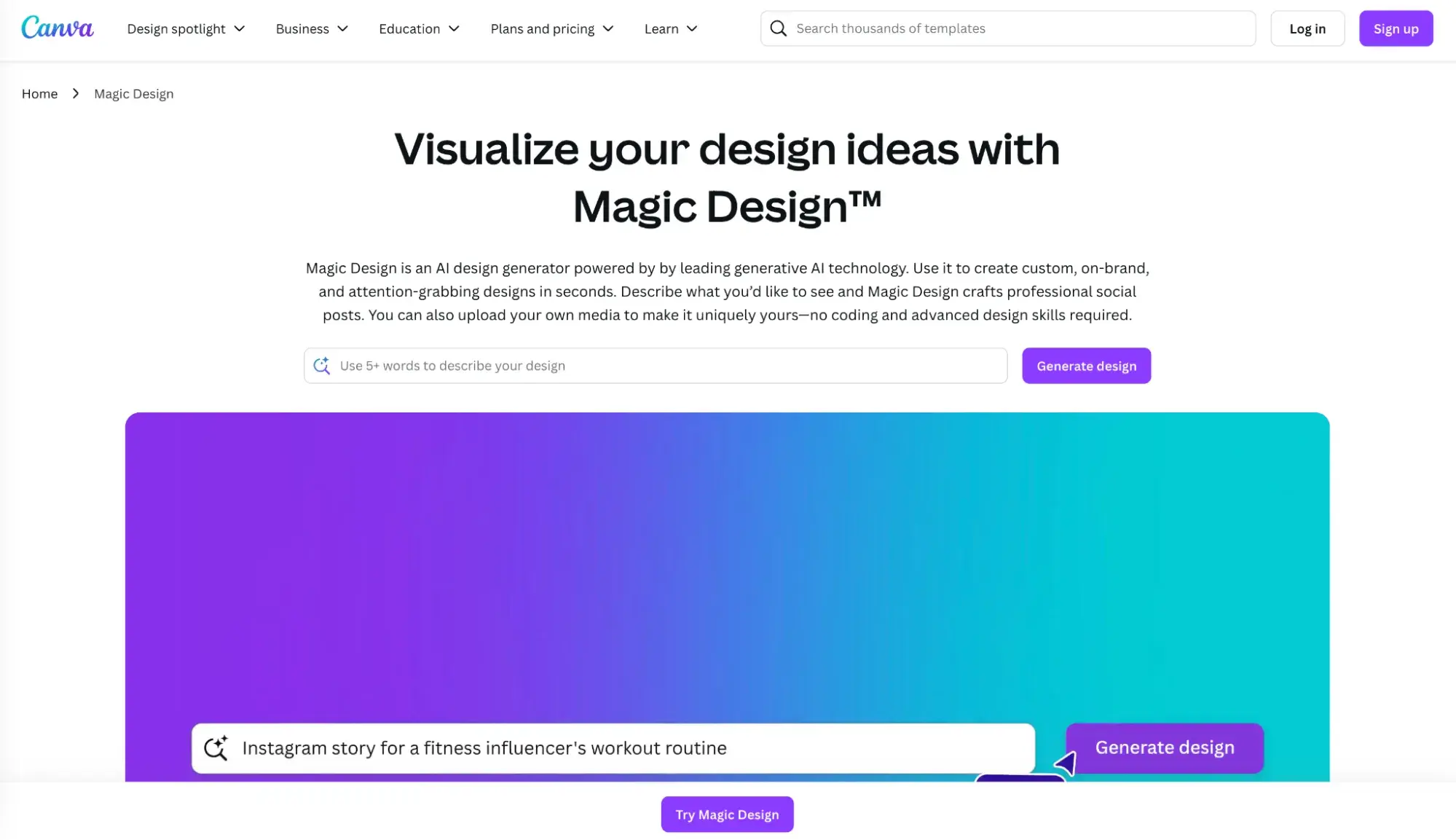
Canva is a well-rounded design platform that does a lot more than social posts, but its suite of “magic” features, which use AI to generate visuals and text, are great tools to complement the scalable selections on this list.
Magic Write generates and refines text, while Magic Design produces a collection of on-brand designs to choose from when you feed it a prompt (it can be as simple as “Instagram story for a fitness influencer’s workout routine”). You can also use the Magic Design feature to create videos and reels.
Magic Switch takes you from generation to transformation through resizing, translating, and reformatting your posts. This helps with workflows in multichannel campaigns.
For modifying visuals that already exist, Magic Grab lets you reposition and resize objects within an image, and Background Remover amazingly erases existing objects like they were never there.
Best for: Designing visually stunning posts.
What I like: Canva is easy to use with a wide variety of templates to start from. The AI features up the game on an already impressive design tool.
Pricing: While some of the AI features are available in the free plan, if you want to use Magic Design, you’ll need to upgrade to Canva Pro (for individuals) or Canva Teams. Plans start at $15/month or $120/year per person.
Canva Case Study
Co-CEO of Viva Executive Assistants, Fineas Tatar, explains that creating and editing content feels like the last thing on your list “when you’re building a startup and trying to manage time as efficiently as possible.” In order to repurpose images for social, he encourages his teams to use tools like Background Remover or Magic Write to draft posts quickly using existing content.
“Using these tools to get time-consuming work out of the way and free up more mental energy for strategic thinking can mean better outcomes for everyone,” he says.
6. Narrato
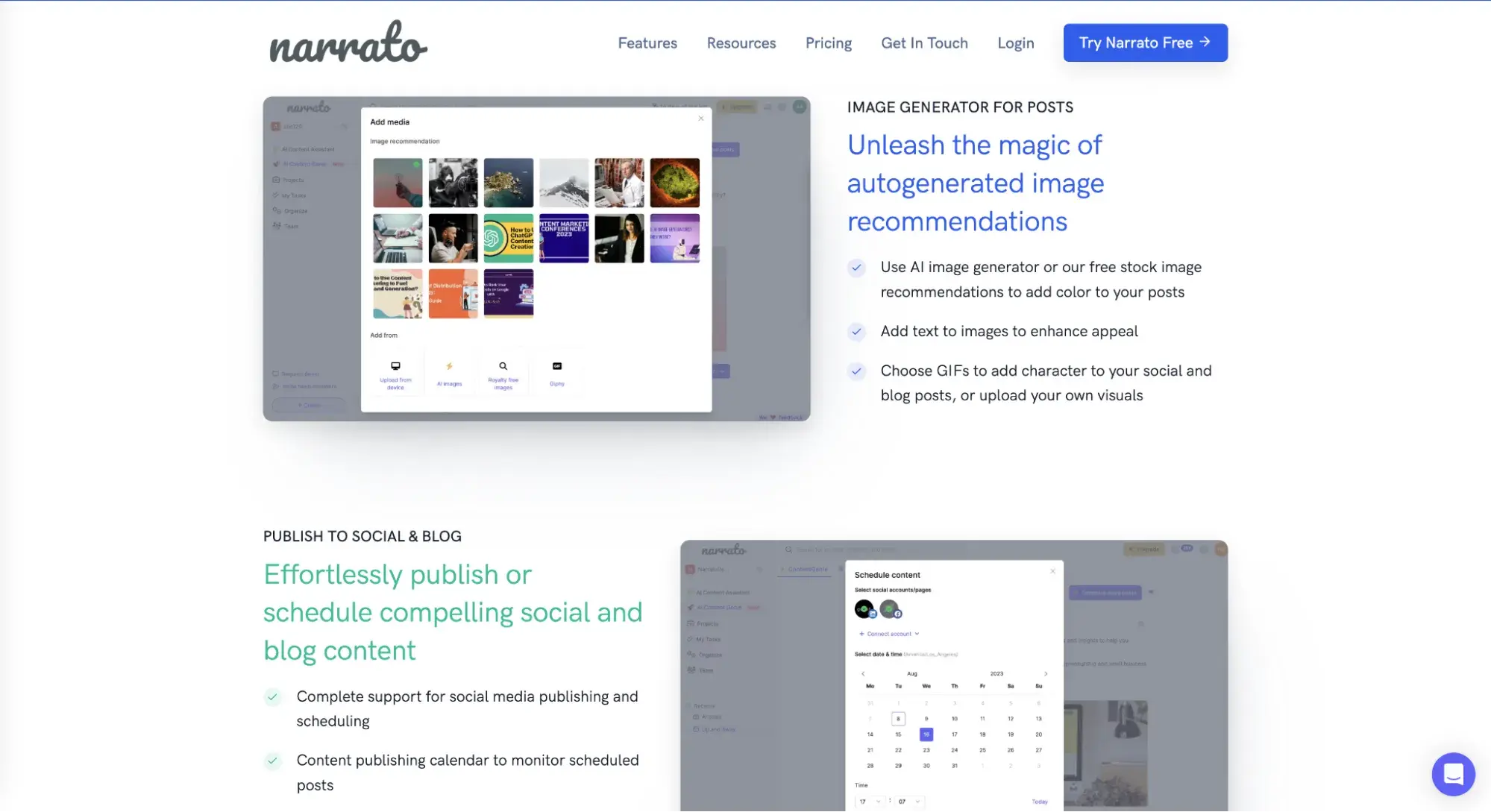
Narrato offers a host of AI tools for content creation and marketing, but the one I like best is AI Content Genie. After adding a website URL and a few content themes, the tool will continue to generate social media posts automatically each week, with no further inputs required.
In addition, Narrato offers AI Content Assistant to quickly create content using over one hundred tools and templates. You can also create your own templates using chat prompts, as well as use AI to generate images, edit, and tailor to your brand voice.
Best for: Automating content creation, scheduling, and publishing.
What I like: Narrato supports all stages of social media content production, from planning to publishing, making it a good all-in-one platform for social media marketing.
Pricing: Narrato has three plans, starting at $36 per month. The Pro and Business plans come with four user seats, while the Enterprise plan comes with 10.
Narrato Case Study
Safe Systems, a technology company serving community banks, faced challenges in content production due to a small marketing team and high outsourcing costs. By switching to Narrato’s AI and automation tools, they saved $90,000 annually and increased content efficiency.
Narrato’s platform is helping Safe Systems meet content demands with SEO tools and content repurposing features, allowing them to produce diverse content types, including social media posts, with ease.
According to the CMO of Safe Systems, Christine Ray, “Using Narrato has enabled us to increase our social media posts by 300%, driving more brand impressions and engagement.”
7. Jasper

A generative AI platform for marketing, Jasper integrates AI into workflows and apps. For social, use Jasper to write captions, share insights, or generate ad copy. It also features a content rewriter and a background remover for images.
The company boasts an AI document editor that’s trained in marketing best practices, alongside a marketing-trained chat assistant that moves you through ideation to execution. You can also configure Jasper to adhere to your brand’s voice and internal style guide, cutting down on editing time.
Best for: Automating end-to-end marketing workflows.
What I like: Jasper can match brand voice consistently, but also help you stay on top of locality-based differences in your content to match each market.
Pricing: Jasper has Creator ($39), Pro ($59), and Business (custom) plans that are priced per month and per seat.
Jasper Case Study
QliqQliq, a digital marketing agency based in Toronto, uses Jasper for copywriting to generate “rich high-quality captivating content tailored to different audience segments,” says digital marketer and founder Anton Kovalchuk. The tool ensures they maintain the same tone and messaging on everything they put out.
For a campaign with a yoga brand that aimed to draw in client interaction and build leads, the team used social listening to learn about holistic health. When they heard about specific stress-relieving techniques, they “asked Jasper to create articulately and convincingly well-researched, content-rich articles addressing trending wellness topics.” They then coupled this with Canva for infographics and carousel posts.
“Three months later, the result was a 40% increase in engagement for our customer, 25% more leads, and a surge in visits to the website through social channels.”
8. Emplifi
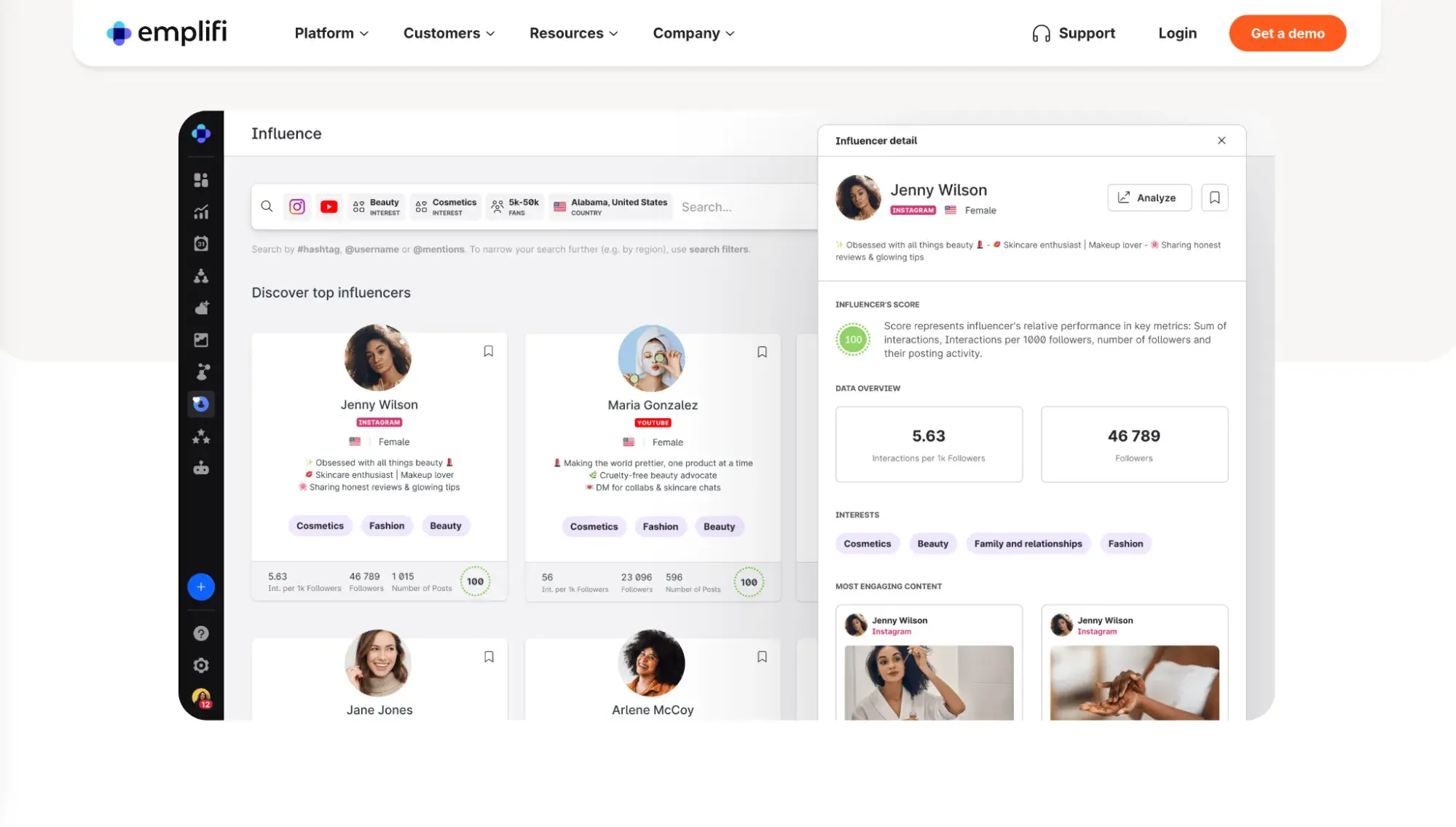
Emplifi is an AI-driven social media management platform that provides advanced audience insights through a unified analytics dashboard, content feed, and smart scheduling tools.
Emplifis’ AI-driven influencer management dashboard streamlines the processes of finding, vetting, and keeping up relationships with influencers in order to build awareness and track campaign performance. With over 30 million influencers in their database, partnering and building connections is simplified through AI filters that allow you to match based on interest, language, or hashtag.
Best for: Finding influencers to work with.
What I like: Emplifi Social Marketing Cloud allows you to generate custom reports to uncover actionable insights that drive business results.
Pricing: Emplifi Social Marketing Cloud costs $200 per month, billed annually, with a 10-profile limit. For all plans, contact the company for a demo and pricing estimate.
Emplifi Case Study
Organix, the UK’s premier baby and toddler finger food brand, collaborated with influencers for their WonderDen campaign. The goal was to establish authentic and trustworthy connections between the brand and its community.
To manage the campaign, Organix leveraged the powerful Emplifi Social Marketing Cloud. The software allowed the brand to track content performance across all social media touchpoints, including both influencer and brand-generated content.
As a result, Organix achieved a remarkable 34x engagement efficiency.
9. Brandwatch
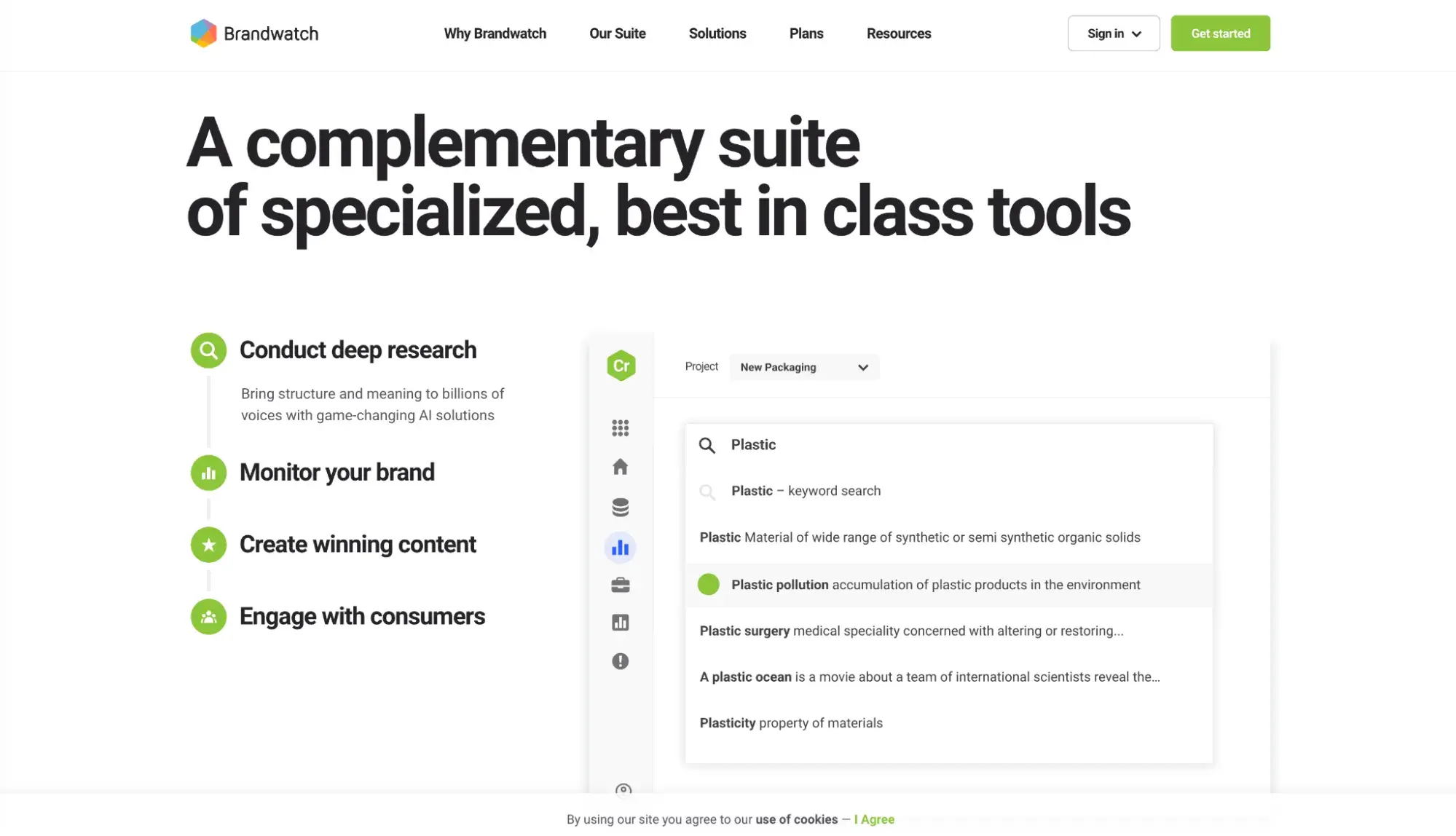
With historical and real-time consumer data, Brandwatch lets you filter millions of posts, comments, and conversations to see what’s relevant to your brand. You can then categorize conversations by complaints, opinions, or feedback, and use AI to spot patterns in the data and generate insights.
Image analysis allows for searches of objects, actions, and logos to dig even deeper into understanding consumers. Using machine learning, the data will then automatically be classified to suit your needs.
Best for: Sentiment analysis.
What I like: Data going all the way back to 2010 allows you to spot trends over time to see how opinions on your industry have changed and how it’s viewed minute to minute.
Pricing: Plans are available for Social Media Managers and Influencer Marketers and both require contacting the company for pricing to suit your needs.
Brandwatch Case Study
Oppizi, a New York startup offering data-driven offline marketing technology, has found success with Brandwatch as a sentiment analysis tool.
They tested it on a campaign in Australia to track how people were responding to a flyer distribution campaign with a digital promotion. “By tracking social mentions and gauging sentiment before and after launch, we could see the offline push translate into online conversation,” says marketing expert and CRO specialist Nicolas de Resbecq.
“There was a clear spike of activity after a week of distribution, and that was enough for us to be justified in continuing the campaign.”
10. Hootsuite
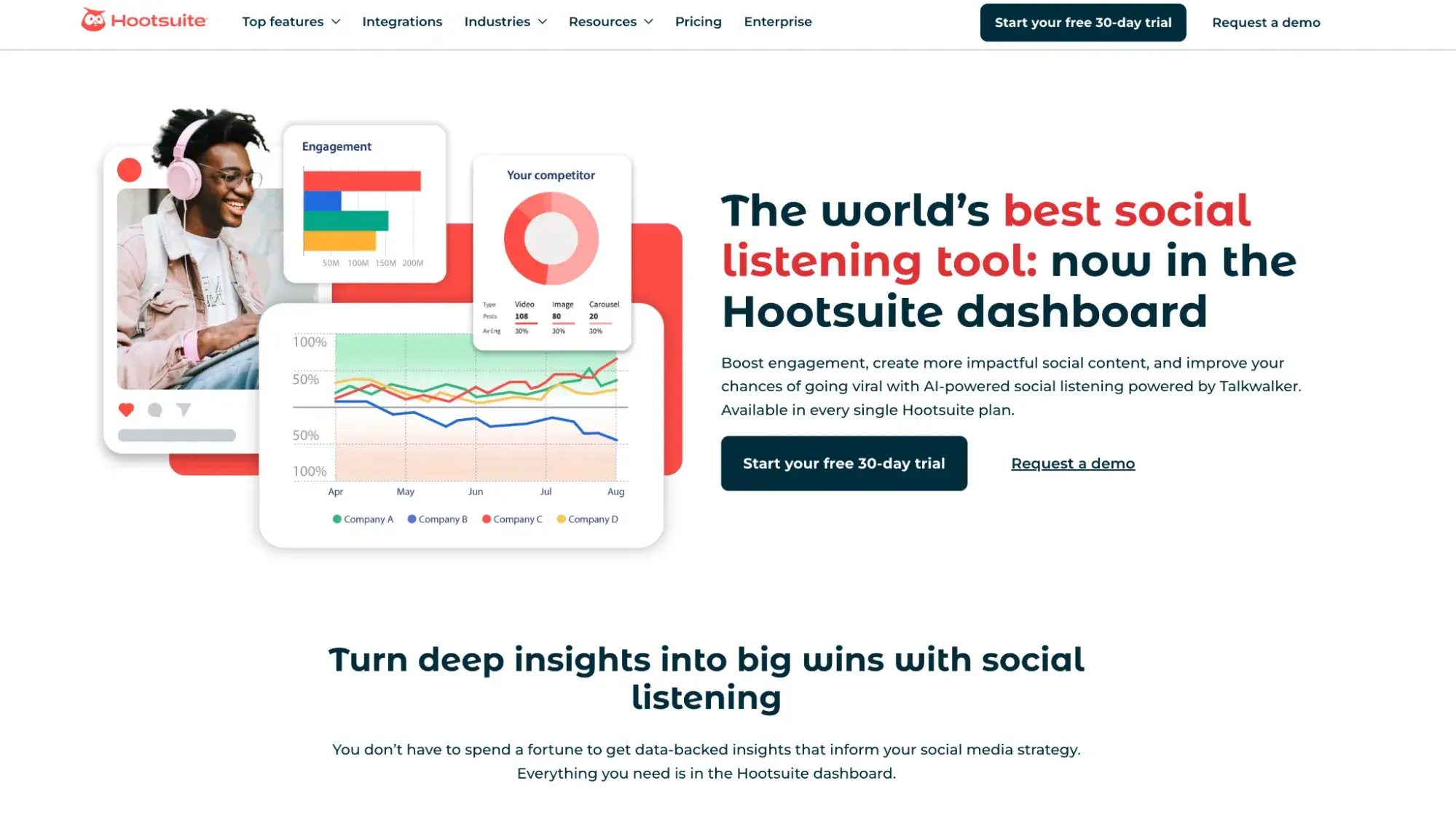
Built for social listening, Hootsuite uses AI for sentiment analysis, summarized insights, and real-time media monitoring. Plus, with AI image recognition, you can track your logo across video, memes, and GIFs.
AI-powered insights are delivered in real time, and you can automatically generate briefs based on the metrics you care about. As you track positive and negative feelings around your brand, you’ll also be able to hop into conversations as they happen (for example, to react to misinformation).
Best for: Social listening.
What I like: You can schedule, monitor, engage, and analyze all from a single dashboard, saving time and simplifying the process.
Pricing: Plans include Professional ($99), Team ($249), and Enterprise (request a demo), priced monthly and billed annually. The non-enterprise plans both offer a 30-day free trial.
Hootsuite Case Study
Luke Chapman, senior SEO strategist at Simpro Group, relies heavily on Hootsuite for social media marketing. “It provides real-time data on social trends and customer sentiment, which is crucial for tailoring content to what our audience is talking about at that moment. Being able to track and respond to these conversations is key to staying relevant and engaging with the community,” he tells me.
“A specific success we had using Hootsuite Insights was when we were able to identify a growing trend around sustainability that aligned with our brand’s mission. By using this tool to monitor social conversations, we quickly pivoted our content strategy to include eco-friendly messaging, leading to a 30% increase in engagement across our social channels in just a couple of weeks.”
11. Vizard
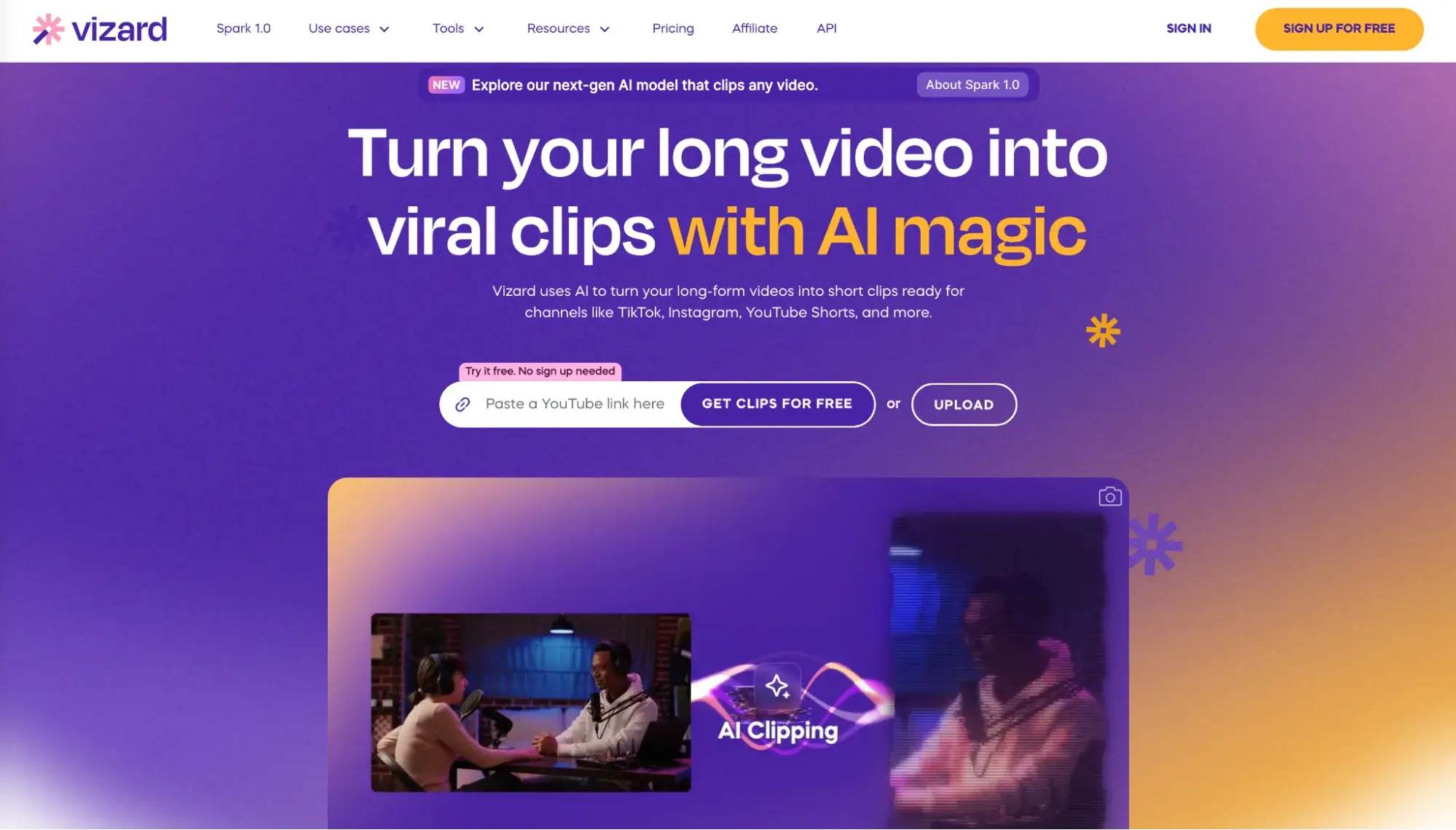
Vizard uses AI to turn long-form video into short clips, ready for social channels. In a single click, the tool can produce more than 30 clips from one video. The AI “magic” part of it is that it automatically locates engaging or emotionally charged parts and retains those for the clips.
In addition, it can resize, reformat, and reframe around faces or important objects in your videos. And then, to make sure the clips are ready to post, AI can add captions, emojis, or hashtags to match what performs best.
Best for: Turning long-form video into short clips.
What I like: Video editing can be taxing when it requires continual rewatching, and Vizard can save hours of time by automating the task.
Pricing: Vizard has a free version, which includes 60 upload minutes per month. Its Creator and Business plans start at $14.50 and $19.50 per month, respectively, with annual billing.
Vizard Case Study
“I have tried many AI tools, but the best one I have used is Vizard,” says Spencer Romenco, chief growth strategist at Growth Spurt, a video marketing agency. “It tracks things like facial cues, voice tone, even posture, and flags moments that hit hardest with an audience.”
“We used it with a DTC fitness brand that had a backlog of over 20 hours of user-submitted workout videos,” he tells me. “After training Vizard to detect specific moments such as first-time lifts, personal records, and raw emotional reactions, we were able to process the entire backlog in under two months. The result was over 120 short-form clips, fully formatted for TikTok, Reels, and Stories.”
“One content batch alone drove a 41% jump in Instagram Story conversions. It worked because the edits kept the energy of the original footage intact, without heavy post-production or forced polish.”
12. Jacquard
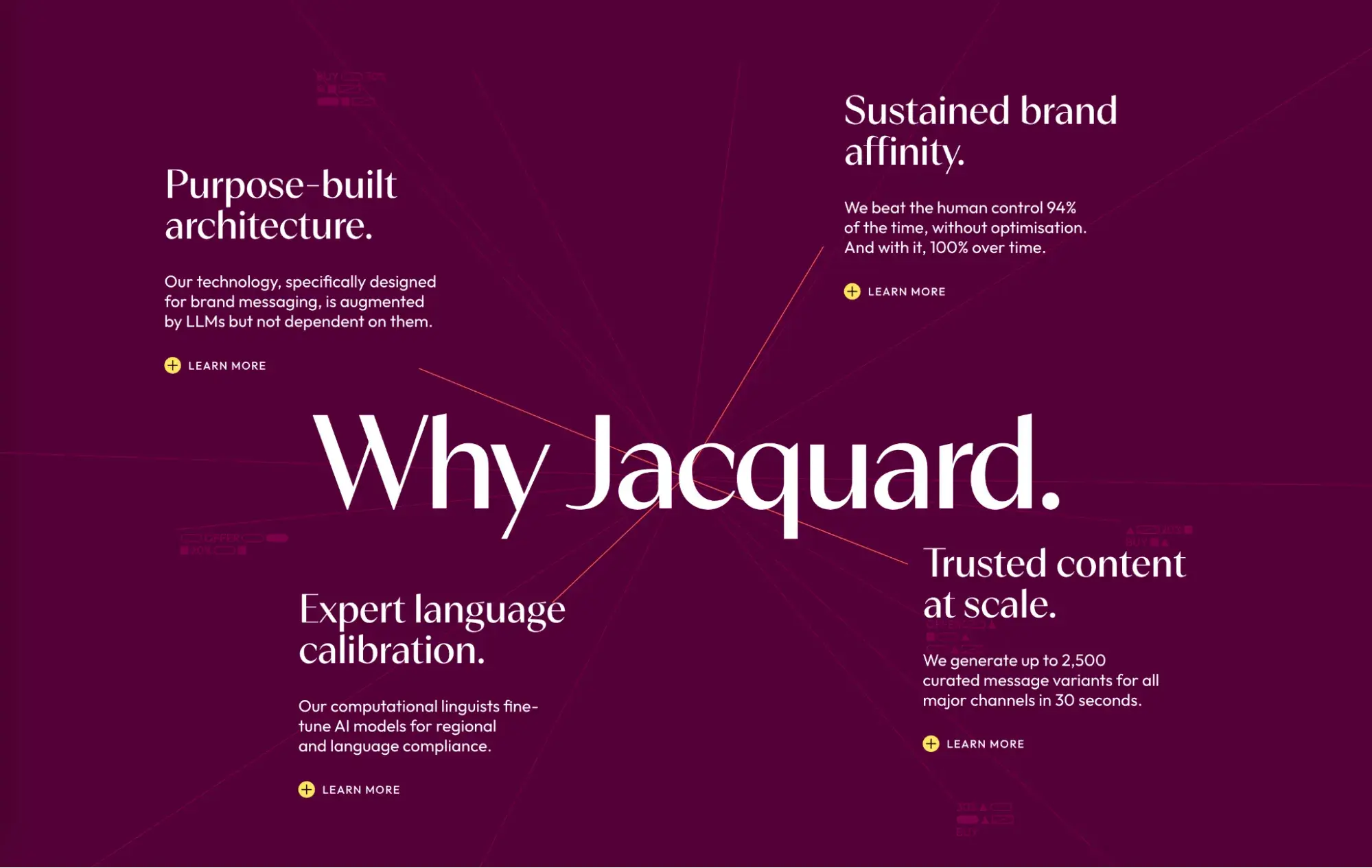
Jacquard (which was Phrasee until June 2024) is focused on brand messaging. In half a minute, it can generate up to 2,500 curated message variants for all major channels and predict top-performing variants.
Boasting content generation at scale, it curates and optimizes large volumes of on-brand content by testing and adapting in real time. It’s also a way to personalize communication at scale, with just as many messaging variants.
Best for: Analyzing language patterns to find exactly what works.
What I like: Jacquard analyzes the language structure of posts that were successful with your audience and then matches its variants to them in order to replicate that success.
Pricing: Prices are available upon request.
Jacquard Case Study
Tracie Crites, CMO of Heavy Equipment Appraisal, explains why she stands by Jacquard.
“We used it during a campaign aimed at equipment owners ahead of the insurance renewal season, which is a topic that usually gets low interaction. [Jacquard] produced multiple caption variations built around behavioral patterns from past campaigns. One version, ‘3 valuation mistakes that delay your insurance payout,’ lifted Facebook click-through rates by 6.3% and tripled LinkedIn comment activity.”
She concludes, “That jump didn’t happen because of a new visual or offer. It came from phrasing designed to trigger curiosity and action, using patterns that had already proven effective with our audience.”
13. Synthesia
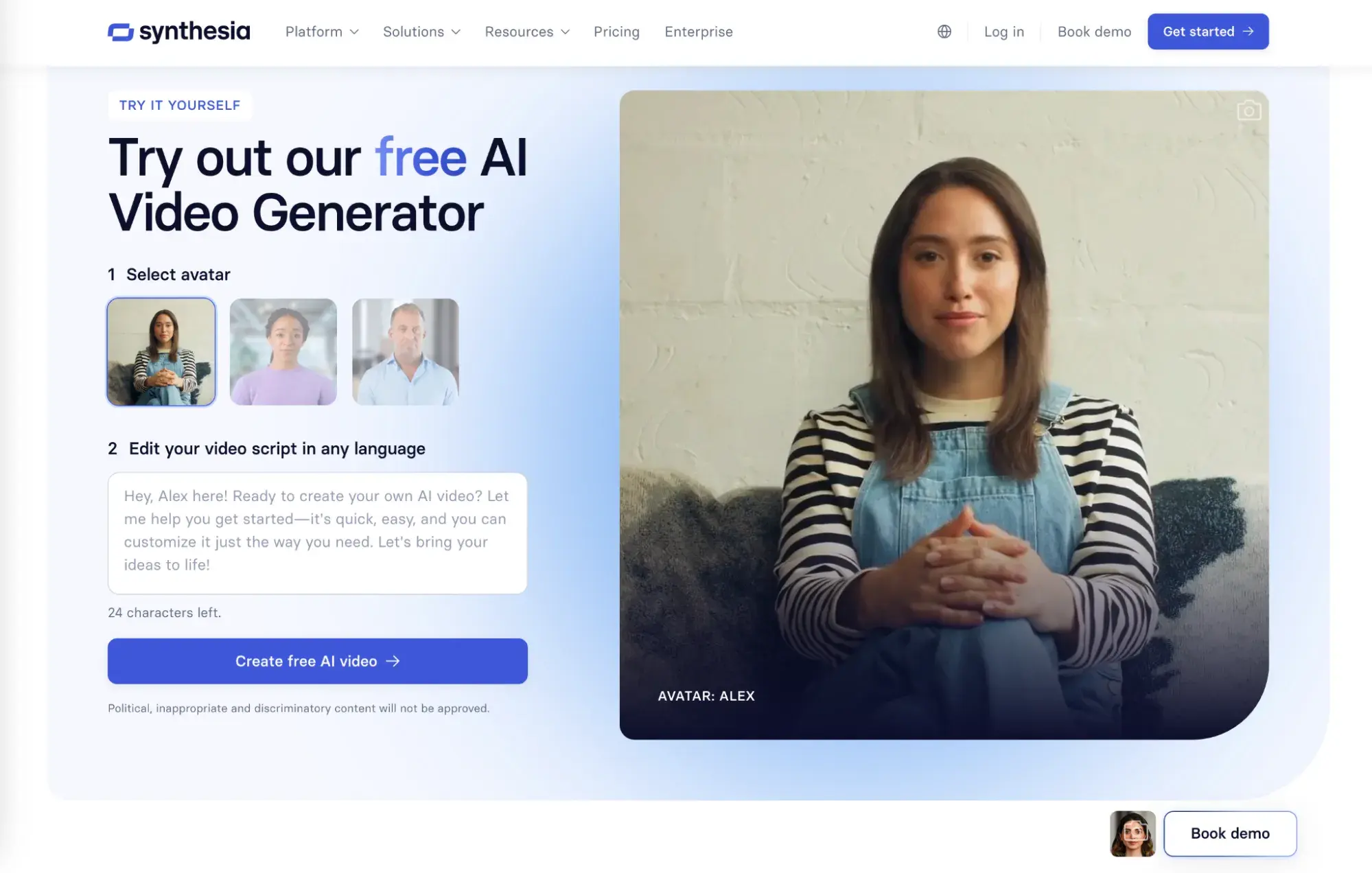
Synthesia is an AI video generator that uses avatars and voiceovers in 140 languages to create video content. You start by creating a script, then customize your video with an avatar, and finally share your video with a link.
While the avatars are pre-made, there are over 230 to choose from, along with video templates and the option to use AI to generate ideas for scripts.
Best for: Creating videos at scale.
What I like: If you’re creating many informational videos that need to go out fast and often, this tool can help.
Pricing: Synthesia has Starter ($18), Creator ($64), and Enterprise (custom) levels, which are billed yearly.
Synthesia Case Study
Sharecat Data Services started using Synthesia when they needed a way to explain a big SaaS upgrade without filming an entire production.
“I work closely with our social media and content team, and getting high-quality video done fast — without flying people in or booking studios — was a real challenge,” says Data Services Director Kristine Fossbakk.
“Synthesia let us create simple, clean videos with voiceovers and avatars, in multiple languages, and we did it all in about two weeks. We made 12 versions for different regions. That alone saved us nearly $18,000 compared to the usual route. More importantly, we reached over 40,000 people between LinkedIn and email, and the reactions were really positive.”
After sticking with the approach for internal training and investor updates, she adds that “It’s cut our content turnaround time by about 40%.”
14. Predis.ai

Predis.ai is focused on AI ad creatives and social posts to meet your brand guidelines. Type in a few words of what your ad is about and its AI tool will generate ad content with text, visuals, or video. You can also generate headlines, captions, and copy — and in more than 18 languages.
The same goes for other social posts, whether you’re making a meme or a product post from your ecommerce cataloge. To make sharing easy, Predis.ai connects to all major social platforms, so you can create, schedule, publish, and even continue to edit, all from one location.
Beyond that, this tool can help with competitor analysis by digging into the competition’s content patterns. AI features then analyze what’s working and what’s not, so you can get a leg up on what might work similarly for you.
Best for: Competitor analysis.
What I like: Predis.ai offers a simple site and list of features that offer both content creation and insights into the competition.
Pricing: There are four plans available: Free, Lite ($27), Premium ($36), and Enterprise ($212) billed monthly.
Predis.ai Case Study
Daniel Vasilevski, owner and director of Bright Force Electrical, who also handles the social accounts for the 24/7 residential and commercial electrical services provider, says that fewer people talk about Predis.ai, but it’s his most reliable tool for analyzing the competition and predicting industry trends.
“I used it before the summer season last year to plan a campaign promoting our emergency electrical services. The tool identified that short, problem/solution-style reels with captions like ‘No AC in a heatwave? Here’s what to check before calling us’ performed best. I followed its recommendations and saw a 37% increase in engagement within two weeks. More importantly, those posts drove a 20% uptick in emergency service calls during what’s normally a slower period.”
In addition, the tool’s competitor analysis gave him information about the gaps in how other electricians were positioning their services. “So, I adjusted our messaging to highlight 24/7 availability more prominently,” he says. “If you’re in a trade business, this is the kind of tool that helps you stop guessing and start posting what actually converts.”
15. OpusClip

An AI video clipping tool, OpusClip turns long videos into shorts and then publishes them directly to all your channels. Using AI to identify the most compelling extracts, it then cuts and arranges those extracts into curated short-form content of its own.
While other tools on this list do the same, this one stands out from “the other ones I have used since it can analyze speech patterns, audience retention cues, and even background music to predict viral-worthy moments, which is something most basic clipping tools miss,” says Robbin Schuchmann, co-founder of EOR Overview.
AI also reframes videos to adjust for various aspect ratios, detecting speakers and moving objects. And if you want to add animated captions, the tool can do this automatically with various templates to choose from. Within its platform, you can also schedule, analyze, and collaborate to streamline your workflows.
Best for: Quickly clipping long-form videos into shorts.
What I like: It leverages big data to analyze video content in relation to the latest social media trends, enabling it to highlight moments in your video that are most likely to go viral.
Pricing: OpusClip has three plan levels (Starter, Pro, and Business) above its free forever level.
OpusClip Case Study
Schuchmann, who also manages the company’s social strategy and content direction around global employment topics, says OpusClip is the tool he considers best and uses most regularly.
“Last quarter, we repurposed a 45-minute webinar on global hiring compliance into short clips using OpusClip. The tool identified a 12-second segment where our speaker broke down a common payroll mistake in Germany.”
“That clip alone generated 3x more engagement than our usual posts and drove a 20% increase in sign-ups for our compliance guide. The best part was that it took minutes, not hours, to find and edit that moment.”
AI for Every Social Media Marketer
If AI still seems like an overwhelming subject, don’t worry. You’re not alone. But what I learned while talking to marketers who worked with these tools is that the point of AI is actually the opposite: to ease the overwhelm.
Instead of feeling like competition, AI tools for social end up feeling like assistants — ones that are super competent in taking over the routine, repetitive, or time-consuming tasks that were keeping us underwater in the first place.
Editor’s note: This post was originally published in November 2019 and has been updated for comprehensiveness.
![]()
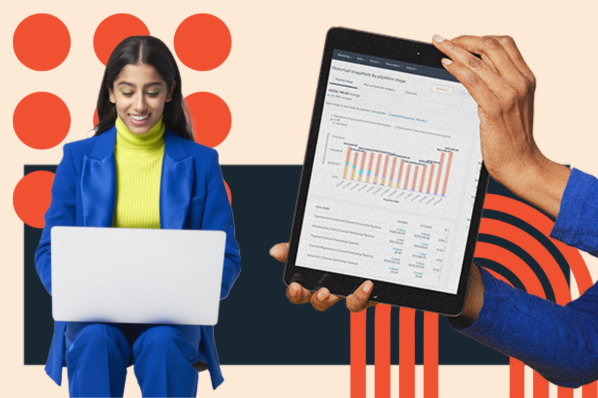
How to create an infographic in PowerPoint [free templates]
As a former digital journalist and now a content creator at HubSpot, I’ve designed everything from breaking news graphics to viral memes — but infographics are where real impact happens. Whether it’s a marketing funnel breakdown or a customer journey map, a great infographic makes […]
MarketingAs a former digital journalist and now a content creator at HubSpot, I’ve designed everything from breaking news graphics to viral memes — but infographics are where real impact happens.
Whether it’s a marketing funnel breakdown or a customer journey map, a great infographic makes complex ideas simple and shareable.
Honestly, I prefer Canva for quick design, but in this guide, I’ll walk you through how to create an infographic in PowerPoint. I’ve been using it since my college days and know all these little hacks to make it look nice, flow smoothly, and, of course — stick in people’s minds.
Even better, I’ll throw in some helpful tips and give you examples of different types you can work with using our 15 fabulous infographic templates for free within PowerPoint.
Table of Contents
Marketing Use Cases for PowerPoint Infographics
PowerPoint infographics are a powerful tool to present data-heavy information in an accessible, digestible format — no matter if you plan to disseminate the infographic digitally or in person.
You can also simply use PowerPoint as an infographic maker if it’s your preferred design software.
Here are some of the ways I like to use PowerPoint infographics:
1. Presenting a Case Study
I briefly had to write case studies at previous jobs, and let me tell you — they are the bane of my existence.
Writing a beautiful, readable case study is far from easy, so I suggest creating a PowerPoint infographic showcasing the key facts of your case study.
You can include crucial information such as the problem your customer experienced, the solution you served, and the outcome.
You can include aesthetically pleasing graphics and dynamic typography — something you may not be able to include in a traditional, one-page case study.
2. Presenting Research
Since I write for HubSpot’s Marketing Blog, I often present data, trends, and research in my content.
If you‘re in the same boat, you’ll be happy to know you can use all the data visualization options PowerPoint offers to present your data in a digestible way.
Since the infographic will be larger than a typical slide, you can be as descriptive as you want. However, if you’d like to reuse the same information, you only need to copy it into a new presentation.
Pro tip: HubSpot’s Content Hub is all-in-one, AI-powered content marketing software that helps marketers create and manage content. You can start for free here.
3. Presenting a Pitch
You can use PowerPoint infographics to present a pitch to stakeholders or potential buyers.
In this case, your infographics can include data points, testimonials, expected results, and even descriptions of the prospect’s problem to emphasize the importance of purchasing your solution.
Images and graphics can be more effective than just words, and since you’re in PowerPoint, you can create an infographic of any size, including the horizontal 16:9 dimensions.
Want to create sales presentations that actually sell?
HubSpot’s free sales training lesson shows you how to answer prospects’ questions, focus on their needs, and motivate them to buy.
4. Presenting a Multi-Step Process
Whether you’re onboarding a new team or informing stakeholders on a new process, a PowerPoint infographic is an effective medium to communicate your message.
PowerPoint comes packed with plenty of “process” graphics, such as text-filled arrows, cascading charts, and grids.
5. Presenting an Announcement
A complicated company announcement — with many moving parts or components — merits an infographic to make it easier for stakeholders to read and understand.
You can create one right in your PowerPoint presentation and include all pertinent information in one convenient slide.
Alternatively, you can use PowerPoint as a design tool and simply download your infographic for easy saving and sharing.
Did you know you can upload your PowerPoint presentations to HubSpot?
Just head to Library > Files, click Upload files, and select your PowerPoint from your computer – or simply drag and drop it in. Once uploaded, you can add it as a downloadable link in emails, landing pages, or blog posts.
Keep in mind that files are public by default, so if needed, you can adjust the visibility settings in HubSpot.
Okay, now you know the different uses for PowerPoint infographics — time for me to show you what you’re here for.
For better comprehension, I’m going to walk you through how to make a simple timeline infographic in PowerPoint.
1. In the Design tab, adjust the Slide Size to best fit your infographic.
To begin making an infographic from scratch, you have to readjust the size of the PowerPoint Slide to give you more space to work with.
Begin by opening a new PowerPoint. In the top navigation bar, click on Design and select Slide Size.
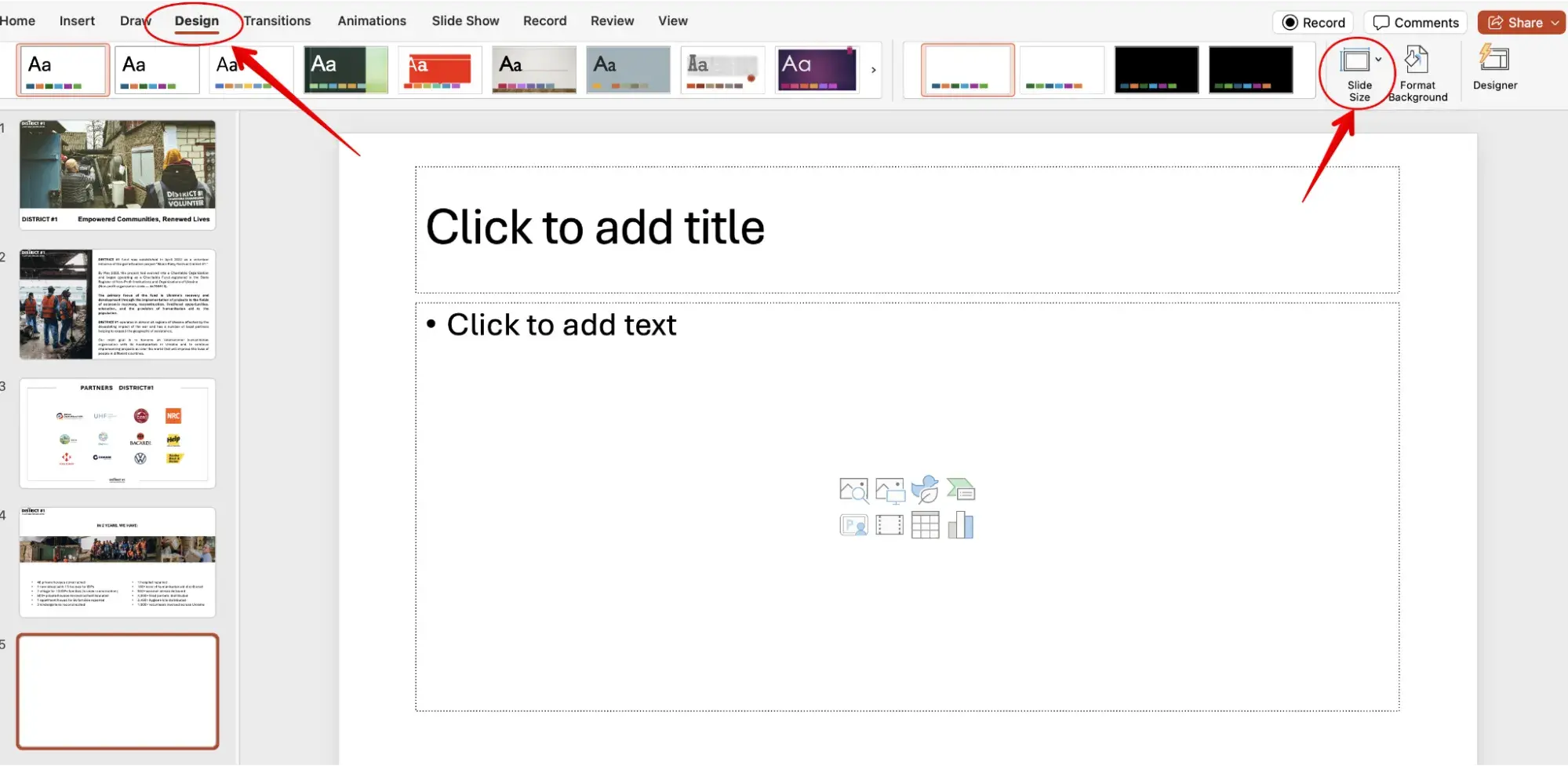
Then, in the drop-down menu, select either one of the predetermined sizes or click Page Setup.

Input your preferred width and height dimensions and click OK.

2. Select SmartArt from the PowerPoint navigation bar.
To make a timeline graphic in PowerPoint, suitable for any infographic, open PowerPoint and click Insert from the top navigation bar.
Then, select the SmartArt icon beneath the navigation bar, where you’ll find several categories of graphics to choose from.

3. Find a graphic that fits your data.
Once you click on SmartArt, you’ll find the options from lists to pictures. I picked the Matrix one for my needs:
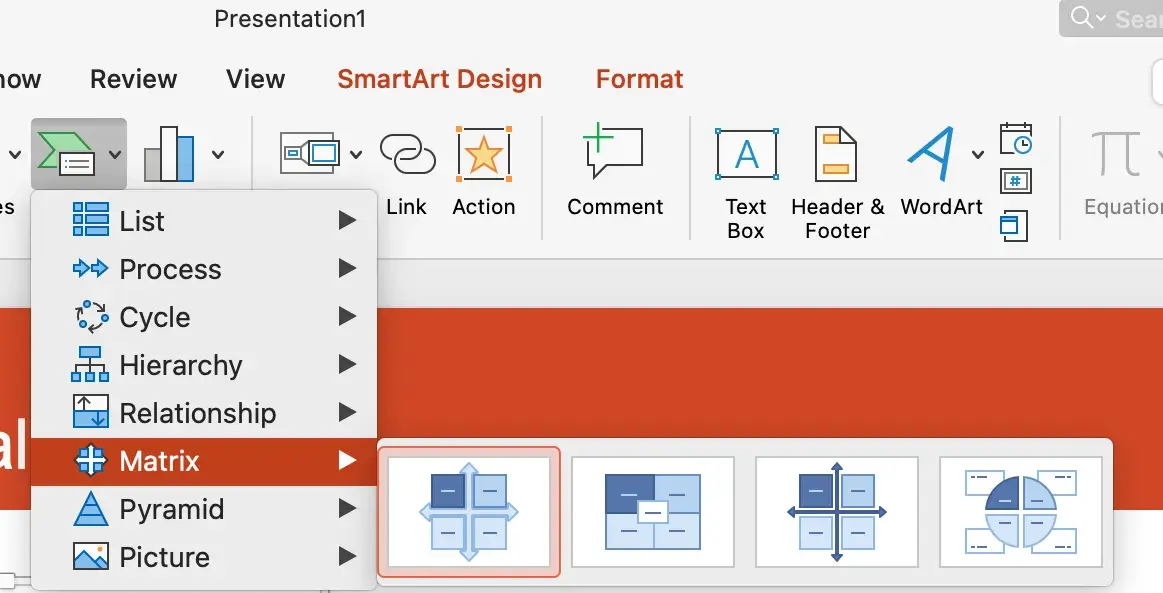
4. Add or remove data points, time stamps, or other key information.
Once you’ve inserted this graphic into your first PowerPoint slide, you can add or remove icons to match the types of data and inputs you’re presenting.

5. Insert your data into the graphic.
At this point, the size of your graphic should match the amount of data you have.
Begin to fill your graph with the information you plan to report and explore PowerPoint’s excellent drag-and-drop features to help arrange graphics as necessary.
6. Edit the text and imagery of your SmartArt graphic.
As with the other graphics available in PowerPoint’s SmartArt, you can edit the text and the images associated with your timeline to your liking.
I’ve added four words to represent each part of the SWOT analysis.

To insert images into my Matrix graphic, I right-clicked the square landscape icon and selected “Format Shape.”
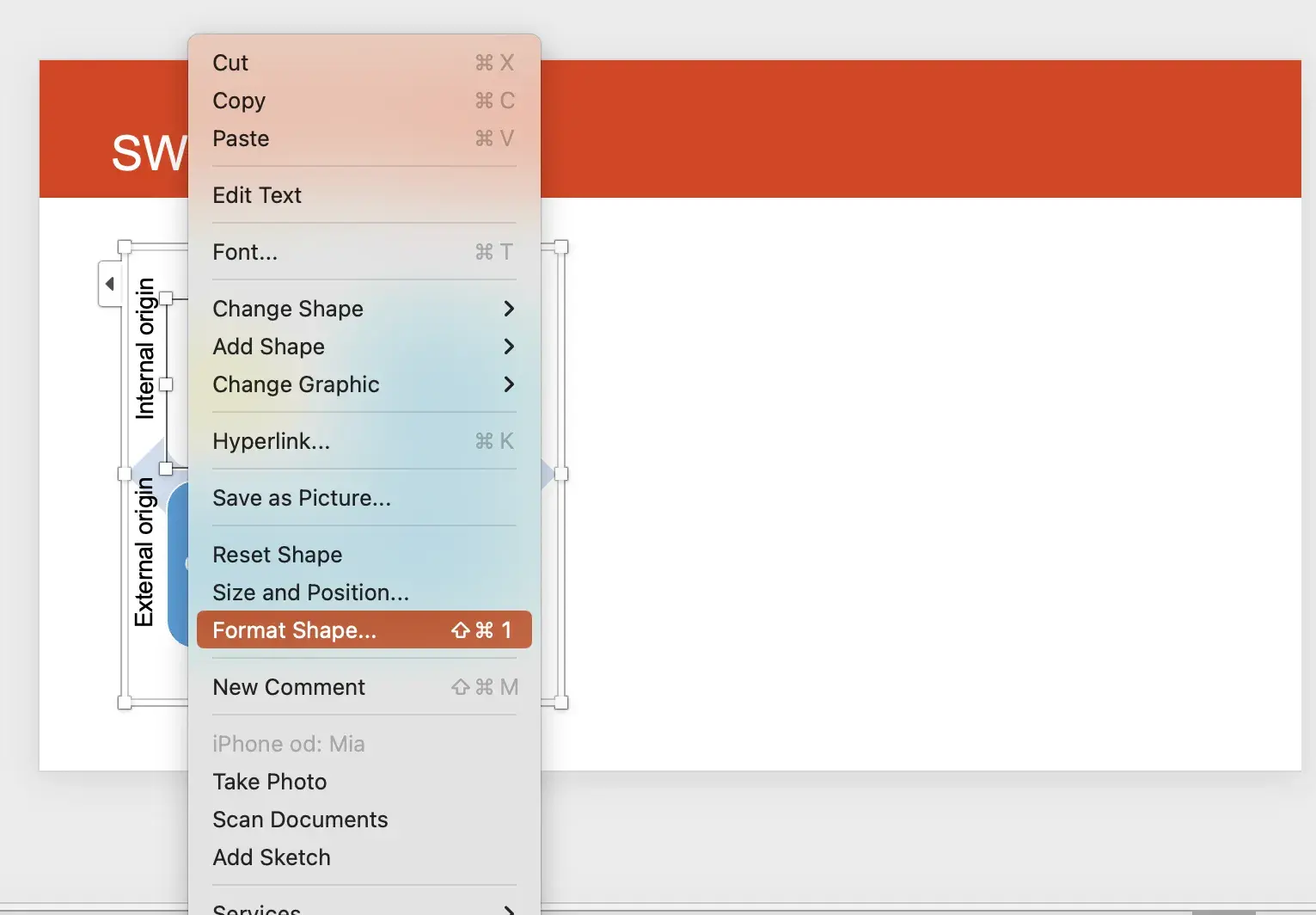
Then I chose “Format Picture” → “Picture or texture fill” and uploaded one image to each of the rounded squares.

Here’s how it looked once I uploaded all of them and highlighted the text.
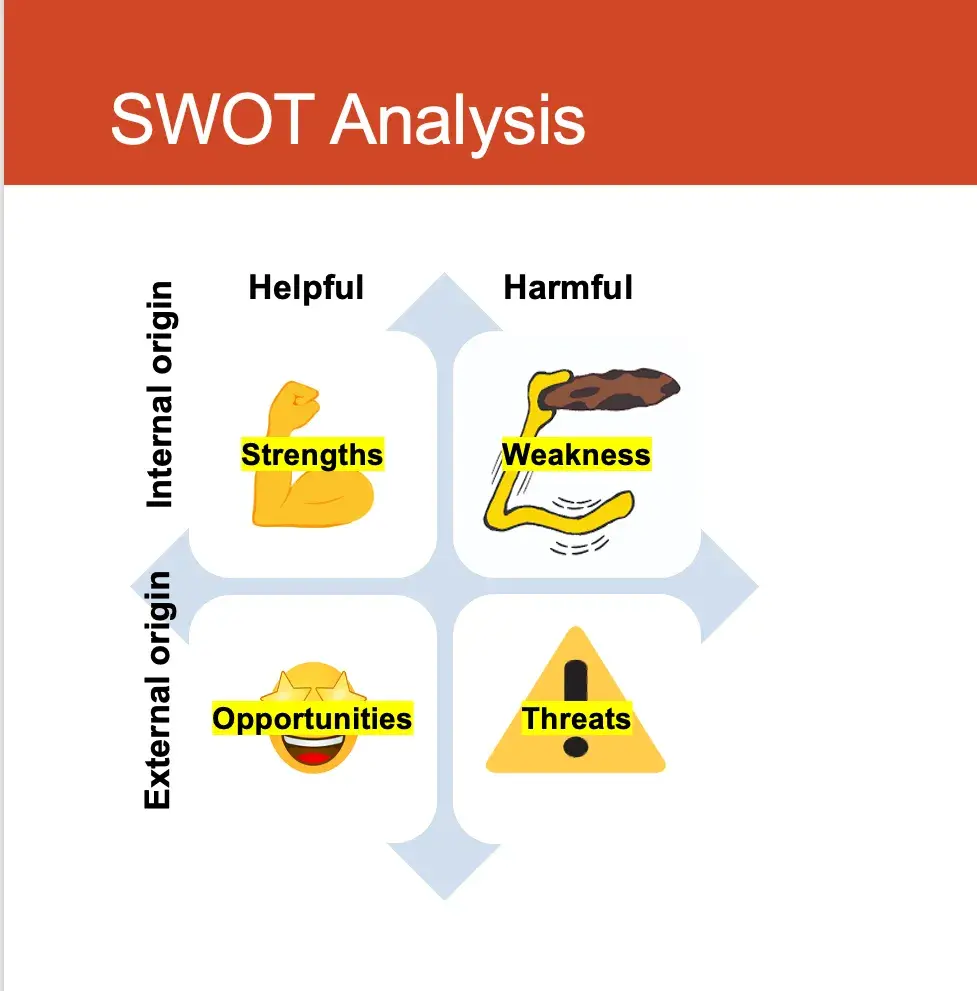
To show you what you can do further, I decided to create another slide. I made up a brand called Green Fairy for this purpose, pretending I wanted to highlight its strengths for SWOT analysis.
HubSpot’s SWOT Analysis Template helps you assess strengths, weaknesses, opportunities, and threats — plus, it includes a step-by-step guide, a real-world example, and a customizable worksheet to turn insights into action.
Get it now to save time on designing.
7. Adjust the color scheme to match your story.
I went to SmartArt again, but this time, I chose the Vertical Curved List.
Since the original had only three fields, and I needed two more, I added them by right-clicking → Add Shape → Add Shape After.

Then I added text to each box, so it initially looked like this:

Honestly, I didn’t like it. Something felt off. So, I right-clicked, went to Format Shape → Fill, and switched it to green.
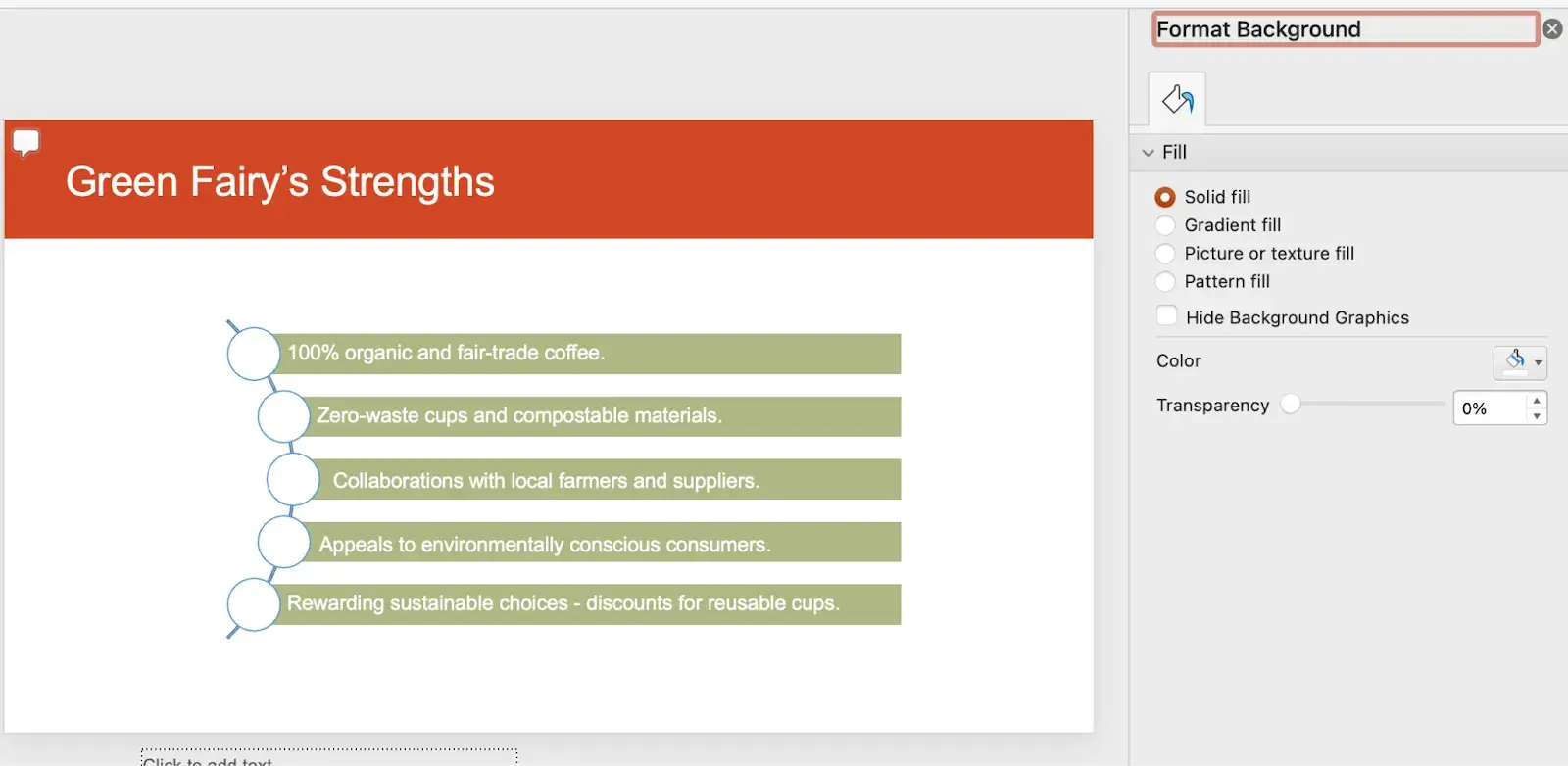
8. Use numbering to improve visual flow.
At this point, I wanted to add numbers to the circles, so I went to Insert → WordArt and picked a style I liked.

Now, it was looking better, but I didn’t like the blue color of the curved lines and circles, so I decided to change them to match the rest. I selected the object, right-clicked → Format Shape → Line, and picked a new color.
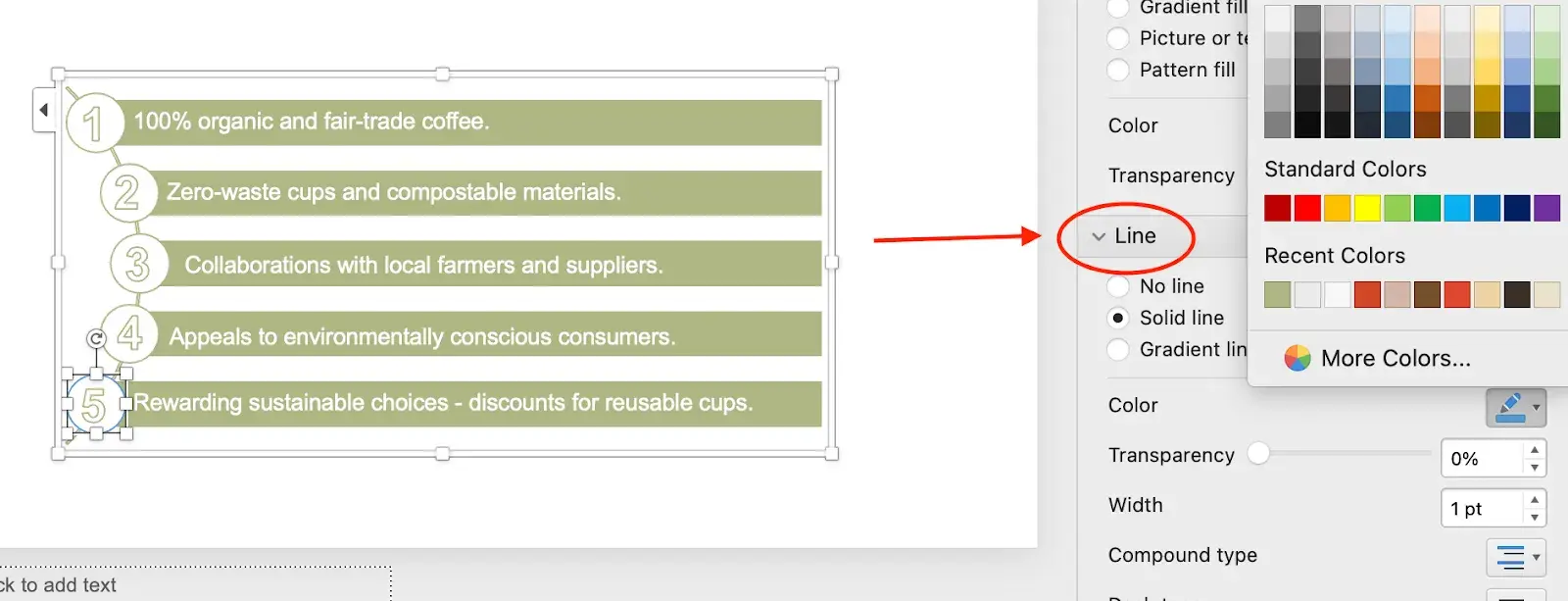
9. Add finishing touches and polish the layout.
It was almost perfect, but I still wanted to fine-tune it because the left side felt empty and disconnected. I tested how it would look with some text there.
I went with WordArt again, picked a font I liked, and added the word “Strengths” on the left to tie everything together.
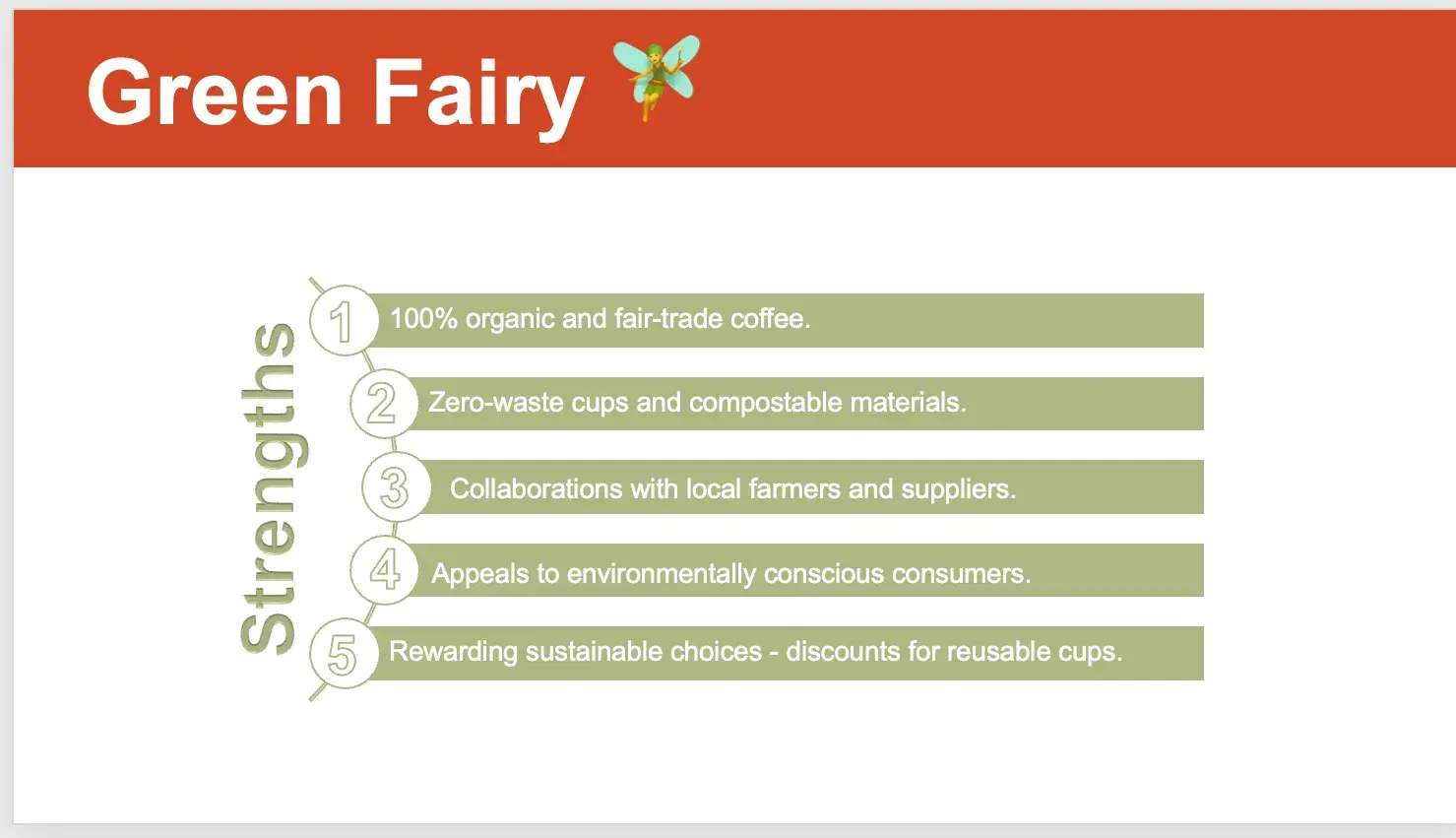
Basically, you can design your infographic however you want – adding background colors, more visuals, or other elements to make it stand out. This was just a basic example, but there are many ways to refine it and make it look even better, more interactive, and more catchy.
If these “design” things are not your cup of tea, you can download our infographic templates that open directly in PowerPoint so you can start creating faster and easier.
PowerPoint Infographic Tips
1. Keep your infographics simple.
I’m a very wordy person in general. I tend to overexplain in regular conversation, and sometimes, I have to remind myself not to use so many unnecessary words to explain simple concepts in my writing.
So, naturally, my infographics were muddled with too much information, photos, and long sentences when I first started making them early into my career. Eventually, I learned the value of K.I.S.S. (Keep It Simple Sweetheart).
When designing your infographics, keep sentences short and only include the most crucial information. Imagery is helpful, but don’t go overboard. Ask yourself if this image or icon helps illustrate your point or if it is just distracting.
2. Use complementary colors.
Use a color scheme that incorporates more than 3-4 colors that complement each other. Even better, stick to your brand‘s colors so your infographic fits with your organization’s aesthetic.
Avoid too many colors or ones that clash. Otherwise, your infographic will look too busy and will distract away from the information you’re trying to convey.
3. Jazz it up with icons, borders, and fonts.
I know I said to keep it simple, and you should, but that doesn‘t mean you can’t have a little fun with icons, borders, and fonts.
You still want your image to stand out, so consider incorporating these elements (sparingly) to leave a lasting impression on your audience.
See how effective these lines are on the category slide in District #1’s presentation.

4. Emphasize numbers.
If you‘re presenting quantitative data, use your color scheme to emphasize crucial numbers. Use the boldest and/or brightest colors to draw viewers’ eyes to the numbers.
You may also want to use shapes like circles or squares to further highlight the information.
Are PowerPoint infographics useful for marketers?
Absolutely. A well-designed infographic in PowerPoint can make a huge difference in how marketing data is received.
From experience, visuals help a lot with these three things:
1. Presenting Results & Pitching
A clear, data-driven infographic makes budget requests simpler to understand – and more likely to get approved.
Actually, people are 30 times more likely to initiate payment when prompted by visuals.
Also, when pitching clients and sending proposals, a compelling visual story often wins over long blocks of text. DemandSage research shows that people remember 65% of info when paired with a relevant infographic.
2. Aligning Teams on Strategy
Infographics keep marketing plans from getting lost in translation across departments. Speaking from experience – laying out a strategy without visuals or a solid presentation is a waste of breath. People hear it, nod, and forget five minutes later.
And if we take into account that our brains process images up to 60,000 times faster than text, it’s easy to see why infographics are such a powerful tool for communication and better understanding.
Plus, when the team hits a roadblock or blanks on something, they can always re-open this presentation and quickly find what they need without back-and-forth.
3. Internal Training & Onboarding
A quick visual guide can be more effective than a lengthy document when training new team members.
Dr. John Medina says we forget 90% of what we hear after three days. But throw in a picture, and suddenly, we remember 65%.
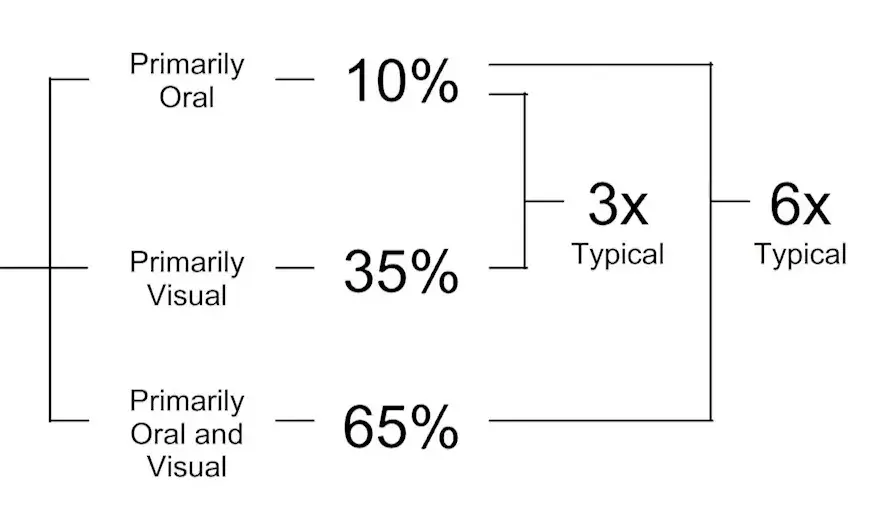
Want to generate even more leads with visuals and other marketing tools? Try out HubSpot Marketing Hub — a leading AI-powered marketing software and drive revenue with memorable campaigns.
PowerPoint Infographic Examples
1. Data-Centric Infographic Example
We’ve loaded this template with a variety of different charts and graphs, which you can easily update with your own data. (Just right-click on a graph, choose Edit Data, and you’ll be able to customize the values in an Excel spreadsheet.)
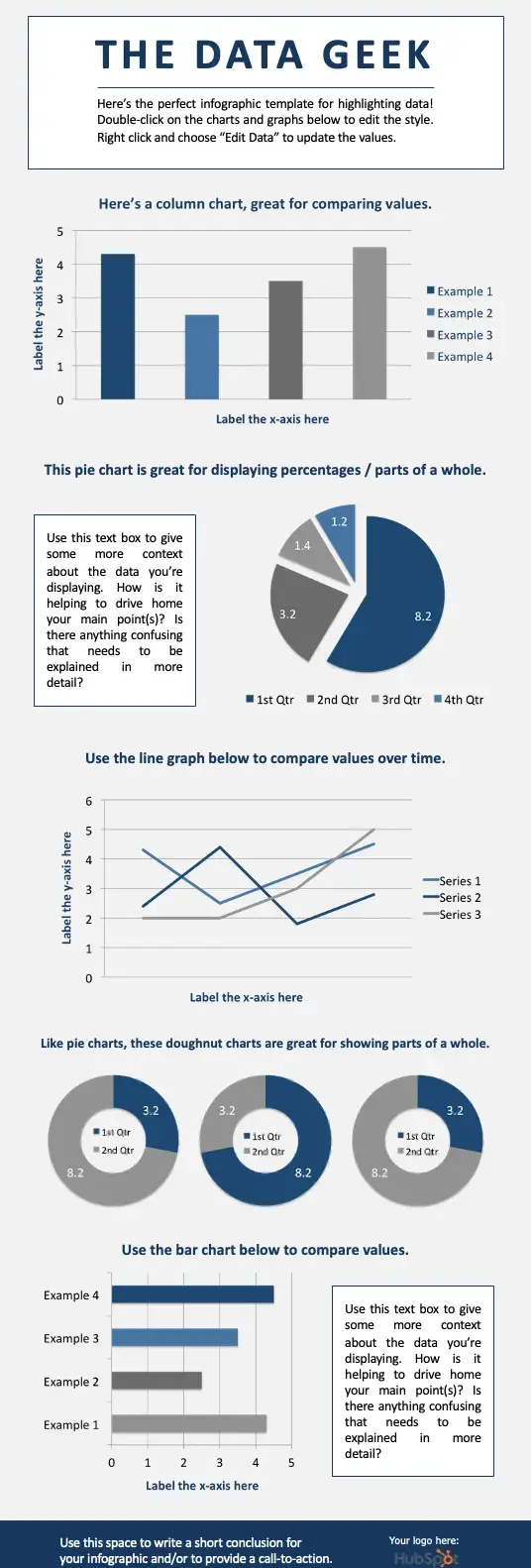
What to Add to a Data-Centric Infographic
- Column chart: Use for comparing different categories or for showing changes over time (from left to right).
- Pie chart: Use for making part-to-whole comparisons. (Note: They work best with small data sets.)
- Line graph: Use this visualization to show data that changes continuously over time. Ideal for displaying volatility, trends, acceleration, or deceleration.
- Doughnut chart: Use a pie chart. This stylistic variation allows you to put a number, graphic, or other visual in the center of the chart.
- Bar chart: Use a column chart. (The horizontal bars make it easier to display long category names.)
What I like: I love this infographic because while it highlights a lot of qualitative data, everything ties perfectly together thanks to its color scheme. It sticks to just three colors, keeping the infographic clean and uncluttered.
When to use: I strongly suggest using an infographic like the one above when you need to present a hefty amount of crucial data as part of a cohesive, visual narrative.
2. Timeline Infographic
Telling the history of a particular industry, product, brand, trend, or tactic can be a great topic for an infographic.
While there are a variety of different ways that you can visualize time — including in a circle, which is what we did with our Google algorithm updates infographic — the timeline is by far the most common and easiest design method to use.

Timeline Infographic Best Practices
- Research. Research. Research: The best timeline infographics aren’t just beautifully designed — they also tell a great story based on extensive research. So, before you start the design phase of your infographic, put in the time to surface the best information possible.
- Narrow the scope: Timelines that cover hundreds or thousands of years can certainly be interesting, but they can also require weeks or months of research. To keep your sanity, stick with shorter time periods.
- Keep your copy concise: Infographics are supposed to be visual. If you find yourself writing 100+ words for each date on your timeline, a blog post may be the better content format.
Why I like it: Clearly marked spots for text and images make it easy to customize the infographic. Clean lines, a consistent color scheme, and a balanced layout give it a polished, professional look.
When to use: If you’re looking to explain the history of a topic or predictions for the future, a timeline infographic can be a great illustrative tool
3. Modern Design Infographic
Here, we focused more on making the design feel dynamic instead of sticking to strict straight lines.
We didn’t add any charts except for three circles in each section, but there’s plenty of space if you want to add your own. Just go to Insert > Chart and pick the style you like.

Modern Design Infographic Best Practices
- Experiment with new color palettes. There are tons of free color palettes online. Do a Google image search for “Color Palette.” When you find a palette you like, drag the image directly into your PowerPoint presentation.
- Next, select the Color Fill bucket, choose More Colors, and click on the eyedropper icon. With the eyedropper tool, you can select colors from your palette and use them for elements in your infographic.
- Take the time to manipulate shapes. PowerPoint has an extensive library of shapes — including banners, ribbons, and arrows — that you can use in your infographic design.
By clicking and dragging on the little yellow diamonds that appear on these shapes, you can customize them. For example, you can make the pointy ends of a ribbon longer or shorter. You can also make the body of an arrow thinner or thicker.
What I like: This modern design is sleek, easy to follow, and leads your eyes perfectly through the infographic to digest the information. Plus, there’s more room for creativity here.
When to use: If your infographic is an equal mix of quantitative data and text, this modern design can help you display both types of information seamlessly.
4. Flowchart Infographic
On the surface, a flowchart infographic may appear simple and fun. But I assure you, a lot of thought and planning needs to go into ensuring the different sections logically flow into each other.
In our flowchart PowerPoint template, we created a basic flowchart structure, with positive responses guiding viewers to a conclusion at the bottom left of the infographic.
There are also negative responses guiding viewers to a separate conclusion at the bottom right of the infographic.
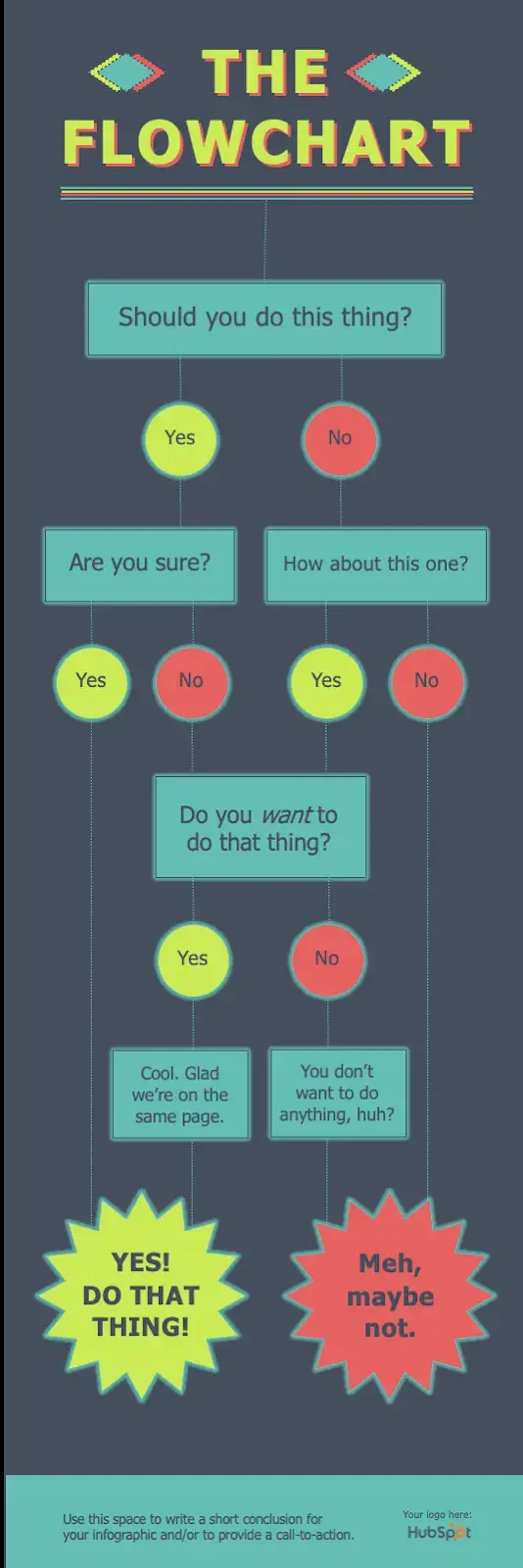
Flowchart Infographic Best Practices
- Draw out the branches beforehand. Before you dive into PowerPoint, get out a pen and paper and do a rough outline of your flowchart. Test for weaknesses in your logic by answering questions in every possible combination and seeing where you end up.
For best results, have a friend or coworker run through the flowchart, too.
- The smaller the scope, the easier the execution. The more questions or stages you add to your flowchart, the more difficult it will be to create (and the harder it will likely be for viewers to understand). So, try to narrow the focus of your flowchart.
What I like: Colors and shapes are strategically used to differentiate between positive and negative conclusions of the flow chart. Notice the green circles used for “Yes” and red circles used for “No”.
When to use: I suggest using flowcharts to map out different outcomes and conclusions to your audience to help them follow/understand processes and workflows.
5. Side-By-Side Comparison Infographic
We know sometimes you need an infographic to demonstrate a comparison. That’s why we created the side-by-side comparison infographic template to make it easy for you to compare and contrast two different things.
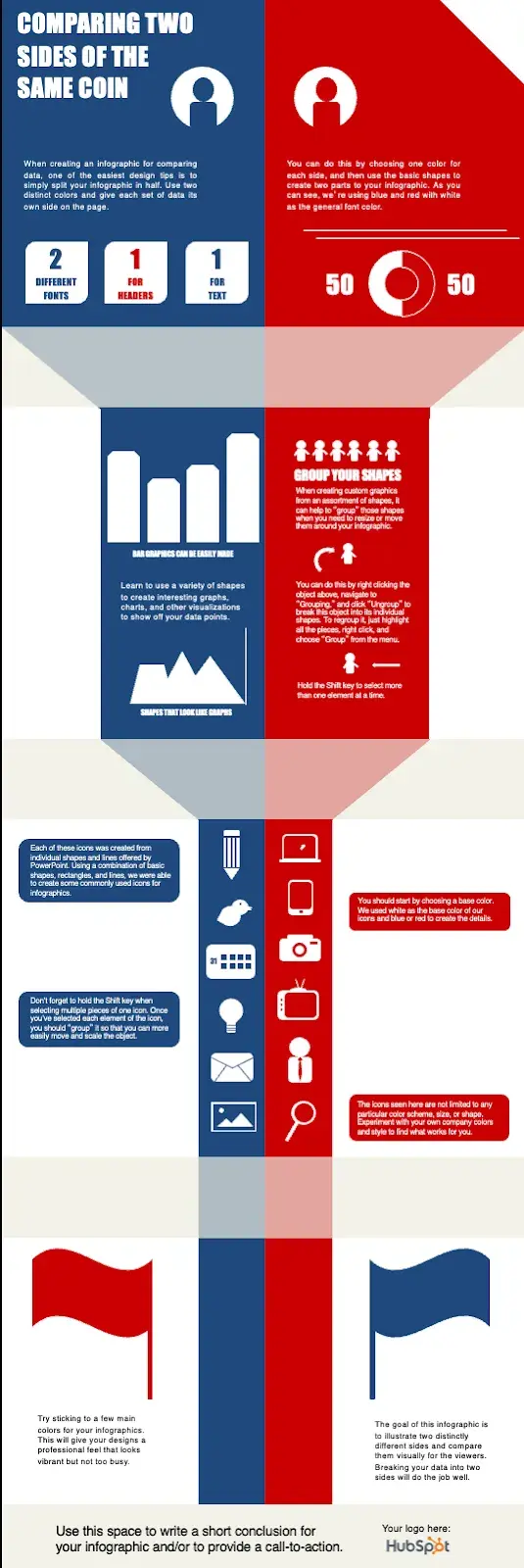
Side-By-Side Comparison Infographic Best Practices
- Use appropriate data. It’s best to use data that can easily be described in a chart. Use pie charts, graphs, or other data points to clearly and fairly compare and contrast.
- Use borders. Adding borders to your images will help make them feel like their part of a cohesive design. In PowerPoint, you can control the size, style, and color of borders under the Format Picture tab.
- Save your infographic as a PNG file. This is a best practice for all infographics but is particularly relevant when publishing an infographic that contains photographs. The PNG extension offers better quality than other options. To save your finished infographic as a PNG file, you simply need to choose File > Save As … and select PNG from the dropdown.
Ready to create your own side-by-side comparison infographic? Download 15 free infographic PowerPoint templates to get started.
What I like: Both sides of the infographic use complementary colors, which makes it even more appealing by inverting the color scheme in both sections.
When to use: This infographic template is great for comparing different categories, ideas, or results, and since you don‘t need to create or customize a lot of shapes, it’s a lot less work.
Make your slides speak louder than words.
PowerPoint is packed with so many features that help you present ideas in the best way possible. My advice? Always choose the right template. It’ll save you time and effort since you won’t have to build everything from scratch.
But if you prefer to start from zero, at least try to visualize your concept in your head or, even better, sketch it out on paper. This way, you won’t end up with cluttered slides that say a lot yet communicate nothing.
Remember: Nobody wants to sit through a presentation that looks like a bad Wikipedia page. PowerPoint infographics exist for a reason — to keep things smooth, snappy, and actually memorable.
So, if you’ve been pitching ideas or explaining strategies with just words and boring docs, it’s time for a change. Make it visual, make it engaging, and for the love of all things good — make it make sense.
Editor’s note: This article was originally published in March 2013 and has been updated for comprehensiveness.
![]()





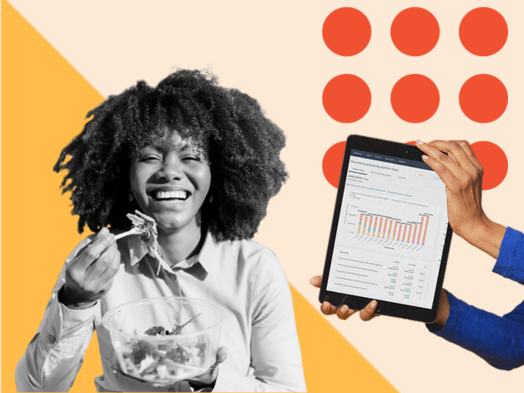



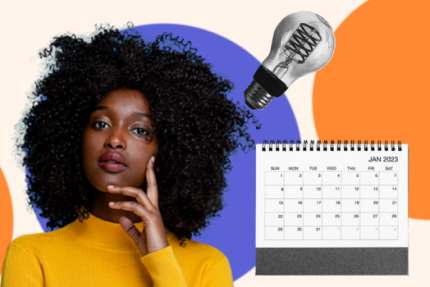







![Download Now: How To Build a Productivity System [Free Guide]](https://no-cache.hubspot.com/cta/default/53/fe02de00-28ec-4850-ba68-d3bac5ee585a.png)

![Download Now: 150+ Content Creation Templates [Free Kit]](https://web-stil.info/wp-content/uploads/2025/05/5478fa12-4cc3-4140-ba96-bc103eeb873e.png)
![Download Now: The Annual State of Artificial Intelligence in 2024 [Free Report]](https://no-cache.hubspot.com/cta/default/53/b72f2b25-8cc9-4642-9a1b-1e675d3d273b.png)
